Novatel Wireless NRM-EU860D Dual Band Licensed Modular Transmitter User Manual Part 2
Novatel Wireless, Inc. Dual Band Licensed Modular Transmitter Part 2
Contents
- 1. Part 1
- 2. Part 2
- 3. Manual 1
- 4. Manual 2
- 5. Manual 3
- 6. Manual 4
- 7. User Manual 1
- 8. User Manual 2
- 9. User Manual M1210
- 10. User Manual D430
- 11. User Manual D420
- 12. User Manual Corsica
- 13. User Manual Sapporo
- 14. User Manual Vostro 1
- 15. User Manual Vostro 2
- 16. Users Manual Vostro 3
- 17. Users Manual Vostro 4
- 18. User Manual 3
- 19. User Manual 4
- 20. User Manual Gilligan
Part 2

Proprietary & Confidential 121
Novatel Wireless Doc No. OM-01017857 Rev 1
Reject Cause 15
This feature, when enabled, will search ALL available RAT’s if a Reject Cause 15 is sent by the
network as the result of a cell selection. In the disabled state, the modem searches the same
RAT from which it received the Reject Cause 15 message. Disabled is the normal search used by
carriers other than CarrierX.
Name SearchAllRatsAfterRejectCause15Enable
States Enable, Disable
Devices U630, xU7x0, xU860/U870
FW Version U630 – Build 21 and above
xU7x0 – Build 30 and above
xU860/U870 – Build 7 and above
AT Command N/A
NV Item NW_NV_SRCH_RATS_REJECT_15_I

Proprietary & Confidential 122
Novatel Wireless Doc No. OM-01017857 Rev 1
N.A. CarrierZ
N.A. CarrierZ has mandated that Enhanced Network Selection (ENS) be enabled on all modems
delivered to N.A. CarrierZ. This feature should also be enabled for all OEM customers launching
on the N.A. CarrierZ network.
Enhanced Network Selection (ENS)
The N.A. CarrierZ network consists of different MNCs deployed in the various N.A. CarrierZ
markets and the Empire and Triton markets having a non-N.A. CarrierZ MNC. GSM network
selection procedures are an issue in that terminals perform their periodic higher priority PLMN
scans even when on a N.A. CarrierZ network in spite of the display indicating a N.A. CarrierZ
network. This causes customer issues when they travel from one N.A. CarrierZ market that uses
one MNC to another N.A. CarrierZ market, which uses a different MNC. Additionally, Empire and
Triton based customers are impacted more in that they are continuously in a roaming scenario on
the T-Mobile/Triton network and yet from a billing, service and customer care perspective they
are considered to be on the home N.A. CarrierZ network.
Name EnsEnable
States Enable, Disable
Devices xU7x0, xU860/U870
FW Version All
AT Command N/A
NV Item NV_ENS_ENABLED_I

Proprietary & Confidential 123
Novatel Wireless Doc No. OM-01017857 Rev 1
Factory Fulfillment
The following section details the features which relate to fulfillment of modems.
International Mobile Equipment Identity (IMEI)
The IMEI is a number unique to every GSM and UMTS mobile. It is found printed on the IMEI
label located on the modem.
The IMEI number can be used by the GSM network to identify valid or network approved devices
and is independent of the SIM.
The IMEI is a 15-digit number which includes information on the origin, model, and serial number
of the device. The model and origin comprise the initial 8-digit portion of the IMEI, known as the
Type Allocation Code (TAC). The remainder of the IMEI is manufacturer-defined, with a Luhn
check digit at the end (which is never transmitted).
As of 2004, the format of the IMEI is as follows: AA-BBBBBB-CCCCCC-D
where: AA – Reporting Body Identifier, indicating the GSMA – approved group that allocated the
modem TAC code BBBBB,
BBBBBB – TAC
CCCCCC – serial number of the modem model
D – Luhn check digit for the entire number
Name IMEI
States OEM customers will supply range corresponding to their GCF or PTCRB grant.
NVTL has its own IMEI for generic cards.
Devices U630, xU7x0, xU860/U870
FW Version All
AT Command AT+CGSN
NV Item NV_UE_IMEI_I

Proprietary & Confidential 124
Novatel Wireless Doc No. OM-01017857 Rev 1
E725 Provisioning with IOTA
This applies only to the E725. The EU860D & EU870D use SIM cards and don’t require any type
of IOTA.
Sprint PCS uses IOTA to perform their provisioning before a wireless device is allowed on the
data network. This process is operator specific so there maybe variations as to how provisioning
is done. In all cases, please contact the network operator if you have questions concerning
activation and subscriber related questions.
When using the PCI Express Mini Card, the activation is done by MobiLink™. MobiLink™ will
automatically detect if the E725 module needs to perform any provisioning on Sprint’s network.
If an E725 module does not use MobiLink, you must run IOTA from the primary port of the E725
module. Novatel Wireless has developed an embedded IOTA Client called, eIOTA that interfaces
through AT commands. This Client will allow the subscriber to execute an IOTA session to
provision the E725. Once this is done, the E725 can access the operator’s 1xRTT and 1xEVDO
networks.
For use with Sprint PCS, the subscriber first needs to contact a sales representative to activate
the E725. The Sprint PCS representative will present to the subscriber the MDN or MIN numbers
with the SPC. These parameters need to be entered into the E725 if it does not already exist.
Upon the time of receiving these parameters, Sprint PCS has a time provisioning requirement of
1.5 days to 2 days for the E725 to perform and complete an IOTA session. If the subscriber does
not complete the IOTA provisioning within this time, the subscriber will have to call Sprint PCS
again to reset the provisioning timer.
eIOTA
eIOTA is a subscriber unit provisioning Client, or Provisioning Service Agent. Embedded in the
CDMA wireless modem, the Client communicates with Handset Configuration Manager, the
operator’s IOTA server, to download provisioning data to the subscriber unit or upload settings
per server's request. It allows the operator to remotely perform provisioning without having to
bring the wireless device into a sales location.
eIOTA is disabled by default from the factory. This is done because if eIOTA was active, it would
automatically attempt an eIOTA session if the E725 has not already completed provisioning.
When the subscriber finishes entering the MDN or MIN, they could either enable eIOTA and have
the E725 automatically attempt an IOTA session after a power cycle or initiate a manual IOTA
session.
Enabling, disabling, and starting eIOTA
eIOTA Client can be enabled or disabled by issuing the AT commands:
To enable: AT+IOTA=1
To disable: AT+IOTA=0
To force start: AT+IOTA=2
There are two ways to start eIOTA, NIIP(Network Initiated Initial Provisioning) or CIIP(Client
Initiated Initial Provisioning). In NIIP, operator’s IOTA server pushes a special SMS message to
the Client to trigger an IOTA session. In CIIP, a session can be triggered by locally issuing an AT
command: AT+IOTA=2.

Proprietary & Confidential 125
Novatel Wireless Doc No. OM-01017857 Rev 1
Checking eIOTA status
The AT command: AT+IOTA=? Is used to query the eIOTA status while IOTA is active.
Please refer to AT+IOTA in the AT Commands Chapter for details.
Cautions that need to be taken when eIOTA is active
DO NOT power off the unit until IOTA session is finished.
DO NOT remove the antenna from the unit.
DO NOT disconnect the data call issued by eIOTA.
When running eIOTA, to ensure no power lost, make sure to use the AC power and NOT the
battery power.
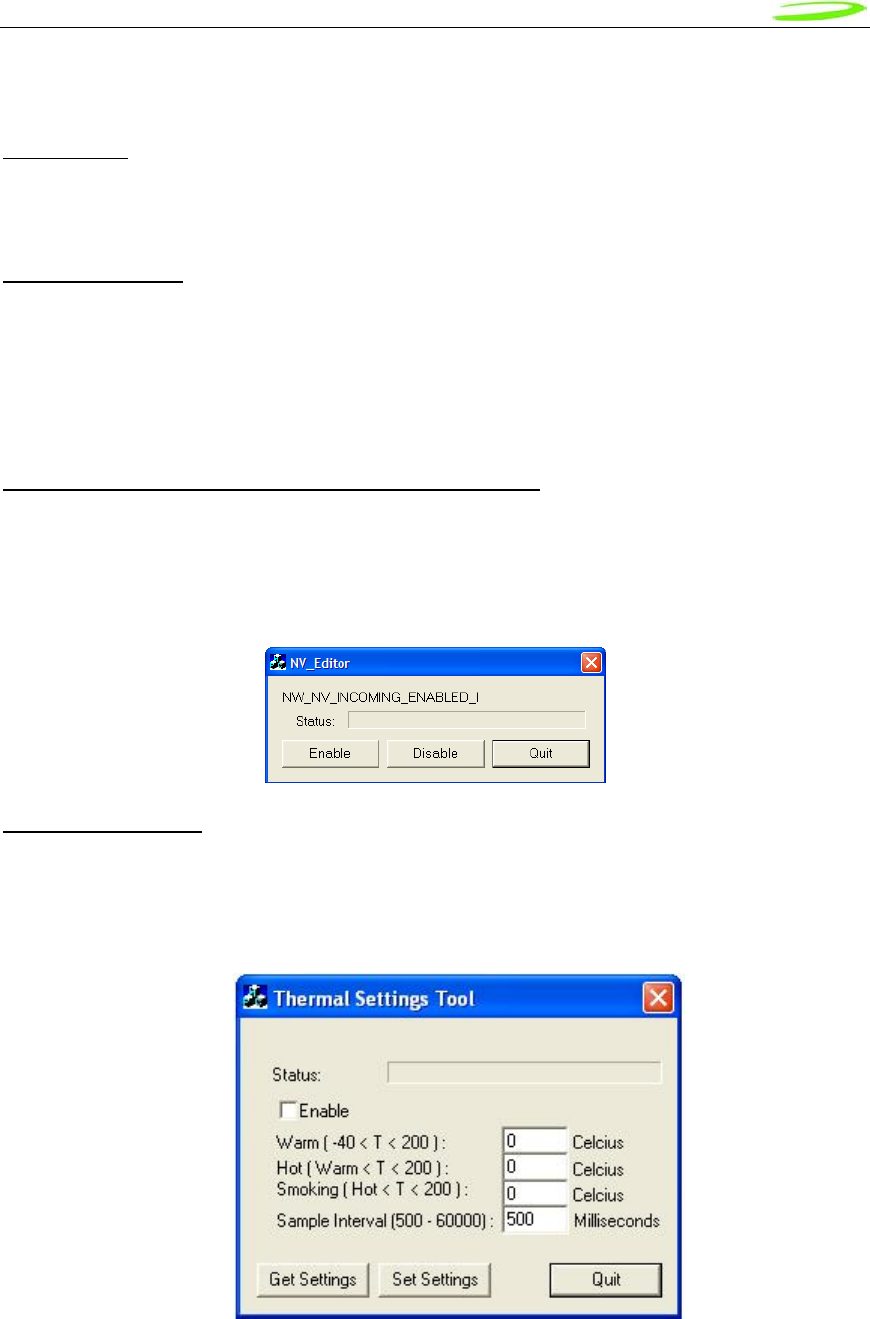
Proprietary & Confidential 126
Novatel Wireless Doc No. OM-01017857 Rev 1
Appendix B - Development Tools & Procedures
Introduction
This appendix contains identification and introductory guidance on development tools used in the
validation, certification and compliance testing of the Novatel Wireless PCI Express Mini-cards
Satimo Chamber
Novatel Wireless has the in-house ability* to test TRP/TIS on host devices integrating the Novatel
Wireless PCI Express Mini card. It is of great value to pre-scan the integrated device for both
development and meeting carrier TRP/TIS requirements. Please contact Novatel Wireless for
further information.
* Sept 2006
HSDPA: Set Mini card to Circuit Switch (CS) Mode
In order to assist in the execution of FCC/CE testing Novatel Wireless has developed an
executable that will force the EU860D/EU870D into CS mode of operation. This tool allows for
configuring a manual mobile originated/terminated GSM circuit switched voice call on the Novatel
Wireless EU8X0 modem in a test lab environment. Please contact Novatel Wireless for further
information.
Thermal Limit Tool
The Thermal Limit Tool is used for the purpose of enabling/disabling, or modifying, the thermal
shutdown settings of the EU8X0 modem.
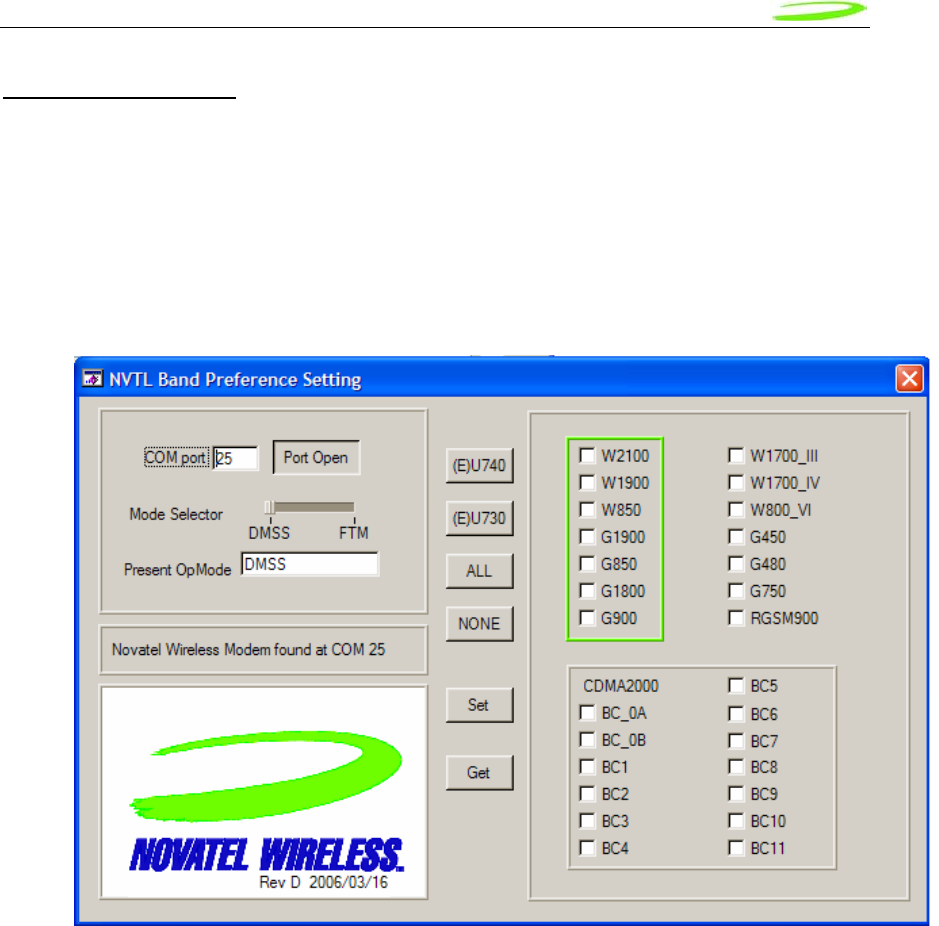
Proprietary & Confidential 127
Novatel Wireless Doc No. OM-01017857 Rev 1
Band Preference Tool
The band preference tool enables or disables specific bands on the Novatel Wireless EU8X0
modem in a test lab environment.
When executing conducted RF tests the PCI Express Mini card can also receive over the air
signaling from commercial networks. The PCI Express Mini card may try to connect to these
commercial networks (depending on the modem configuration) and not connect to the intended
conducted band. This tool allows the disabling of specific bands.
Band Preference Application Tool Box
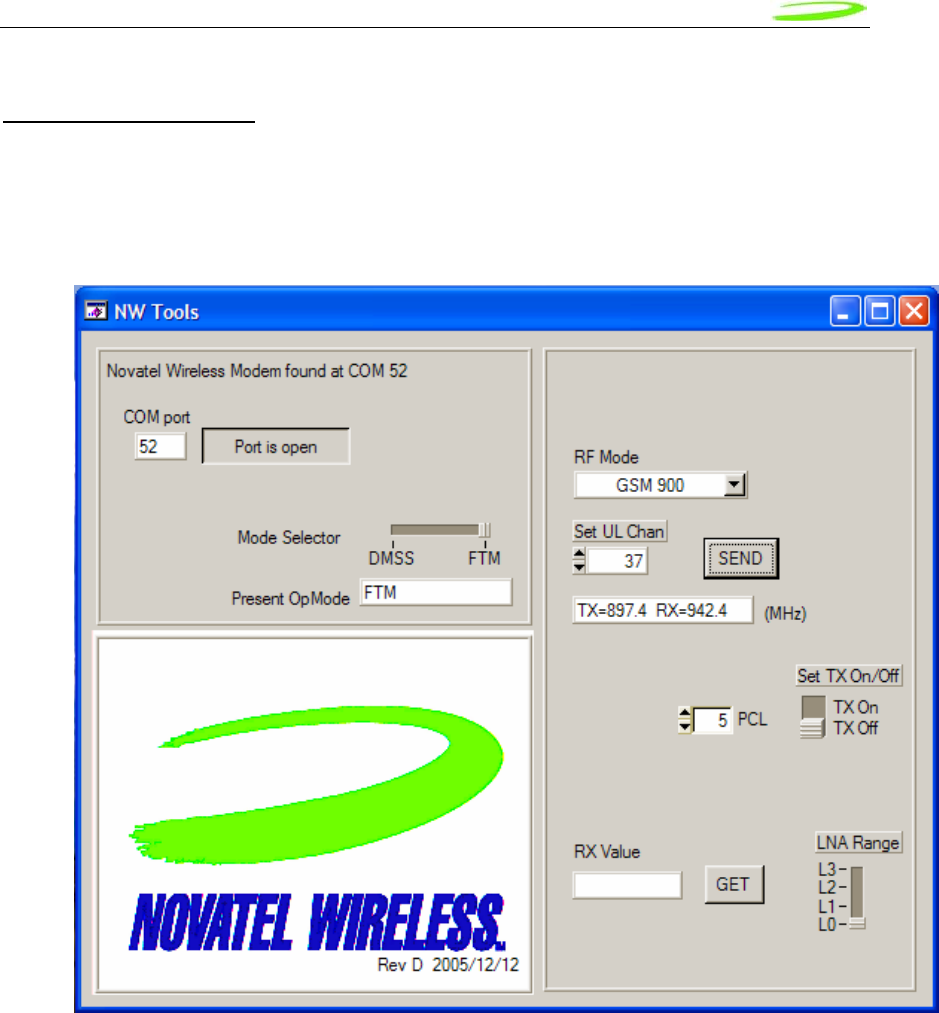
Proprietary & Confidential 128
Novatel Wireless Doc No. OM-01017857 Rev 1
HSDPA: RF Application
The RF Application and procedure provides the instructions of how to set up and use the Novatel
Wireless RF application tool for the purpose of performing TX and RX lab environment tests on
the Novatel Wireless EU8X0 HSDPA modem.
Figure 1 – NW RF Application Tool Box

Proprietary & Confidential 129
Novatel Wireless Doc No. OM-01017857 Rev 1
EVDO RF Application
In order to assist in the execution of FCC testing Novatel Wireless has developed a test setup
application that is used to configure the E725 for FCC testing. Please contact Novatel Wireless
for father information.

Proprietary & Confidential 130
Novatel Wireless Doc No. OM-01017857 Rev 1
Appendix C - Regulatory Approval and Compliance
As both the EU860D and EU870D support four bands of GPRS operation, including North
American and European bands, both products are covered by regulatory requirements of North
America and Europe. Both products will have FCC, PTCRB, CE and GCF certification.
The E725, as a CDMA product in North America requires FCC certification.
FCC (Federal Communication Commission)
The E725, EU870D and EU860D products conform to the requirements of applicable American
laws with respect to safety; health, environment and consumer protection.
This E725, EU870D and EU860D will comply, per applicable band, with the following parts of the
Federal Communication Commission’s (FCC) Code of Federal Regulations (CFR):
FCC CFR47 Part 2 (General Rules and Regulations, RF Exposure Evaluation)
FCC CFR47 Part 15 (All Radio Frequency Devices)
FCC CFR47 Part 24 (Narrow and wideband PCS modules)
FCC CFR47 Part 22 (Cellular Service)
A FCC grant shall be obtained in order to demonstrate compliance.

Proprietary & Confidential 131
Novatel Wireless Doc No. OM-01017857 Rev 1
CE (Conformance European)
The EU870D and EU860D products comply with the essential requirements of the applicable
European laws and directives with respect to safety; health, environment and consumer
protection. The products conform to the essential requirements of the R&TTE (Radio and
Telecommunications Terminal Equipment) Directive, 1999/5/EC, and have the CE mark affixed.
The applicable sections of the following standards have been used to demonstrate compliance to
this requirement. The EU860D and EU870D products will comply with the 3GPP standards TS
51.010 for GSM and TS 34.121 for WCDMA.
R&TTE
R&TTE
Requirement Discipline Definition Applied Standard
Article 3.1(a) Health Safety Testing
(flammability, etc…) ICNIRP 19985 European Council
Rec.1999/519 EC
Article 3.1(a) Safety IEC 60950-16
EN 301 489-017
EN 301 489-078
Article 3.1(b) EMC EMC testing
(unintentional radiators,
etc.…)
EN 301 489-249
EN 301 51110
EN 301 908-111
Article 3.2 Spectrum Network Testing (power,
frequency stability, etc…)
EN 301 908-212
5 International Commission on Non-Ionizing Radiation Protection
6 Safety of Information Technology Equipment
7Electromagnetic compatibility and Radio Spectrum Matters (ERM) ElectroMagnetic Compatibility
( EMC) standard for radio equipment and services
Part 1: Common Technical requirements
8Electromagnetic compatibility and Radio Spectrum Matters (ERM) ElectroMagnetic Compatibility
( EMC) standard for radio equipment and services
Part 7: Specific conditions for mobile and portable radio and ancillary equipment of digital cellular
radio telecommunications systems ( GSM and DCS)
9 Electromagnetic compatibility and Radio Spectrum Matters (ERM) ElectroMagnetic
Compatibility ( EMC) standard for radio equipment and services
Part 24: Specific conditions for IMT-2000 CDMA Direct Spread (URTA) for Mobile and portable
radio and ancillary equipment.
10Global System for Mobile communications (GSM):
Harmonized EN for mobile stations in the GSM 900 and GSM1800 bands covering essential
requirements under article 3.2 of the R&TTE directive
11Electromagnetic compatibility and Radio Spectrum Matters (ERM) Base Stations (BS) and User
Equipment (UE) for IMT-2000 Third-Generation cellular networks.
12 Electromagnetic compatibility and Radio Spectrum Matters (ERM) Base Stations (BS) and User
Equipment (UE) for IMT-2000 Third-Generation cellular networks.
Part 2: Harmonized EN for IMT-2000,

Proprietary & Confidential 132
Novatel Wireless Doc No. OM-01017857 Rev 1
The EU860D and EU870D products will comply with the applicable GSM/GPRS European
Regional Regulatory Requirements as per the following table.
GSM/GPRS European Regulations
GSM 11.10 /
TS 51.010
Requirement Description EU /
R&TTE
Directive
12.1.1 Conducted spurious emissions - MS allocated a channel Yes
12.1.2 Conducted spurious emissions - MS in idle mode Yes
12.2.1 Radiated spurious emissions - MS allocated a channel Yes
12.2.2 Radiated spurious emissions - MS in idle mode Yes
13.1 Transmitter – Frequency error and phase error Yes
13.2 Transmitter – Frequency error under multipath and interference conditions Yes
13.3-1 Transmitter output power and burst timing - MS with permanent antenna
connector Yes
13.4 Transmitter - Output RF spectrum Yes
13.6 Transmitter – Frequency error and phase error in HSCSD multislot
configuration Yes
13.7 Transmitter output power and burst timing in HSCSD configurations Yes
13.8 Transmitter, Output RF spectrum in HSCSD multislot configuration Yes
13.16.1 Frequency error and phase error in GPRS multislot configuration Yes
13.16.2 Transmitter output power in GPRS multislot configuration Yes
13.16.3 Output RF spectrum in GPRS multislot configuration Yes
13.17.1 Frequency error and Modulation accuracy in EGPRS Configuration Yes
13.17.2 Frequency error under multipath and interference conditions in EGPRS
Configuration Yes
13.17.3-1 EGPRS Transmitter output power- MS with permanent antenna connector Yes
13.17.4 Output RF spectrum in EGPRS Configuration Yes
14.7.1 Blocking and spurious response - speech channels Yes
14.18.5 Blocking and spurious response in EGPRS Configuration Yes
CDMA Direct Spread (UTRA FDD) (UE) covering essential requirements of article 3.2 of the
R&TTE Directive

Proprietary & Confidential 133
Novatel Wireless Doc No. OM-01017857 Rev 1
GCF (Global Certification Forum)
The EU870D product will be tested to and meet the GCF CC (Certification Criteria) requirements
in order to comply with Regional Regulatory Requirements.
Novatel Wireless will provide a full GCF declaration for the EU870D including GCF-AP Annex C,
D, E and F based on GCF-CC.
GCF Version Compliance13
Commercial Release
• Release 4.0E Patch 3 GCF 3.22
Post Commercial Upgrade
• Release 4.0E Patch 4 GCF 3.23
13 Targeted Firmware release and GCF Compliance versions are subject to change without
notice. Please contact Novatel Wireless for actual Firmware release and GCF compliance
version

Proprietary & Confidential 134
Novatel Wireless Doc No. OM-01017857 Rev 1
PTCRB (PCS Type Certification Review Board)
The EU860D product will be compliant to PTCRB.
PTCRB Version Compliance14
Commercial Release
• Release 4.0E Patch 3 PTCRB 3.7.1
Post Commercial Upgrade
• Release 4.0E Patch 4 PTCRB 3.9.1
14 Targeted Firmware release and PTCRB Compliance versions are subject to change without
notice. Please contact Novatel Wireless for actual Firmware release and PTCRB compliance
version

Proprietary & Confidential 135
Novatel Wireless Doc No. OM-01017857 Rev 1
Appendix D - Carrier Accreditation and Infrastructure
IOT
Carrier Accreditation
Contact Novatel Wireless for further information and details on Carrier Accreditation.
Infrastructure IOT
Novatel Wireless works with the carriers and infrastructure vendors to complete Interoperability
testing with the PCI Express Mini Card in either lead host devices or in stand alone testing.
Contact Novatel Wireless for further information and details on Carrier Accreditation.
.
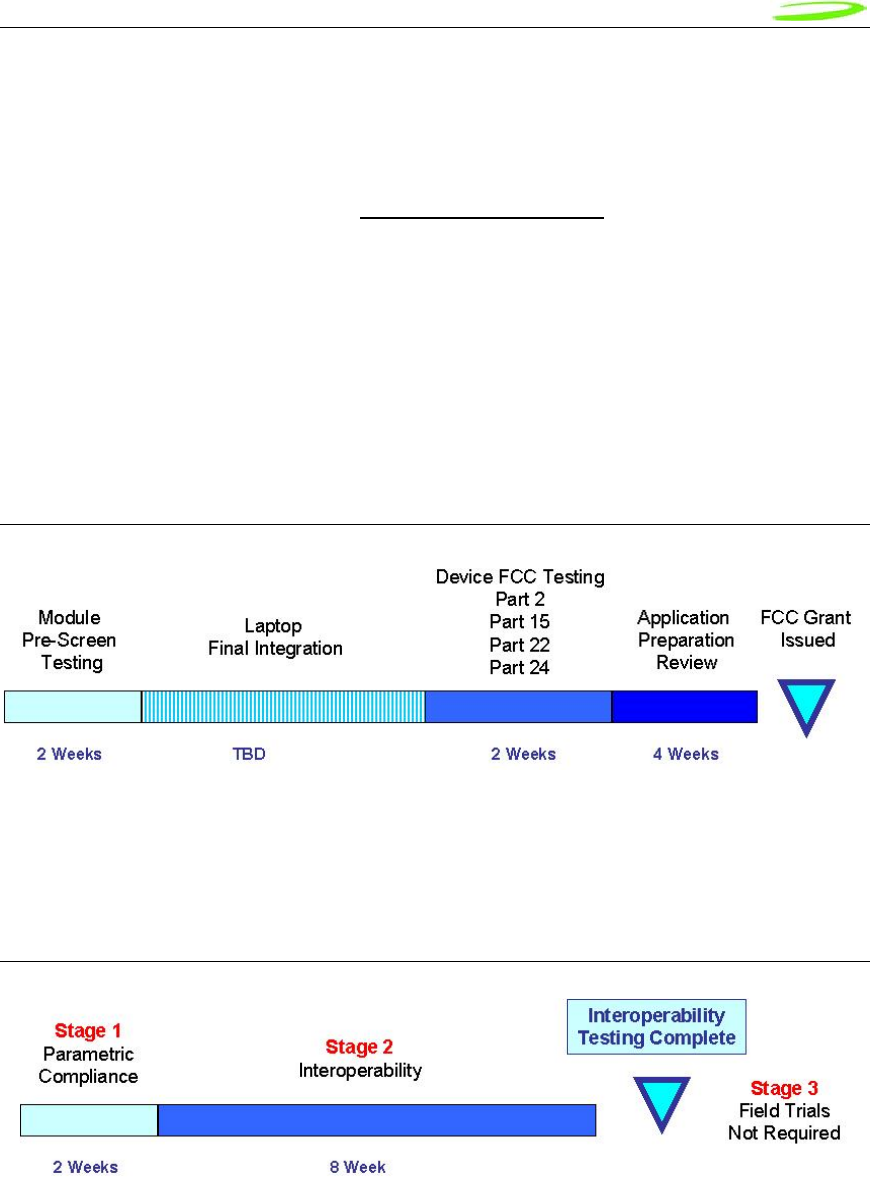
Proprietary & Confidential 136
Novatel Wireless Doc No. OM-01017857 Rev 1
Estimated Timelines for Compliance & Certification
Disclaimer
The Estimated Timelines is provided for informational purposes only. Novatel Wireless is
providing the Information because it may be useful. The Information is provided solely on the
basis that you will be responsible for making your own assessments of the information and are
advised to verify all representations, statements and information before using or relying upon any
of the Information. Although Novatel Wireless believes it has exercised reasonable care in
providing the Information, Novatel Wireless does not warrant the accuracy of the information and
is not responsible for any damages arising from the use of or reliance upon the information.
Novatel Wireless in no way represents that Novatel Wireless is providing the information in
accordance with any standard or service (routine, customary or otherwise) related to the
consulting, services, hardware or software industries.
EV-DO FCC Accreditation
EV-DO CDG Interoperability
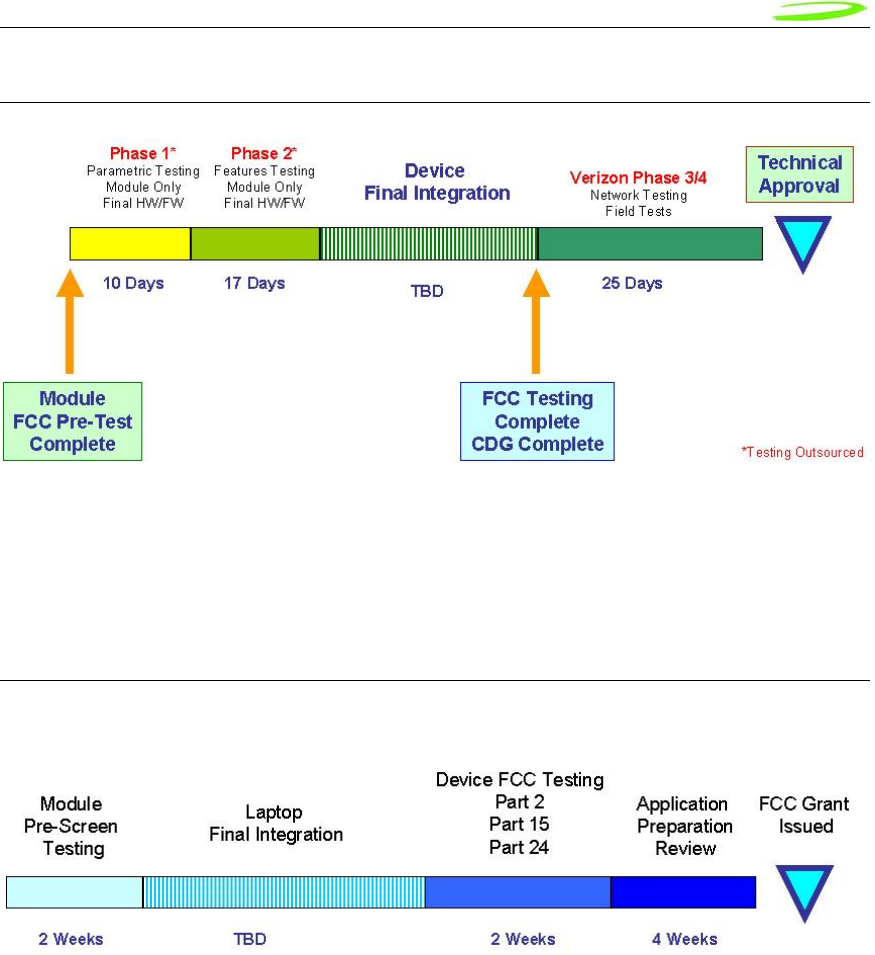
Proprietary & Confidential 137
Novatel Wireless Doc No. OM-01017857 Rev 1
EV-DO Verizon Certification Process
HDSPA FCC Accreditation
HDSPA FCC Accreditation takes approximately 4 weeks until an FCC grant is issued.
Notes:
Hardware should be near final, any changes after a module pre-screen are handled as either
a Class I or Class II permissive change, depending on their scope.
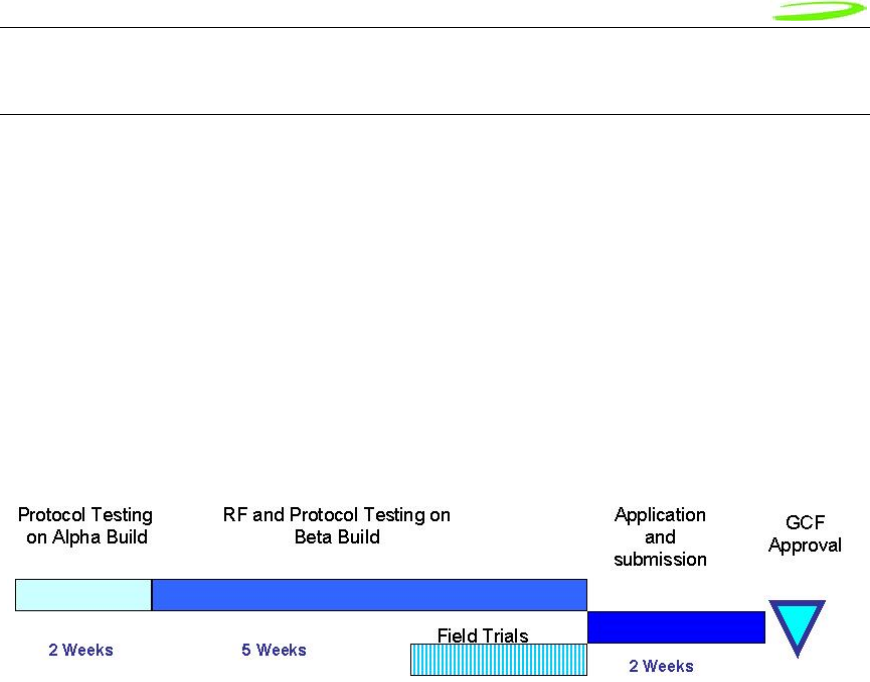
Proprietary & Confidential 138
Novatel Wireless Doc No. OM-01017857 Rev 1
GCF Compliance Process
The EU870D product will be tested for compliance to GCF as per the applicable GCF test
criterion at the time of testing. Novatel Wireless is a current member of the GCF (Global
Certification Forum). GCF quarterly meetings are attended in order to keep appraised of new
procedures, policies and technical requirements associated with GCF terminal certification.
GCF certification is very powerful. Because it provides for parametric as well as protocol and
field test plans, certification under this body can be highly leveraged to gain accreditation on
carrier networks. For North American, PTCRB provides similar coverage to GCF. As such,
results from either GCF or PTCRB can be leveraged to one another.
Typically 9 weeks until GCF Approval.
Spurious Emissions is required on the host laptop/handheld to achieve compliance on the
integrated system.
Notes:
GCF provides a framework to have devices accepted by most carriers in Europe.
There is a large amount of overlap with PTCRB (North American equivalent). Results from
PTCRB can be leveraged for GCF and vice versa.
Unlike PTCRB, this is voluntary. However, it is required by Vodafone.
It includes RF performance, emissions, protocol and field performance test cases. It is a kin
to the CDG Stage 1, Stage 2, & Stage 3 recommendations for CDMA.
Requires mandatory testing in at least 5 networks.
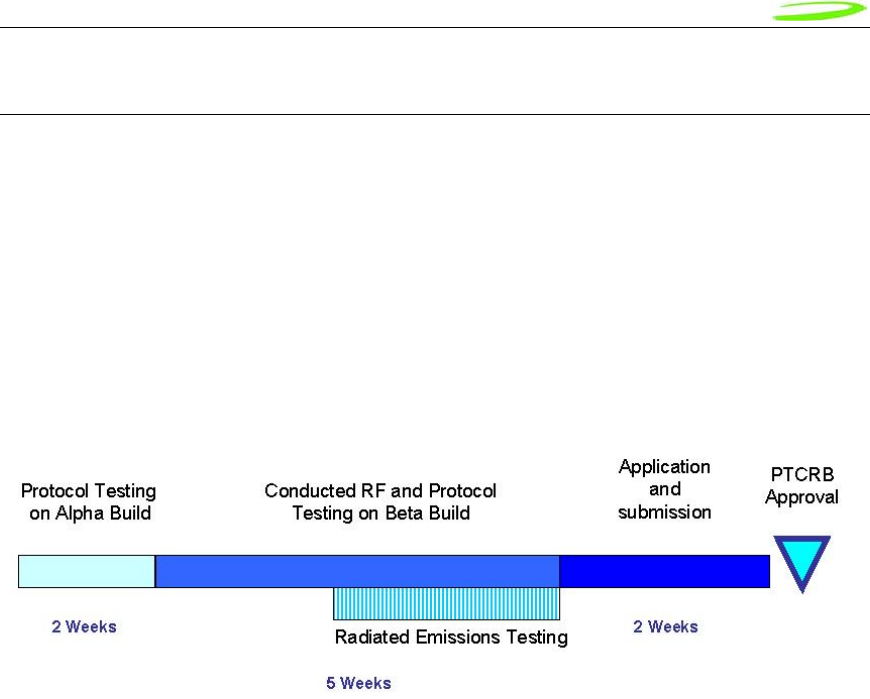
Proprietary & Confidential 139
Novatel Wireless Doc No. OM-01017857 Rev 1
PTCRB Compliance Process
The EU860D product will be tested for compliance to PTCRB as per the applicable PTCRB test
criterion at the time of testing.
North America – PTCRB (PCS Type Certification Review Board)
Novatel Wireless is a current Member of the PTCRB (PCS Type Certification Review Board).
PTCRB quarterly meetings are attended in order to keep appraised of new policies, procedures
and technical requirements associated with GCF terminal certification. Novatel Wireless has
attained PTCRB approval with several product offerings.
Spurious Emissions & SIM electrical is required on the host laptop/handheld to achieve
compliance on the integrated system.
Notes:
North American equivalent of GCF.
This a group comprised of both Operators and Manufacturers.
The radiated emission testing is similar to the FCC requirements but not entirely identical.
This is mandatory in North America to operate GSM devices in the PCS band. There are
approximately 1,200 test cases.
Any changes (MMI, RF, Baseband, etc…), no matter how insignificant which occur after
certification, are to be reported to the PTCRB for review.
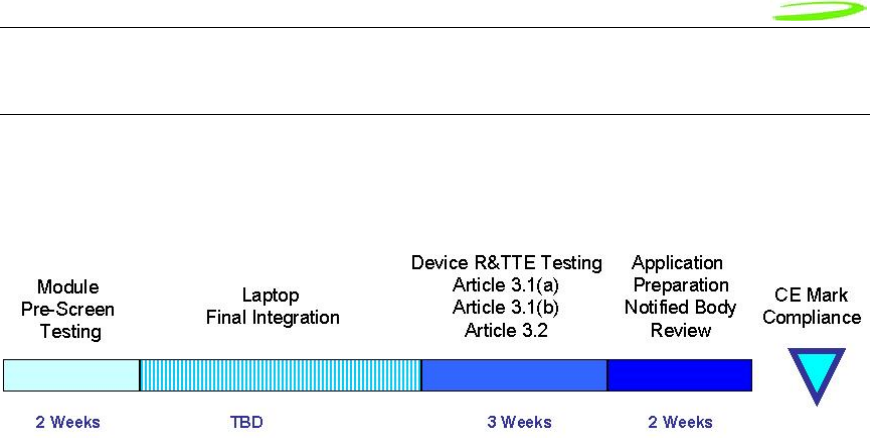
Proprietary & Confidential 140
Novatel Wireless Doc No. OM-01017857 Rev 1
CE Mark Certification Process
The CE Mark Certification process takes approximately 7 weeks until CE Mark Compliance is
complete.
Notes:
Module hardware should be final at module pre-screen. However, modifications are self
policed and are less restrictive than FCC permissive change policies.
R&TTE governs the CE initiative.
Article Definition
Article 3.1 (a) – Safety Testing (flammability, etc…)
Article 3.1 (b) – EMC testing (unintentional radiators, etc.…)
Article 3.2 – Network Testing (power, frequency stability, etc…)
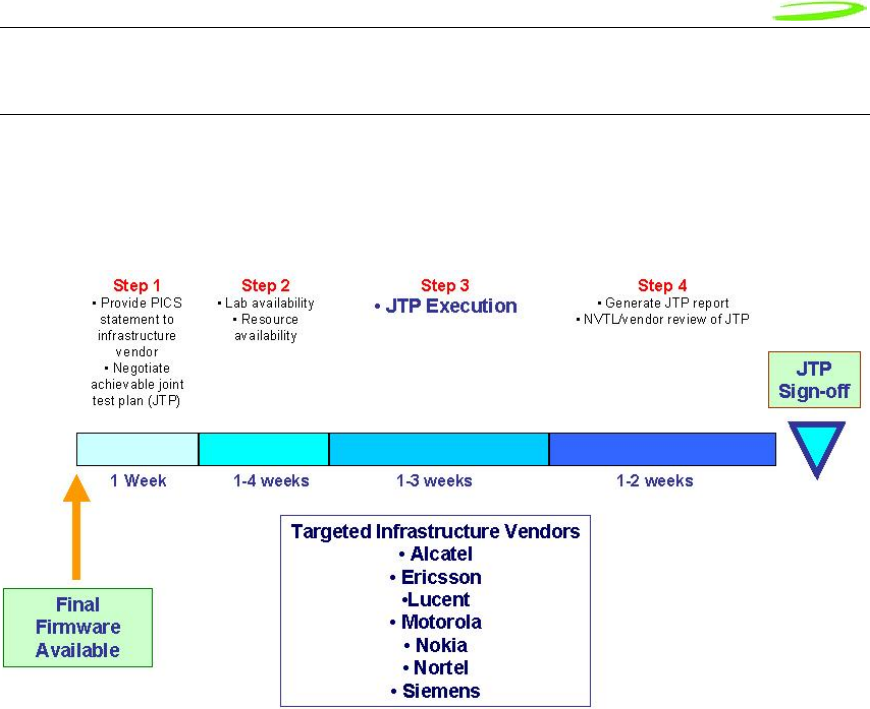
Proprietary & Confidential 141
Novatel Wireless Doc No. OM-01017857 Rev 1
Infrastructure IOT Process
A Protocol Implementation Control Statement (PICS) statement will be provided outlining the
protocol supported in Qualcomm™’s stack as integrated into EU860D and EU870D code release.
This will be used to plan IOT test cases.
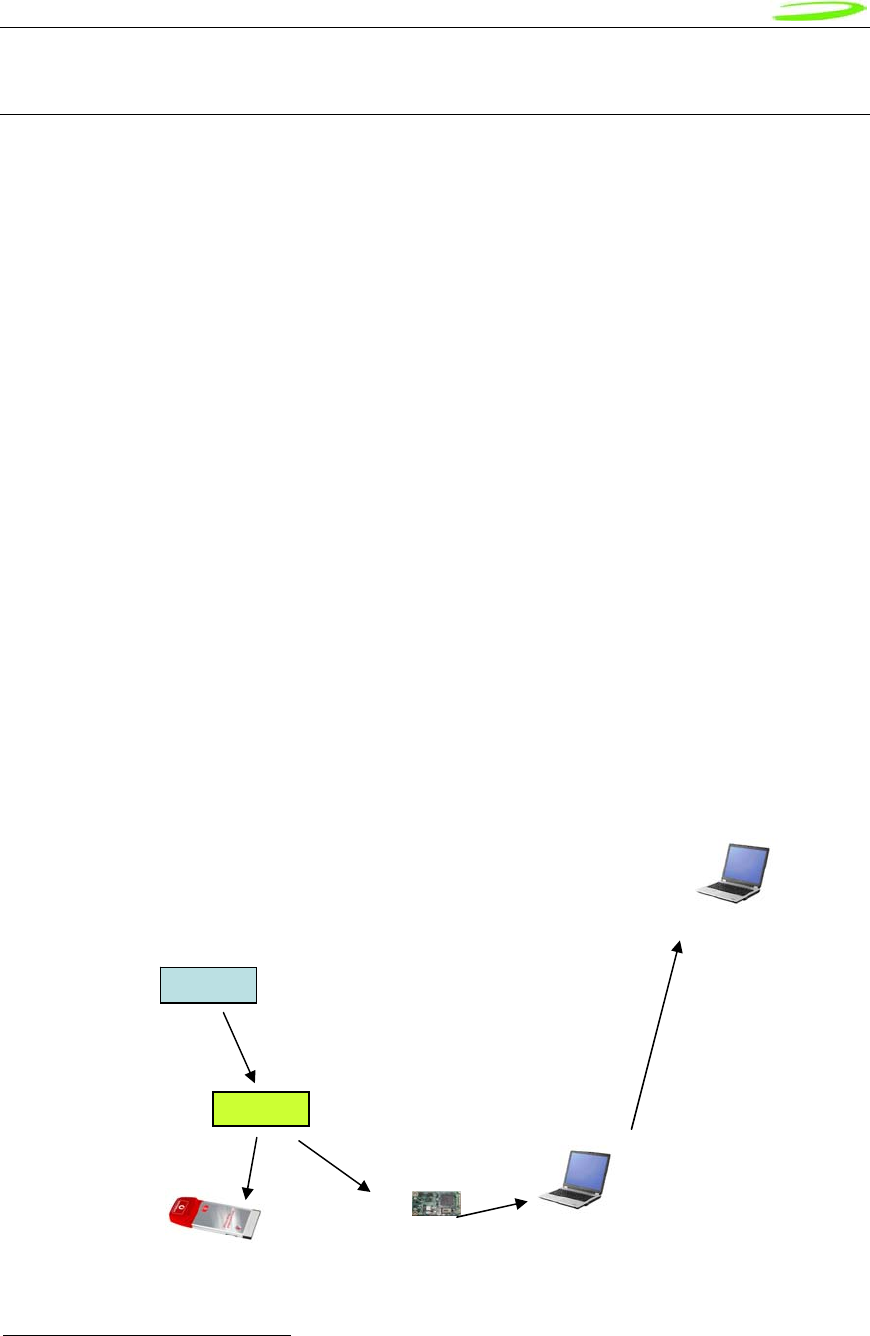
Proprietary & Confidential 142
Novatel Wireless Doc No. OM-01017857 Rev 1
Carrier Accreditation Process
The typical Carrier Accreditation roadmap is shown in the two example diagrams N.A. HSDPA
Carrier Accreditation and European HSDPA Carrier Accreditation.
Novatel Wireless works with the carriers and infrastructure vendors to complete Accreditation
Testing with the PCI Express Mini Card in either a lead device (such as a PC card or Express
card), a lead host laptop or in stand alone testing.
With the mini card or PC card validated on the network the carrier looks to the host
laptop/handheld integrator to complete incremental GCF or PTCRB testing on the
laptop/handheld.
Novatel attains GCF or PTCRB on the core PCI Express Mini-card which is the bulk of the testing
and test cases. Typically the incremental GCF or PTCRB testing on the integrated system
consists of SIM Electrical 15 and Spurious Emissions.
Host integrator completes TRP/TIS measurements. These results are required to be
compliant to carrier’s TRP/TIS requirements. In some cases the carrier will have additional
requirements specific to the carrier such as incremental SAR testing.
The Carrier will require several laptops/handhelds configured with the PCI Express Mini
Card to evaluate in additional to requiring PTCRB/GCF compliance and TRP/TIS test results.
Contact Novatel Wireless for further information and details on carrier accreditation.
15 SIM Electrical testing optional for GCF
Europe HSDPA Carrier Accreditation
Qualcomm
Stack
Novatel
FW
GCF (i.e. GCF 3.22)
QM S/W
Novatel
Module
Carrier Accreditation
NW F/W
Spurious Emissions (R&TTE)
TRP/TIS
VF SAR
CE
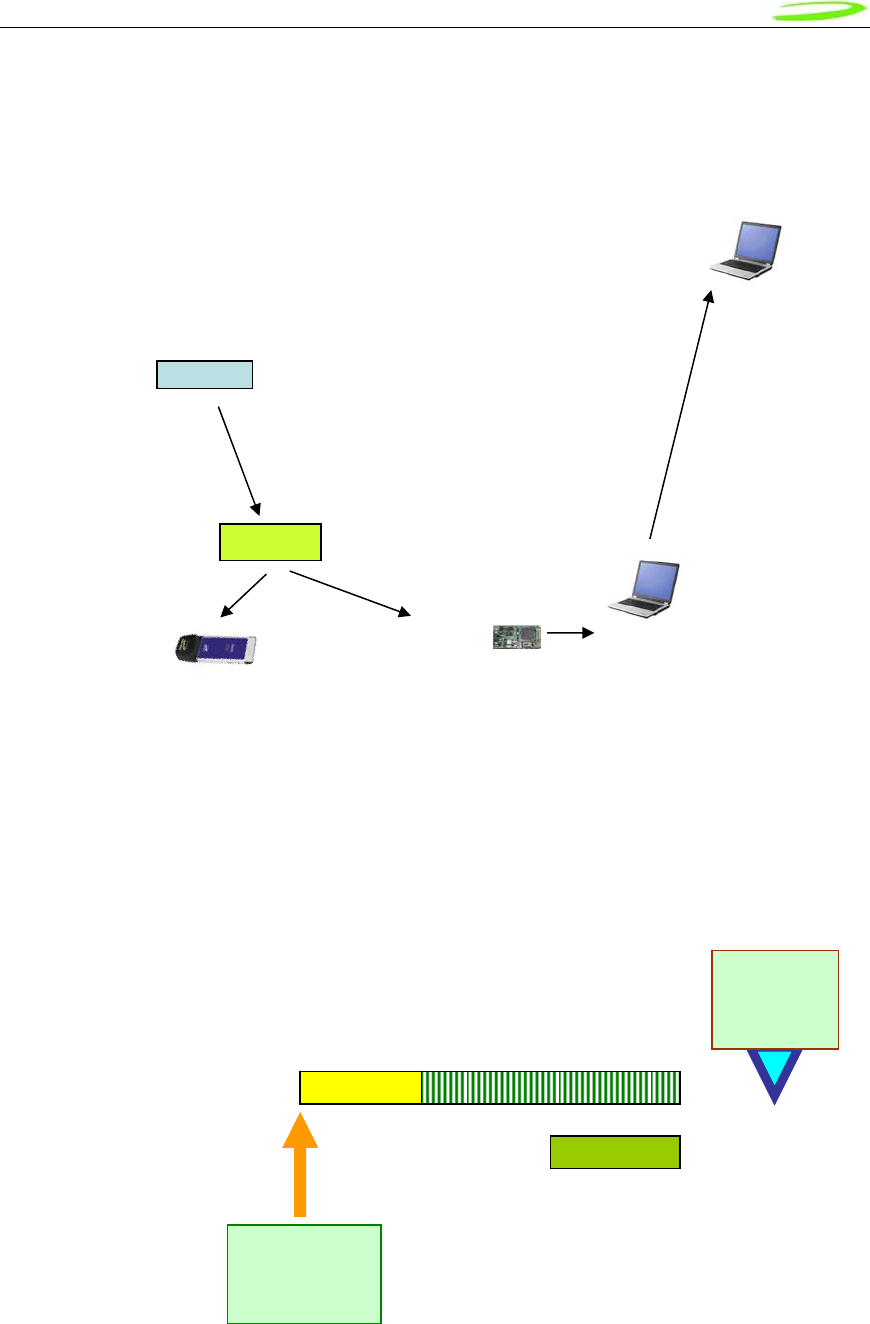
Proprietary & Confidential 143
Novatel Wireless Doc No. OM-01017857 Rev 1
N.A. HSDPA Carrier Accreditation
QM S/W
Qualcomm
Stack
Novatel
FW
PTCRB
(i.e. PTCRB 3.7.1)
NW F/W
Novatel
PC Card
Carrier Accreditation
Novatel
Module
CHIP
TRP/TIS
FCC
SIM Electrical
Spurious Emissions
Carrier Certification Process
Step 2/3
• Detailed accreditation test plan
executed
• User trial executed
Hardware &
Firmware
Approval
1-5 months 1-2 weeks
Step 1
• Initial test
lab sanity
check
1-2 months
Laptop / Handheld
Evaluation
Semi-Final
Hardware &
Firmware
Available
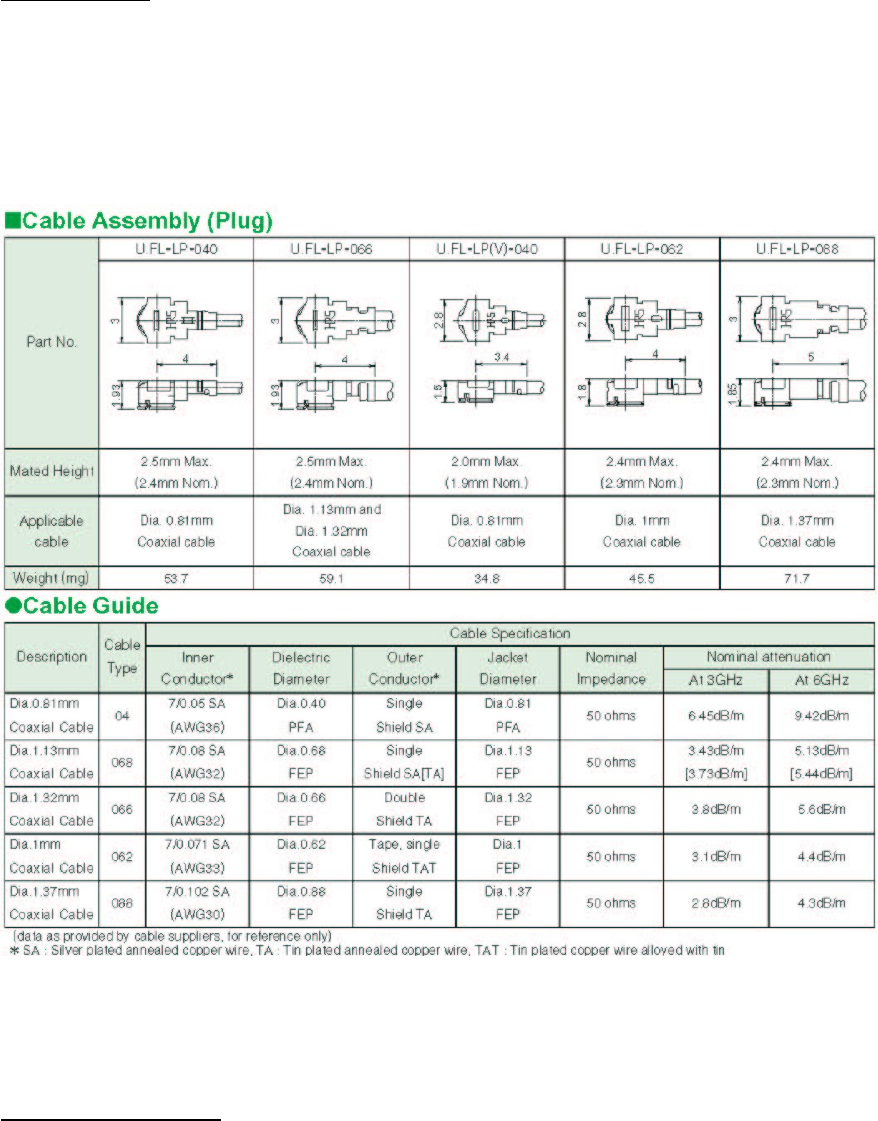
Novatel Wireless Doc No. OM-01017857 Rev 1
Appendix E - Reference Parts Specifications
RF Connector
Hirose U.FL series, with U.FL-R-SMT receptacle mating to the following connectors illustrated.
Note that . This connector is designed for a limited number of insertions. For an embedded
application this is expected to be acceptable.
Figure 49: RF Connector
Mini Card Connector
Molex 67910 series, mates with the mini PCI Express Card. Use with Latch 48099-0003.
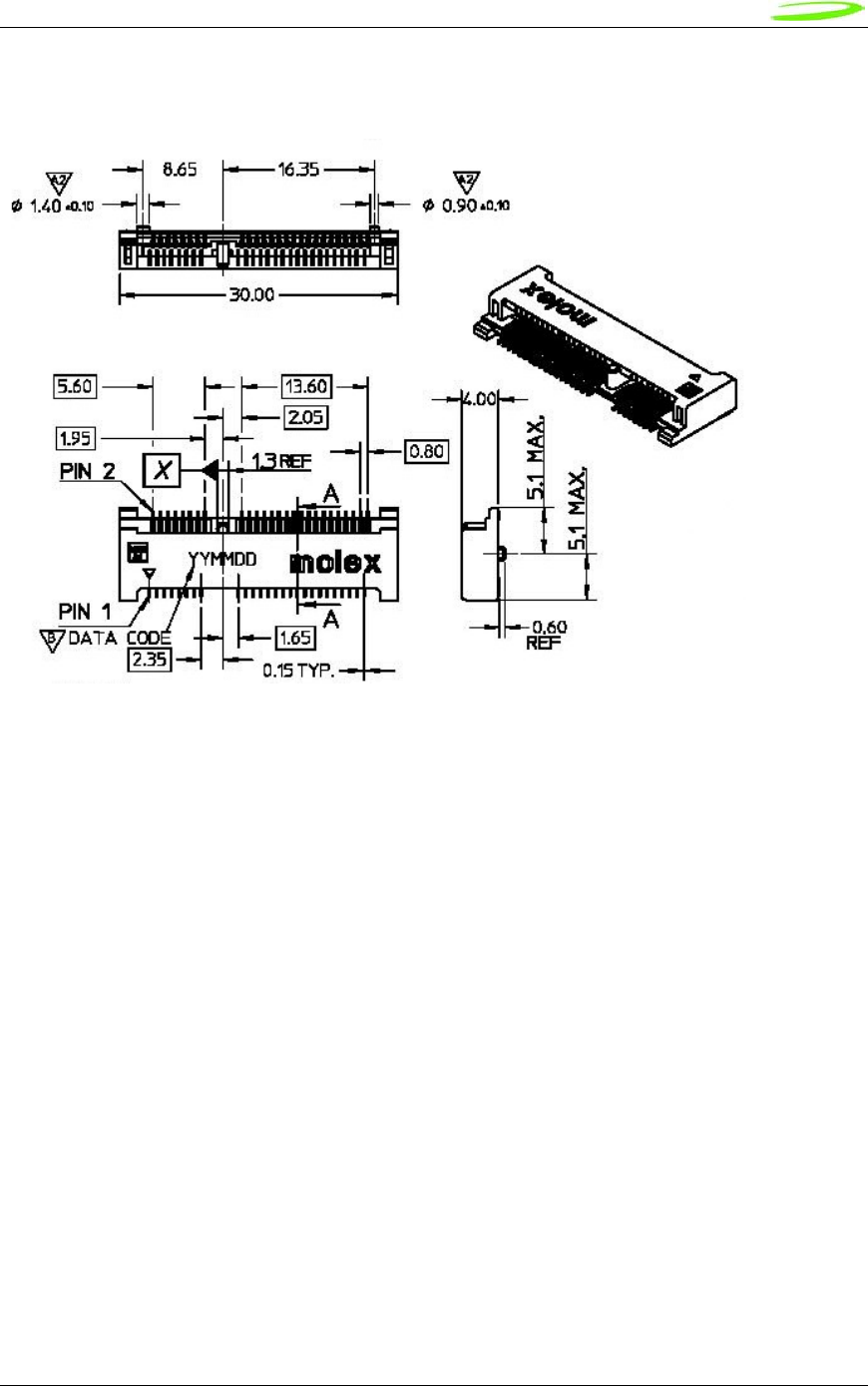
145
Novatel Wireless Confidential & Proprietary Information
Revision 1
Figure 50: Mini PCI Express Connector

146
Novatel Wireless Confidential & Proprietary Information
Revision 1
Appendix G - Phoenix API Interface to PCI Express Mini
Card
Overview
This is the Phoenix API Command Set Reference for the Novatel Wireless CDMA Modem
product. This document describes the modem API used by host applications running on Windows
2000, and Windows XP.
The SDK provides universal API support for both 1XEV-DO and HSDPA mini-cards. This
provides interfaces through the Windows XP and Windows 2000 operating systems. It includes
API support as well as sample code to provide for ease of application development.
Phoenix is the brains of the SDK. Phoenix maintains a single state machine that all Clients
communicate with. Anything and everything involving communication to the device takes places
through the Phoenix server. Implemented as a Document/View executable supporting
automation, the Phoenix server automatically keeps a count of how many Clients are attached to
it via COM interfacing. The server is initialized automatically once the first Client is instantiated
and shut down once the last Client instance is terminated. With the beauty of OLE Automation,
the Phoenix server can be utilized using many different programming languages, including C++,
MFC, JavaScript, VBScript, etc. Refer to Phoenix.chm for API documentation. If you want to
use Phoenix in Visual Studio, import the type library Phoenix.tlb and create a wrapper class for it.
Blaze ActiveX control helps Client applications to receive events fired by the Phoenix server.
This allows for simple 2-way communication, replacing redundant loop checking used in the past.
Refer to Blaze.chm for API documentation. If you want to use Blaze ActiveX control in Visual
Studio, add the NVTL Blaze control from the registered Components and Controls Gallery and
create a wrapper class for it.
Phoenix API is the communication engine between host applications and a Novatel Wireless
CDMA modem. It is a DLL library that provides an interface for user/host applications to
communicate commands to the modem for purposes of serial access, general diagnostic, NV
programming, SMS messaging, and general modem functions. It provides the hardware
abstraction that the host applications don’t need to involve itself with.
The following facts and conventions are applicable across the whole document unless specially
specified.
All API calls are synchronous. The calling thread will be blocked until the function call returns.
HANDLE hCom is used in most Loader functions as the first argument. It will not be repeated
in the Parameters section for every function. The com port handle must be obtained by
calling function Open_Output_Handles( ). NULL is not a valid handle value. The handle
should be closed before applications quit.
Modem: Novatel Wireless CDMA Modem
Loader: Novatel Wireless CDMA Modem Loader API
Applications: Host applications using Loader API to access Novatel Wireless CDMA PC Card
Modem
Client Object
The Client object uses the following methods:

147
Novatel Wireless Confidential & Proprietary Information
Revision 1
ChangeLockCode method
Description: Used to change the lock code of the device.
Return Type: A Long value.
Syntax: object.ChangeLockCode(lpszLockCode As String, lpszNewLockCode As
String)
The ChangeLockCode method syntax has these parts:
Part Description
object An expression evaluating to an object of type Client.
lpszLockCode String
lpszNewLockCode String
Sample Code using ChangeLockCode Method:
long IPhoenixWrapper::ChangeLockCode(LPCTSTR lpszLockCode, LPCTSTR
lpszNewLockCode)
{
long result;
static BYTE parms[] =
VTS_BSTR VTS_BSTR;
InvokeHelper(0x18, DISPATCH_METHOD, VT_I4, (void*)&result, parms,
lpszLockCode, lpszNewLockCode);
return result;
}
Connect method
Description: To initiate a PS or CS (if supported by device) call.
Return Type: A Long value.
Syntax:
object.Connect(lpszUsername As String, lpszPassword As String, lpszNumber As String,
varErrorMsg As Variant, nIPAddress As Long, nPrimaryDNS As Long, nSecondaryDNS As Long,
nPrimaryWINS As Long, nSecondaryWINS As Long, nPapChap As Long, lpszVPN As String)
The Connect method syntax has these parts:
Part Description
object An expression evaluating to an object of type Client.
lpszUsername String
lpszPassword String
lpszNumber String
varErrorMsg Variant
nIPAddress Long
nPrimaryDNS Long
nSecondaryDNS Long
nPrimaryWINS Long
nSecondaryWINS Long
nPapChap Long

148
Novatel Wireless Confidential & Proprietary Information
Revision 1
lpszVPN String
Sample Code using Connect Method:
long IPhoenixWrapper::Connect(LPCTSTR lpszUsername, LPCTSTR lpszPassword, LPCTSTR
lpszNumber, VARIANT* varErrorMsg, long nIPAddress, long nPrimaryDNS, long
nSecondaryDNS, long nPrimaryWINS, long nSecondaryWINS, long nPapChap, LPCTSTR
lpszVPN)
{
long result;
static BYTE parms[] =
VTS_BSTR VTS_BSTR VTS_BSTR VTS_PVARIANT VTS_I4 VTS_I4 VTS_I4
VTS_I4 VTS_I4 VTS_I4 VTS_BSTR;
InvokeHelper(0x5, DISPATCH_METHOD, VT_I4, (void*)&result, parms,
lpszUsername, lpszPassword, lpszNumber, varErrorMsg, nIPAddress,
nPrimaryDNS, nSecondaryDNS, nPrimaryWINS, nSecondaryWINS, nPapChap, lpszVPN);
return result;
}
DebugPrint method
Description: Used to write out to the log file.
Syntax: object.DebugPrint(nModule As Long, nLevel As Long, lpszDebug As String)
The DebugPrint method syntax has these parts:
Part Description
object An expression evaluating to an object of type Client.
nModule Long
nLevel Long
lpszDebug String
Sample Code using DebugPrint Method:
void IPhoenixWrapper::DebugPrint(long nModule, long nLevel, LPCTSTR lpszDebug)
{
static BYTE parms[] =
VTS_I4 VTS_I4 VTS_BSTR;
InvokeHelper(0x1e, DISPATCH_METHOD, VT_EMPTY, NULL, parms,
nModule, nLevel, lpszDebug);
}
DeleteMessage method
Description: Delete a message.
Return Type: A Long value.
Syntax: object.DeleteMessage(nMsgBoxEnum As Long, nIndex As Long)
The DeleteMessage method syntax has these parts:
Part Description
Object An expression evaluating to an object of type Client.
nMsgBoxEnum Long
nIndex Long

149
Novatel Wireless Confidential & Proprietary Information
Revision 1
Sample Code using DeleteMessage Method:
long IphoenixWrapper::DeleteMessage(long nMsgBoxEnum, long nIndex)
{
long result;
static BYTE parms[] =
VTS_I4 VTS_I4;
InvokeHelper(0x21, DISPATCH_METHOD, VT_I4, (void*)&result, parms,
nMsgBoxEnum, nIndex);
return result;
}
Disconnect method
Description: To terminate call.
Return Type: A Long value.
Syntax: object.Disconnect
The Disconnect method syntax has these parts:
Part Description
Object An expression evaluating to an object of type Client.
Sample Code using Disconnect Method:
long IphoenixWrapper::Disconnect()
{
long result;
InvokeHelper(0x6, DISPATCH_METHOD, VT_I4, (void*)&result, NULL);
return result;
}
GetAdapter method
Description: Get the name of the currently selected/active device.
Return Type: A String value.
Syntax: object.GetAdapter
The GetAdapter method syntax has these parts:
Part Description
Object An expression evaluating to an object of type Client.
Sample Code using GetAdapter Method:
Cstring IphoenixWrapper::GetAdapter()
{
Cstring result;
InvokeHelper(0x1b, DISPATCH_METHOD, VT_BSTR, (void*)&result, NULL);
return result;
}
GetAdapterList method
Description: Get a list of currently available devices.

150
Novatel Wireless Confidential & Proprietary Information
Revision 1
Return Type: A Long value.
Syntax: object.GetAdapterList(varAdapterList As Variant)
The GetAdapterList method syntax has these parts:
Part Description
Object An expression evaluating to an object of type Client.
varAdapterList Variant
Sample Code using GetAdapterList Method:
long IphoenixWrapper::GetAdapterList(VARIANT* varAdapterList)
{
long result;
static BYTE parms[] =
VTS_PVARIANT;
InvokeHelper(0x1d, DISPATCH_METHOD, VT_I4, (void*)&result, parms,
varAdapterList);
return result;
}
GetConnectStatus method
Description: Once connected, get RAS status info of the current connection.
Return Type: A Long value.
Syntax:
object.GetConnectStatus(varState As Variant, varError As Variant, varBytesIn As Variant,
varBytesOut As Variant, varDuration As Variant)
The GetConnectStatus method syntax has these parts:
Part Description
Object An expression evaluating to an object of type Client.
varState Variant
varError Variant
varBytesIn Variant
varBytesOut Variant
varDuration Variant
Sample Code using ConnectStatus Method:
long IphoenixWrapper::GetConnectStatus(VARIANT* varState, VARIANT* varError, VARIANT*
varBytesIn, VARIANT* varBytesOut, VARIANT* varDuration)
{
long result;
static BYTE parms[] =
VTS_PVARIANT VTS_PVARIANT VTS_PVARIANT VTS_PVARIANT
VTS_PVARIANT;
InvokeHelper(0x8, DISPATCH_METHOD, VT_I4, (void*)&result, parms,
varState, varError, varBytesIn, varBytesOut, varDuration);
return result;
}

151
Novatel Wireless Confidential & Proprietary Information
Revision 1
GetContact method
Description: Get the contact’s name and details by index.
Return Type: A Long value.
Syntax: object.GetContact(nIndex As Long, varContactName As Variant,
varContactDetails As Variant)
The GetContact method syntax has these parts:
Part Description
object An expression evaluating to an object of type Client.
nIndex Long
varContactName Variant
varContactDetails Variant
Sample Code using GetContact Method:
long IphoenixWrapper::GetContact(long nIndex, VARIANT* varContactName, VARIANT*
varContactDetails)
{
long result;
static BYTE parms[] =
VTS_I4 VTS_PVARIANT VTS_PVARIANT;
InvokeHelper(0x28, DISPATCH_METHOD, VT_I4, (void*)&result, parms,
nIndex, varContactName, varContactDetails);
return result;
}
GetContactInfo method
Description: Get phonebook’s max size, contact name’s max length, and contact detail’s max
length.
Return Type: A Long value.
Syntax: object.GetContactInfo(varPhonebookMax As Variant, varContactNameMax As
Variant, varContactDetailsMax As Variant)
The GetContactInfo method syntax has these parts:
Part Description
object An expression evaluating to an object of type Client.
varPhonebookMax Variant
varContactNameMax Variant
varContactDetailsMax Variant
Sample Code using GetContactInfo Method:
long IphoenixWrapper::GetContactInfo(VARIANT* varPhonebookMax, VARIANT*
varContactNameMax, VARIANT* varContactDetailsMax)
{
long result;
static BYTE parms[] =
VTS_PVARIANT VTS_PVARIANT VTS_PVARIANT;

152
Novatel Wireless Confidential & Proprietary Information
Revision 1
InvokeHelper(0x27, DISPATCH_METHOD, VT_I4, (void*)&result, parms,
varPhonebookMax, varContactNameMax, varContactDetailsMax);
return result;
}
GetDeviceId method
Description: Get the device ID (ESN/IMEI) of the device
Return Type: A String value.
Syntax: object.GetDeviceId
The GetDeviceId method syntax has these parts:
Part Description
object An expression evaluating to an object of type Client.
Sample Code using GetDeviceID Method:
Cstring IphoenixWrapper::GetDeviceId()
{
Cstring result;
InvokeHelper(0xe, DISPATCH_METHOD, VT_BSTR, (void*)&result, NULL);
return result;
}
GetDeviceModel method
Description: Get the model name of the device.
Return Type: A String value.
Syntax: object.GetDeviceModel
The GetDeviceModel method syntax has these parts:
Part Description
object An expression evaluating to an object of type Client.
Sample Code using GetDeviceModel Method:
Cstring IphoenixWrapper::GetDeviceModel()
{
Cstring result;
InvokeHelper(0xc, DISPATCH_METHOD, VT_BSTR, (void*)&result, NULL);
return result;
}
GetDeviceNetwork method
Description: Get currently attached network type.
Return Type: A String value.
Syntax: object.GetDeviceNetwork
The GetDeviceNetwork method syntax has these parts:
Part Description

153
Novatel Wireless Confidential & Proprietary Information
Revision 1
object An expression evaluating to an object of type Client.
Sample Code using GetDeviceNetwork Method:
Cstring IphoenixWrapper::GetDeviceNetwork()
{
Cstring result;
InvokeHelper(0x3, DISPATCH_METHOD, VT_BSTR, (void*)&result, NULL);
return result;
}
GetDeviceState method
Description: Get device state. Refer to SDK.h for possible states.
Return Type: A Long value.
Syntax: object.GetDeviceState
The GetDeviceState method syntax has these parts:
Part Description
object An expression evaluating to an object of type Client.
Sample Code using GetDeviceState Method:
long IphoenixWrapper::GetDeviceState()
{
long result;
InvokeHelper(0x11, DISPATCH_METHOD, VT_I4, (void*)&result, NULL);
return result;
}
Possible States
typedef enum _PX_DEVICE_STATE
{
// PX_STATE_MIN = 0,
PX_STATE_UNKNOWN = 0, // State of device cannot be determined
PX_STATE_NOCARD = 1,
PX_STATE_INITIALIZING = 2,
PX_STATE_DISABLED = 3, // Disabled by Fn-F2 or user intervention
PX_STATE_LOCKED = 4,
PX_STATE_SEARCHING = 5,
PX_STATE_IDLE = 6,
PX_STATE_CONNECTING = 7,
PX_STATE_AUTHENTICATING = 8,
PX_STATE_CONNECTED = 9,
PX_STATE_NDIS = 10,

154
Novatel Wireless Confidential & Proprietary Information
Revision 1
PX_STATE_SHUTDOWN = 11,
PX_STATE_STANDBY = 12,
// PX_STATE_MAX
}PX_DEVICE_STATE;
// States that all public SMS functions will return
typedef enum {
SMS_STATE_EMPTY = 60000,
SMS_STATE_UNREAD,
SMS_STATE_UNREAD_PRIORITY,
SMS_STATE_READ,
SMS_STATE_FORWARDED,
SMS_STATE_REPLIED,
SMS_STATE_SENDING,
SMS_STATE_SENT,
SMS_STATE_DELIVERED,
SMS_STATE_FAILED_SEND
} SMSMessageState;
typedef enum {
SMSInbox,
SMSOutbox,
SMSSentbox,
SMSSIM
} SMSBoxEnum;
GetDeviceTechnology method
Description: Get device technology defined by NovatelModemAPI.h.
Return Type: A Long value.
Syntax: object.GetDeviceTechnology
The GetDeviceTechnology method syntax has these parts:
Part Description
object An expression evaluating to an object of type Client.

155
Novatel Wireless Confidential & Proprietary Information
Revision 1
Sample Code using GetDeviceTechnology Method:
long IphoenixWrapper::GetDeviceTechnology()
{
long result;
InvokeHelper(0x2, DISPATCH_METHOD, VT_I4, (void*)&result, NULL);
return result;
}
GetFID method
Description: Get the FID of the device. (CDMA/EVDO Only)
Return Type: A String value.
Syntax: object.GetFID
The GetFID method syntax has these parts:
Part Description
object An expression evaluating to an object of type Client.
Sample Code using GetFID Method:
Cstring IphoenixWrapper::GetFID()
{
Cstring result;
InvokeHelper(0x10, DISPATCH_METHOD, VT_BSTR, (void*)&result, NULL);
return result;
}
GetHardwareVersion method
Description: Get the hardware version of the device
Return Type: A String value.
Syntax: object.GetHardwareVersion
The GetHardwareVersion method syntax has these parts:
Part Description
object An expression evaluating to an object of type Client.
Sample Code using GetHardwareVersion Method:
Cstring IphoenixWrapper::GetHardwareVersion()
{
Cstring result;
InvokeHelper(0xb, DISPATCH_METHOD, VT_BSTR, (void*)&result, NULL);
return result;
}
GetLockStatus method
Description: Determine whether the device is locked, including autolock setting.
Return Type: A Long value.
Syntax: object.GetLockStatus(varLockStatus As Variant, varAutoLockOn As Variant)

156
Novatel Wireless Confidential & Proprietary Information
Revision 1
The GetLockStatus method syntax has these parts:
Part Description
object An expression evaluating to an object of type Client.
varLockStatus Variant
varAutoLockOn Variant
Sample Code using GetLockStatus Method:
long IphoenixWrapper::GetLockStatus(VARIANT* varLockStatus, VARIANT* varAutoLockOn)
{
long result;
static BYTE parms[] =
VTS_PVARIANT VTS_PVARIANT;
InvokeHelper(0x17, DISPATCH_METHOD, VT_I4, (void*)&result, parms,
varLockStatus, varAutoLockOn);
return result;
}
GetMessage method
Description: Retrieve message given which message box and an index.
Return Type: A Long value.
Syntax: object.GetMessage(nMsgBoxEnum As Long, nIndex As Long, varState As
Variant, varMsg As Variant, nMsgSize As Long)
The GetMessage method syntax has these parts:
Part Description
object An expression evaluating to an object of type Client.
nMsgBoxEnum Long
nIndex Long
varState Variant
varMsg Variant
nMsgSize Long
Sample Code using GetMessage Method:
long IphoenixWrapper::GetMessage(long nMsgBoxEnum, long nIndex, VARIANT* varState,
VARIANT* varMsg, long nMsgSize)
{
long result;
static BYTE parms[] =
VTS_I4 VTS_I4 VTS_PVARIANT VTS_PVARIANT VTS_I4;
InvokeHelper(0x20, DISPATCH_METHOD, VT_I4, (void*)&result, parms,
nMsgBoxEnum, nIndex, varState, varMsg, nMsgSize);
return result;
}
GetMessageCount method
Description: Get current count given which message box.

157
Novatel Wireless Confidential & Proprietary Information
Revision 1
Return Type: A Long value.
Syntax: object.GetMessageCount(nMsgBoxEnum As Long)
The GetMessageCount method syntax has these parts:
Part Description
object An expression evaluating to an object of type Client.
nMsgBoxEnum Long
Sample Code using GetMessageCount Method:
long IphoenixWrapper::GetMessageCount(long nMsgBoxEnum)
{
long result;
static BYTE parms[] =
VTS_I4;
InvokeHelper(0x24, DISPATCH_METHOD, VT_I4, (void*)&result, parms,
nMsgBoxEnum);
return result;
}
GetMessageStatus method
Description: Get a message status. Refer to SDK.h for possible states.
Return Type: A Long value.
Syntax: object.GetMessageStatus(nMsgBoxEnum As Long, nIndex As Long, varState
As Variant)
The GetMessageStatus method syntax has these parts:
Part Description
object An expression evaluating to an object of type Client.
nMsgBoxEnum Long
nIndex Long
varState Variant
Sample Code using GetMessageStatus Method:
long IphoenixWrapper::GetMessageStatus(long nMsgBoxEnum, long nIndex, VARIANT*
varState)
{
long result;
static BYTE parms[] =
VTS_I4 VTS_I4 VTS_PVARIANT;
InvokeHelper(0x22, DISPATCH_METHOD, VT_I4, (void*)&result, parms,
nMsgBoxEnum, nIndex, varState);
return result;
}
GetMobileNumber method
Description: Get the mobile number (MDN) of the device.
Return Type: A String value.
Syntax: object.GetMobileNumber

158
Novatel Wireless Confidential & Proprietary Information
Revision 1
The GetMobileNumber method syntax has these parts:
Part Description
object An expression evaluating to an object of type Client.
Sample Code using GeMobileNumber Method:
Cstring IphoenixWrapper::GetMobileNumber()
{
Cstring result;
InvokeHelper(0xd, DISPATCH_METHOD, VT_BSTR, (void*)&result, NULL);
return result;
}
GetNetworkOperatorList method
Description: Get a list of operators. (UMTS/HSDPA Only)
Return Type: A Long value.
Syntax: object.GetNetworkOperatorList(varOperatorList As Variant)
The GetNetworkOperatorList method syntax has these parts:
Part Description
object An expression evaluating to an object of type Client.
varOperatorList Variant
Sample Code using GetNetworkOperatorList Method:
long IPhoenixWrapper::GetNetworkOperatorList(VARIANT* varOperatorList)
{
long result;
static BYTE parms[] =
VTS_PVARIANT;
InvokeHelper(0x1a, DISPATCH_METHOD, VT_I4, (void*)&result, parms,
varOperatorList);
return result;
}
GetNetworkPreference method
Description: Get network mode: RAT_MODE_AUTO (0), RAT_MODE_GSM (1),
RAT_MODE_WCDMA (2) (UMTS/HSDPA Only)
Return Type: A Long value.
Syntax: object.GetNetworkPreference(varMode As Variant)
The GetNetworkPreference method syntax has these parts:
Part Description
object An expression evaluating to an object of type Client.

159
Novatel Wireless Confidential & Proprietary Information
Revision 1
varMode Variant
Sample Code using GetNetworkPreference Method:
long IPhoenixWrapper::GetNetworkPreference(VARIANT* varMode)
{
long result;
static BYTE parms[] =
VTS_PVARIANT;
InvokeHelper(0x2d, DISPATCH_METHOD, VT_I4, (void*)&result, parms,
varMode);
return result;
}
GetNewMessageCount method
Description: Get new message count.
Return Type: A Long value.
Syntax: object.GetNewMessageCount
The GetNewMessageCount method syntax has these parts:
Part Description
object An expression evaluating to an object of type Client.
Sample Code using GetNewMessageCount Method:
long IPhoenixWrapper::GetNewMessageCount()
{
long result;
InvokeHelper(0x1f, DISPATCH_METHOD, VT_I4, (void*)&result, NULL);
return result;
}
GetOSVersionInfo method
Description: Get the OS versioning info.
Return Type: A Long value.
Syntax: object.GetOSVersionInfo(varMajorVersion As Variant, varMinorVersion As
Variant, varCSDVersion As Variant)
The GetOSVersionInfo method syntax has these parts:
Part Description
object An expression evaluating to an object of type Client.
varMajorVersion Variant
varMinorVersion Variant
varCSDVersion Variant

160
Novatel Wireless Confidential & Proprietary Information
Revision 1
Sample Code using GetOSVersionInfo Method:
long IPhoenixWrapper::GetOSVersionInfo(VARIANT* varMajorVersion, VARIANT*
varMinorVersion, VARIANT* varCSDVersion)
{
long result;
static BYTE parms[] =
VTS_PVARIANT VTS_PVARIANT VTS_PVARIANT;
InvokeHelper(0x9, DISPATCH_METHOD, VT_I4, (void*)&result, parms,
varMajorVersion, varMinorVersion, varCSDVersion);
return result;
}
CString IPhoenixWrapper::GetSoftwareVersion()
{
CString result;
InvokeHelper(0xa, DISPATCH_METHOD, VT_BSTR, (void*)&result, NULL);
return result;
}
GetPRLVersion method
Description: Get the PRL version of the device. (CDMA/EVDO Only)
Return Type: A String value.
Syntax: object.GetPRLVersion
The GetPRLVersion method syntax has these parts:
Part Description
object An expression evaluating to an object of type Client.
Sample Code:
CString IphoenixWrapper::GetPRLVersion()
{
Cstring result;
InvokeHelper(0xf, DISPATCH_METHOD, VT_BSTR, (void*)&result, NULL);
return result;
GetRasErrorString method
Description: Pass a RAS error code and get a RAS error string.
Return Type: A String value.
Syntax: object.GetRasErrorString(nErrorCode As Long)
The GetRasErrorString method syntax has these parts:
Part Description
object An expression evaluating to an object of type Client.
nErrorCode Long
Sample Code using GetRasErrorString Method:
CString IPhoenixWrapper::GetRasErrorString(long nErrorCode)

161
Novatel Wireless Confidential & Proprietary Information
Revision 1
{
CString result;
static BYTE parms[] =
VTS_I4;
InvokeHelper(0x1, DISPATCH_METHOD, VT_BSTR, (void*)&result, parms,
nErrorCode);
return result;
}
GetSigStr method
Description: Get Signal Strength. Values: 0 – 5
Return Type: A Long value.
Syntax: object.GetSigStr
The GetSigStr method syntax has these parts:
Part Description
object An expression evaluating to an object of type Client.
Sample Code using GetSigStr Method:
long IPhoenixWrapper::GetSigStr()
{
long result;
InvokeHelper(0x4, DISPATCH_METHOD, VT_I4, (void*)&result, NULL);
return result;
}
GetSoftwareVersion method
Description: Get the software (firmware) version of the device.
Return Type: A String value.
Syntax: object.GetSoftwareVersion
The GetSoftwareVersion method syntax has these parts:
Part Description
object An expression evaluating to an object of type Client.
Sample Code using GetSoftwareVersion Method:
CString IPhoenixWrapper::GetSoftwareVersion()
{
CString result;
InvokeHelper(0xa, DISPATCH_METHOD, VT_BSTR, (void*)&result, NULL);
return result;
}

162
Novatel Wireless Confidential & Proprietary Information
Revision 1
IsDormant method
Description: Determine whether the device is currently dormant.
Return Type: A Long value.
Syntax: object.IsDormant
The IsDormant method syntax has these parts:
Part Description
object An expression evaluating to an object of type Client.
Sample Code using IsDormat Method:
long IPhoenixWrapper::IsDormant()
{
long result;
InvokeHelper(0x14, DISPATCH_METHOD, VT_I4, (void*)&result, NULL);
return result;
}
IsMessageMemoryFull method
Description: Check to see if the message box memory is full.
Return Type: A Long value.
Syntax: object.IsMessageMemoryFull
The IsMessageMemoryFull method syntax has these parts:
Part Description
object An expression evaluating to an object of type Client.
Sample Code using IsMessageMemoryFull Method:
long IPhoenixWrapper::IsMessageMemoryFull()
{
long result;
InvokeHelper(0x26, DISPATCH_METHOD, VT_I4, (void*)&result, NULL);
return result;
}
IsRoaming method
Description: Determine whether the device is currently roaming.
Return Type: A Long value.
Syntax: object.IsRoaming
The IsRoaming method syntax has these parts:
Part Description
object An expression evaluating to an object of type Client.

163
Novatel Wireless Confidential & Proprietary Information
Revision 1
Sample Code using IsRoaming Method:
long IPhoenixWrapper::IsRoaming()
{
long result;
InvokeHelper(0x13, DISPATCH_METHOD, VT_I4, (void*)&result, NULL);
return result;
}
SendMessage method
Description: To send a message.
Return Type: A Long value.
Syntax: object.SendMessage(varMsg As Variant, nMsgSize As Long, varMsgIndex As
Variant)
The SendMessage method syntax has these parts:
Part Description
object An expression evaluating to an object of type Client.
varMsg Variant
nMsgSize Long
varMsgIndex Variant
Sample Code using SendMessage Method:
long IPhoenixWrapper::SendMessage(VARIANT* varMsg, long nMsgSize, VARIANT*
varMsgIndex)
{
long result;
static BYTE parms[] =
VTS_PVARIANT VTS_I4 VTS_PVARIANT;
InvokeHelper(0x25, DISPATCH_METHOD, VT_I4, (void*)&result, parms,
varMsg, nMsgSize, varMsgIndex);
return result;
}
SetAdapter method
Description: To select a new active device.
Syntax: object.SetAdapter(lpszAdapter As String)
The SetAdapter method syntax has these parts:
Part Description
object An expression evaluating to an object of type Client.
lpszAdapter String
Sample Code using SetAdapter Method:
void IPhoenixWrapper::SetAdapter(LPCTSTR lpszAdapter)
{
static BYTE parms[] =
VTS_BSTR;

164
Novatel Wireless Confidential & Proprietary Information
Revision 1
InvokeHelper(0x1c, DISPATCH_METHOD, VT_EMPTY, NULL, parms,
lpszAdapter);
}
SetAutoLock method
Description: To turn ON or OFF the autolock setting.
Return Type: A Long value.
Syntax: object.SetAutoLock(nAutoOn As Long, lpszLockCode As String)
The SetAutoLock method syntax has these parts:
Part Description
object An expression evaluating to an object of type Client.
nAutoOn Long
lpszLockCode String
Sample Code using SetAutoLock Method:
long IPhoenixWrapper::SetAutoLock(long nAutoOn, LPCTSTR lpszLockCode)
{
long result;
static BYTE parms[] =
VTS_I4 VTS_BSTR;
InvokeHelper(0x16, DISPATCH_METHOD, VT_I4, (void*)&result, parms,
nAutoOn, lpszLockCode);
return result;
}
SetCallSettings method
Description: Set the call settings, including quality of service settings. (UMTS/HSDPA Only)
Return Type: A Long value.
Syntax: object.SetCallSettings(nPDPType As Long, lpszAPN As String, nPDPAddress
As
Long, lpdQoS As Object)
The SetCallSettings method syntax has these parts:
Part Description
object An expression evaluating to an object of type Client.
nPDPType Long
lpszAPN String
nPDPAddress Long
lpdQoS Object
Sample Code using SetCallSettings Method:
long IPhoenixWrapper::SetCallSettings(long nPDPType, LPCTSTR lpszAPN, long nPDPAddress,
LPDISPATCH lpdQoS)
{
long result;
static BYTE parms[] =

165
Novatel Wireless Confidential & Proprietary Information
Revision 1
VTS_I4 VTS_BSTR VTS_I4 VTS_DISPATCH;
InvokeHelper(0x12, DISPATCH_METHOD, VT_I4, (void*)&result, parms,
nPDPType, lpszAPN, nPDPAddress, lpdQoS);
return result;
}
SetContact method
Description: Set the contact’s name and details by index.
Return Type: A Long value.
Syntax: object.SetContact(nIndex As Long, lpszContactName As String,
lpszContactDetails As String)
The SetContact method syntax has these parts:
Part Description
object An expression evaluating to an object of type Client.
nIndex Long
lpszContactName String
lpszContactDetails String
Sample Code using SetContact Method:
long IPhoenixWrapper::SetContact(long nIndex, LPCTSTR lpszContactName, LPCTSTR
lpszContactDetails)
{
long result;
static BYTE parms[] =
VTS_I4 VTS_BSTR VTS_BSTR;
InvokeHelper(0x29, DISPATCH_METHOD, VT_I4, (void*)&result, parms,
nIndex, lpszContactName, lpszContactDetails);
return result;
}
SetMessageStatus method
Description: Set the state of a message.
Return Type: A Long value.
Syntax:
object.SetMessageStatus(nMsgBoxEnum As Long, nIndex As Long, nState As Long)
The SetMessageStatus method syntax has these parts:
Part Description
object An expression evaluating to an object of type Client.
nMsgBoxEnum Long
nIndex Long
nState Long

166
Novatel Wireless Confidential & Proprietary Information
Revision 1
Sample Code using SetMessageStatus Method:
long IPhoenixWrapper::SetMessageStatus(long nMsgBoxEnum, long nIndex, long nState)
{
long result;
static BYTE parms[] =
VTS_I4 VTS_I4 VTS_I4;
InvokeHelper(0x23, DISPATCH_METHOD, VT_I4, (void*)&result, parms,
nMsgBoxEnum, nIndex, nState);
return result;
}
SetNetworkOperator method
Description: To set the network operator provided by GetNetworkOperatorList. (UMTS/HSDPA
Only)
Return Type: A Long value.
Syntax: object.SetNetworkOperator(nMode As Long, nFormat As Long, lpszOperator
As String)
The SetNetworkOperator method syntax has these parts:
Part Description
object An expression evaluating to an object of type Client.
nMode Long
nFormat Long
lpszOperator String
Sample Code using SetNeworkOperator Method:
long IPhoenixWrapper::SetNetworkOperator(long nMode, long nFormat, LPCTSTR lpszOperator)
{
long result;
static BYTE parms[] =
VTS_I4 VTS_I4 VTS_BSTR;
InvokeHelper(0x19, DISPATCH_METHOD, VT_I4, (void*)&result, parms,
nMode, nFormat, lpszOperator);
return result;
}
SetNetworkPreference method
Description: Set network mode: RAT_MODE_AUTO (0), RAT_MODE_GSM (1),
RAT_MODE_WCDMA (2) (UMTS/HSDPA Only)
Return Type: A Long value.
Syntax: object.SetNetworkPreference(nMode As Long)
The SetNetworkPreference method syntax has these parts:
Part Description
object An expression evaluating to an object of type Client.

167
Novatel Wireless Confidential & Proprietary Information
Revision 1
nMode Long
Sample Code using SetNetworkPreference Method:
long IPhoenixWrapper::SetNetworkPreference(long nMode)
{
long result;
static BYTE parms[] =
VTS_I4;
InvokeHelper(0x2c, DISPATCH_METHOD, VT_I4, (void*)&result, parms,
nMode);
return result;
}
SetProxy method
Description: Set proxy settings given a proxy IP address and port.
Return Type: A Long value.
Syntax: object.SetProxy(nProxy As Long, nPort As Long)
The SetProxy method syntax has these parts:
Part Description
object An expression evaluating to an object of type Client.
nProxy Long
nPort Long
Sample Code using SetProxy Method:
long IPhoenixWrapper::SetProxy(long nProxy, long nPort)
{
long result;
static BYTE parms[] =
VTS_I4 VTS_I4;
InvokeHelper(0x7, DISPATCH_METHOD, VT_I4, (void*)&result, parms,
nProxy, nPort);
return result;
}
SetSMSC method
Description: Setting the SMSC is required for proper SMS functionality
Return Type: A Long value.
Syntax: object.SetSMSC(lpszSMSC As String)
The SetSMSC method syntax has these parts:
Part Description
object An expression evaluating to an object of type Client.
lpszSMSC String

168
Novatel Wireless Confidential & Proprietary Information
Revision 1
Sample Code using SetSMSC Method:
long IPhoenixWrapper::SetSMSC(LPCTSTR lpszSMSC)
{
long result;
static BYTE parms[] =
VTS_BSTR;
InvokeHelper(0x2a, DISPATCH_METHOD, VT_I4, (void*)&result, parms,
lpszSMSC);
return result;
}
Shutdown method
Description: A means of synchronously shutting down the device.
Return Type: A Long value.
Syntax: object.Shutdown
The Shutdown method syntax has these parts:
Part Description
object An expression evaluating to an object of type Client.
Sample Code using Shutdown Method:
long IPhoenixWrapper::Shutdown()
{
long result;
InvokeHelper(0x2b, DISPATCH_METHOD, VT_I4, (void*)&result, NULL);
return result;
}
Unlock method
Description: To unlock the device. Refer to NovatelModemAPI.h for possible lock types.
Return Type: A Long value.
Syntax: object.Unlock(nLockType As Long, lpszLockCode As String)
The Unlock method syntax has these parts:
Part Description
object An expression evaluating to an object of type Client.
nLockType Long
lpszLockCode String
Sample Code using Unlock Method:
long IPhoenixWrapper::Unlock(long nLockType, LPCTSTR lpszLockCode)
{
long result;
static BYTE parms[] =
VTS_I4 VTS_BSTR;
InvokeHelper(0x15, DISPATCH_METHOD, VT_I4, (void*)&result, parms,

169
Novatel Wireless Confidential & Proprietary Information
Revision 1
nLockType, lpszLockCode);
return result;
}
IEventPhoenixNotifySink object
The following section lists the event interface for Phoenix Clients. This is used for receiving server
events for two-way communication. The IEventPhoenixNotifiy Sink object uses the following
methods:
FireEventDeviceState method
Description: Event fired when the device state changes. Refer to SDK.h for possible states.
Syntax: object.FireEventDeviceState(nState As Long)
The FireEventDeviceState method syntax has these parts:
Part Description
object An expression evaluating to an object of type IeventPhoenixNotifySink.
nState Long
FireEventDormant method
Description: Event fired when service is dormant. Values: 0 or 1
Syntax: object.FireEventDormant(nStatus As Long)
The FireEventDormant method syntax has these parts:
Part Description
object An expression evaluating to an object of type IEventPhoenixNotifySink.
nStatus Long
FireEventIncomingCall method
Description: Event fired when receiving an incoming call.
Syntax: object.FireEventIncomingCall(nStatus As Long)
The FireEventIncomingCall method syntax has these parts:
Part Description
object An expression evaluating to an object of type IEventPhoenixNotifySink.
nStatus Long
FireEventNetwork method
Description: Event fired when network service changes.
Syntax: object.FireEventNetwork(nStatus As Long)
The FireEventNetwork method syntax has these parts:

170
Novatel Wireless Confidential & Proprietary Information
Revision 1
Part Description
object An expression evaluating to an object of type IEventPhoenixNotifySink.
nStatus Long
FireEventRoaming method
Description: Event fired when service is roaming. Values: 0 or 1
Syntax: object.FireEventRoaming(nRoaming As Long)
The FireEventRoaming method syntax has these parts:
Part Description
object An expression evaluating to an object of type IEventPhoenixNotifySink.
nRoaming Long
FireEventSigStr method
Description: Event fired when the signal strength changes. Values: 0 - 5
Syntax:
object.FireEventSigStr(nSigStr As Long)
The FireEventSigStr method syntax has these parts:
Part Description
object An expression evaluating to an object of type IEventPhoenixNotifySink.
nSigStr Long
FireEventSMSStatus method
Description: Event fired when new SMS messages are available. Values: 0 or 1
Syntax: object.FireEventSMSStatus(nStatus As Long)
The FireEventSMSStatus method syntax has these parts:
Part Description
object An expression evaluating to an object of type IEventPhoenixNotifySink.
nStatus Long
QoS object
NVTL QoS Class used to set Quality of Service call settings. The QoS object uses the following
properties:
deliveryofSDUError property
Description: property deliveryofSDUError

171
Novatel Wireless Confidential & Proprietary Information
Revision 1
Property type: A Long value.
Syntax: object.deliveryofSDUError [= value]
The deliveryofSDUError property syntax has these parts:
Part Description
object An expression evaluating to an object of type Qos.
value A Long value.
deliveryOrder property
Description: property deliveryOrder
Property type: A Long value.
Syntax: object.deliveryOrder [= value]
The deliveryOrder property syntax has these parts:
Part Description
Object An expression evaluating to an object of type Qos.
Value A Long value.
guarBitDL property
Description: property guarBitDL
Property type: A Long value.
Syntax:
object.guarBitDL [= value]
The guarBitDL property syntax has these parts:
Part Description
Object An expression evaluating to an object of type Qos.
Value A Long value.
guarBitUL property
Description: property guarBitUL
Property type: A Long value.
Syntax: object.guarBitUL [= value]
The guarBitUL property syntax has these parts:
Part Description
Object An expression evaluating to an object of type Qos.
Value A Long value.
maxBitDL property
Description: property maxBitDL

172
Novatel Wireless Confidential & Proprietary Information
Revision 1
Property type: A Long value.
Syntax: object.maxBitDL [= value]
The maxBitDL property syntax has these parts:
Part Description
Object An expression evaluating to an object of type Qos.
Value A Long value.
maxBitUL property
Description: property maxBitUL
Property type: A Long value.
Syntax: object.maxBitUL [= value]
The maxBitUL property syntax has these parts:
Part Description
Object An expression evaluating to an object of type Qos.
Value A Long value.
maxSDUSize property
Description: property maxSDUSize
Property type: A Long value.
Syntax: object.maxSDUSize [= value]
The maxSDUSize property syntax has these parts:
Part Description
Object An expression evaluating to an object of type Qos.
Value A Long value.
ResBitErrorRatio property
Description: property ResBitErrorRatio
Property type: A String value.
Syntax: object.ResBitErrorRatio [= value]
The ResBitErrorRatio property syntax has these parts:
Part Description
Object An expression evaluating to an object of type Qos.
Value A String value.

173
Novatel Wireless Confidential & Proprietary Information
Revision 1
SDUErrorRatio property
Description: property SDUErrorRatio
Property type: A String value.
Syntax: object.SDUErrorRatio [= value]
The SDUErrorRatio property syntax has these parts:
Part Description
Object An expression evaluating to an object of type Qos.
Value A String value.
trafficClass property
Description: property trafficClass
Property type: A Long value.
Syntax:
object.trafficClass [= value]
The trafficClass property syntax has these parts:
Part Description
Object An expression evaluating to an object of type Qos.
Value A Long value.
trafficHandling property
Description: property trafficHandling
Property type: A Long value.
Syntax: object.trafficHandling [= value]
The trafficHandling property syntax has these parts:
Part Description
Object An expression evaluating to an object of type Qos.
Value A Long value.
transferDelay property
Description: property transferDelay
Property type: A Long value.
Syntax: object.transferDelay [= value]
The transferDelay property syntax has these parts:
Part Description
Object An expression evaluating to an object of type Qos.
Value A Long value.

174
Novatel Wireless Confidential & Proprietary Information
Revision 1
Blaze object
NVTL Blaze ActiveX Control module uses the following events and methods:
EventDeviceState event
Syntax
Sub object_EventDeviceState(nVal As Long)
The EventDeviceState event syntax has these named arguments:
Part Description
nVal Long
EventDormant event
Syntax
Sub object_EventDormant(nVal As Long)
The EventDormant event syntax has these named arguments:
Part Description
nVal Long
EventIncomingCall event
Syntax
Sub object_EventIncomingCall(nVal As Long)
The EventIncomingCall event syntax has these named arguments:
Part Description
nVal Long
EventNetwork event
Syntax
Sub object_EventNetwork(nVal As Long)
The EventNetwork event syntax has these named arguments:
Part Description
nVal Long

175
Novatel Wireless Confidential & Proprietary Information
Revision 1
EventRoaming event
Syntax
Sub object_EventRoaming(nVal As Long)
The EventRoaming event syntax has these named arguments:
Part Description
nVal Long
EventSigStr event
Syntax
Sub object_EventSigStr(nVal As Long)
The EventSigStr event syntax has these named arguments:
Part Description
nVal Long
EventSMSStatus event
Syntax
Sub object_EventSMSStatus(nVal As Long)
The EventSMSStatus event syntax has these named arguments:
Part Description
nVal Long
Attach method
Syntax
object.Attach
The Attach method syntax has these parts:
Part Description
object An expression evaluating to an object of type Blaze.
Detach method
Syntax
object.Detach
The Detach method syntax has these parts:

176
Novatel Wireless Confidential & Proprietary Information
Revision 1
Part Description
object An expression evaluating to an object of type Blaze.
Hotspots object
NVTL Hotspots ActiveX Control Module uses the following methods:
AboutBox method
Syntax
object.AboutBox
The AboutBox method syntax has these parts:
Part Description
object An expression evaluating to an object of type Hotspots.
Init method
Initializes Hotspot dialog.
Return Type
A Long value.
Syntax
object.Init
The Init method syntax has these parts:
Part Description
object An expression evaluating to an object of type Hotspots.
ViewHotspots method
Shows Hotspot dialog.
Return Type
A Long value.
Syntax
object.ViewHotspots
The ViewHotspots method syntax has these parts:
Part Description
object An expression evaluating to an object of type Hotspots.

177
Novatel Wireless Confidential & Proprietary Information
Revision 1
Menu object
NVTL Menu Control uses the following methods:
Init method
Initializes language and reporting support.
Return Type
A Long value.
Syntax
object.Init
The Init method syntax has these parts:
Part Description
object An expression evaluating to an object of type Menu.
ShowAbout method
Shows the About dialog.
Return Type
A Long value.
Syntax
object.ShowAbout
The ShowAbout method syntax has these parts:
Part Description
object An expression evaluating to an object of type Menu.
ShowActivation method
Shows Activation Wizard.
Return Type
A Long value.
Syntax
object.ShowActivation
The ShowActivation method syntax has these parts:
Part Description
object An expression evaluating to an object of type Menu.
ShowConfig method
Shows the Configuration dialog. Contents change depending on device technology.
Return Type
A Long value.

178
Novatel Wireless Confidential & Proprietary Information
Revision 1
Syntax
object.ShowConfig
The ShowConfig method syntax has these parts:
Part Description
object An expression evaluating to an object of type Menu.
ShowDebug method
Shows Debug info dialog.
Return Type
A Long value.
Syntax
object.ShowDebug
The ShowDebug method syntax has these parts:
Part Description
object An expression evaluating to an object of type Menu.
ShowProp method
Shows the Properties dialog. Contents change depending on device technology.
Return Type
A Long value.
Syntax
object.ShowProp
The ShowProp method syntax has these parts:
Part Description
object An expression evaluating to an object of type Menu.
ShowReport method
Shows Report dialog. Captures connection statistics and logs all sessions.
Return Type
A Long value.
Syntax
object.ShowReport
The ShowReport method syntax has these parts:
Part Description
object An expression evaluating to an object of type Menu.

179
Novatel Wireless Confidential & Proprietary Information
Revision 1
ShowUnlock method
Shows the unlock SIM dialog. Used for PIN, PUK, and network locks.
Return Type
A Long value.
Syntax
object.ShowUnlock
The ShowUnlock method syntax has these parts:
Part Description
object An expression evaluating to an object of type Menu.
Language object
NVTL Language object is contained in the UtilitiesLib ActiveX Control Module. The Language
Control uses the following methods:
GetLanguageCount method
Returns a total count of all supported languages.
Return Type
A Long value.
Syntax
object.GetLanguageCount
The GetLanguageCount method syntax has these parts:
Part Description
object An expression evaluating to an object of type Language.
GetLanguageIndex method
Returns the language index defined by standards.
Return Type
A Long value.
Syntax
object.GetLanguageIndex(nIndex As Long)
The GetLanguageIndex method syntax has these parts:
Part Description
object An expression evaluating to an object of type Language.
nIndex Long

180
Novatel Wireless Confidential & Proprietary Information
Revision 1
GetString method
Given a string id, returns the string in the currently selected language.
Return Type
A String value.
Syntax
object.GetString(lStringId As Long)
The GetString method syntax has these parts:
Part Description
object An expression evaluating to an object of type Language.
lStringId Long
GetStringTableCount method
Returns a total count of all strings per language.
Return Type
A Long value.
Syntax
object.GetStringTableCount
The GetStringTableCount method syntax has these parts:
Part Description
object An expression evaluating to an object of type Language.
Init method
Initializes objects and parses all language xml files.
Return Type
A Long value.
Syntax
object.Init(lpszFilePath As String)
The Init method syntax has these parts:
Part Description
object An expression evaluating to an object of type Language.
lpszFilePath String
ProfileManager object
NVTL ProfileManager Object is contatined in the ProfileManager ActiveX Control. The
ProfileManager Control uses the following methods:

181
Novatel Wireless Confidential & Proprietary Information
Revision 1
AboutBox method
Syntax
object.AboutBox
The AboutBox method syntax has these parts:
Part Description
object An expression evaluating to an object of type ProfileManager.
CreateProfile method
Shows Profile Wizard given a technology.
Return Type
A Long value.
Syntax
object.CreateProfile(Technology As Long)
The CreateProfile method syntax has these parts:
Part Description
object An expression evaluating to an object of type ProfileManager.
Technology Long
GetDefaultProfileName method
Gets the default profile name given a technology.
Return Type
A String value.
Syntax
object.GetDefaultProfileName(Technology As Long)
The GetDefaultProfileName method syntax has these parts:
Part Description
object An expression evaluating to an object of type ProfileManager.
Technology Long
GetProfile method
Gets a profile. Pass in object of type. Profile.
Return Type
A Long value.
Syntax
object.GetProfile(ProfileName As String, Technology As Long, Profile As Object)
The GetProfile method syntax has these parts:

182
Novatel Wireless Confidential & Proprietary Information
Revision 1
Part Description
object An expression evaluating to an object of type ProfileManager.
ProfileName String
Technology Long
Profile Object
GetProfileNameList method
Retrieves a list of profile names given a technology.
Return Type
A Long value.
Syntax
object.GetProfileNameList(varNameList As Variant, Technology As Long)
The GetProfileNameList method syntax has these parts:
Part Description
object An expression evaluating to an object of type ProfileManager.
varNameList Variant
Technology Long
Init method
Initializes language support and profile database.
Return Type
A Long value.
Syntax
object.Init(ProfilePath As String)
The Init method syntax has these parts:
Part Description
object An expression evaluating to an object of type ProfileManager.
ProfilePath String
SetDefaultProfile method
Sets the default profile for a given technology.
Return Type
A Long value.
Syntax
object.SetDefaultProfile(ProfileName As String, Technology As Long)

183
Novatel Wireless Confidential & Proprietary Information
Revision 1
The SetDefaultProfile method syntax has these parts:
Part Description
object An expression evaluating to an object of type ProfileManager.
ProfileName String
Technology Long
ShowProfileList method
Shows the Profile list dialog which includes Mobile, WiFi, and Ethernet.
Return Type
A Long value.
Syntax
object.ShowProfileList(Technology As Long)
The ShowProfileList method syntax has these parts:
Part Description
object An expression evaluating to an object of type ProfileManager.
Technology Long
Profile object
NVTL Profile Object is contatined in the ProfileManager ActiveX Control. The Profile Class has
the following properties:
APN property
property APN
Property type
A String value.
Syntax
object.APN [= value]
The APN property syntax has these parts:
Part Description
object An expression evaluating to an object of type Profile.
value A String value.
AuthenticationType property
property AuthenticationType

184
Novatel Wireless Confidential & Proprietary Information
Revision 1
Property type
A Long value.
Syntax
object.AuthenticationType [= value]
The AuthenticationType property syntax has these parts:
Part Description
object An expression evaluating to an object of type Profile.
value A Long value.
CarrierName property
property CarrierName
Property type
A String value.
Syntax
object.CarrierName [= value]
The CarrierName property syntax has these parts:
Part Description
object An expression evaluating to an object of type Profile.
value A String value.
ConnectType property
property ConnectType
Property type
A Long value.
Syntax
object.ConnectType [= value]
The ConnectType property syntax has these parts:
Part Description
object An expression evaluating to an object of type Profile.
value A Long value.
DataSpeed property
property DataSpeed
Property type
A Long value.
Syntax
object.DataSpeed [= value]

185
Novatel Wireless Confidential & Proprietary Information
Revision 1
The DataSpeed property syntax has these parts:
Part Description
object An expression evaluating to an object of type Profile.
value A Long value.
DefaultGateway property
property DefaultGateway
Property type
A Long value.
Syntax
object.DefaultGateway [= value]
The DefaultGateway property syntax has these parts:
Part Description
object An expression evaluating to an object of type Profile.
value A Long value.
DeliveryofSDUError property
property DeliveryofSDUError
Property type
A Long value.
Syntax
object.DeliveryofSDUError [= value]
The DeliveryofSDUError property syntax has these parts:
Part Description
object An expression evaluating to an object of type Profile.
value A Long value.
DeliveryOrder property
property DeliveryOrder
Property type
A Long value.
Syntax
object.DeliveryOrder [= value]
The DeliveryOrder property syntax has these parts:
Part Description

186
Novatel Wireless Confidential & Proprietary Information
Revision 1
object An expression evaluating to an object of type Profile.
value A Long value.
DialString property
property DialString
Property type
A String value.
Syntax
object.DialString [= value]
The DialString property syntax has these parts:
Part Description
object An expression evaluating to an object of type Profile.
value A String value.
Fallback2GProfile property
property Fallback2GProfile
Property type
A String value.
Syntax
object.Fallback2GProfile [= value]
The Fallback2GProfile property syntax has these parts:
Part Description
object An expression evaluating to an object of type Profile.
value A String value.
IPAddress property
property IPAddress
Property type
A Long value.
Syntax
object.IPAddress [= value]
The IPAddress property syntax has these parts:
Part Description
object An expression evaluating to an object of type Profile.

187
Novatel Wireless Confidential & Proprietary Information
Revision 1
value A Long value.
MaxSDUSize property
property MaxSDUSize
Property type
A Long value.
Syntax
object.MaxSDUSize [= value]
The MaxSDUSize property syntax has these parts:
Part Description
object An expression evaluating to an object of type Profile.
value A Long value.
Password property
property Password
Property type
A String value.
Syntax
object.Password [= value]
The Password property syntax has these parts:
Part Description
object An expression evaluating to an object of type Profile.
value A String value.
PDPAddress property
property PDPAddress
Property type
A Long value.
Syntax
object.PDPAddress [= value]
The PDPAddress property syntax has these parts:
Part Description
object An expression evaluating to an object of type Profile.
value A Long value.

188
Novatel Wireless Confidential & Proprietary Information
Revision 1
PDPType property
property PDPType
Property type
A Long value.
Syntax
object.PDPType [= value]
The PDPType property syntax has these parts:
Part Description
object An expression evaluating to an object of type Profile.
value A Long value.
PrimaryDNS property
property PrimaryDNS
Property type
A Long value.
Syntax
object.PrimaryDNS [= value]
The PrimaryDNS property syntax has these parts:
Part Description
object An expression evaluating to an object of type Profile.
value A Long value.
PrimaryWINS property
property PrimaryWINS
Property type
A Long value.
Syntax
object.PrimaryWINS [= value]
The PrimaryWINS property syntax has these parts:
Part Description
object An expression evaluating to an object of type Profile.
value A Long value.
ProfileName property
property ProfileName
Property type

189
Novatel Wireless Confidential & Proprietary Information
Revision 1
A String value.
Syntax
object.ProfileName [= value]
The ProfileName property syntax has these parts:
Part Description
object An expression evaluating to an object of type Profile.
value A String value.
ProxyAddress property
property ProxyAddress
Property type
A Long value.
Syntax
object.ProxyAddress [= value]
The ProxyAddress property syntax has these parts:
Part Description
object An expression evaluating to an object of type Profile.
value A Long value.
ProxyPort property
property ProxyPort
Property type
A Long value.
Syntax
object.ProxyPort [= value]
The ProxyPort property syntax has these parts:
Part Description
object An expression evaluating to an object of type Profile.
value A Long value.
ResErrorRatio property
property ResErrorRatio
Property type
A String value.
Syntax
object.ResErrorRatio [= value]

190
Novatel Wireless Confidential & Proprietary Information
Revision 1
The ResErrorRatio property syntax has these parts:
Part Description
object An expression evaluating to an object of type Profile.
value A String value.
SDUErrorRatio property
property SDUErrorRatio
Property type
A String value.
Syntax
object.SDUErrorRatio [= value]
The SDUErrorRatio property syntax has these parts:
Part Description
object An expression evaluating to an object of type Profile.
value A String value.
SecondaryDNS property
property SecondaryDNS
Property type
A Long value.
Syntax
object.SecondaryDNS [= value]
The SecondaryDNS property syntax has these parts:
Part Description
object An expression evaluating to an object of type Profile.
value A Long value.
SecondaryWINS property
property SecondaryWINS
Property type
A Long value.
Syntax
object.SecondaryWINS [= value]
The SecondaryWINS property syntax has these parts:
Part Description

191
Novatel Wireless Confidential & Proprietary Information
Revision 1
object An expression evaluating to an object of type Profile.
value A Long value.
SetProxy property
property SetProxy
Property type
A Long value.
Syntax
object.SetProxy [= value]
The SetProxy property syntax has these parts:
Part Description
object An expression evaluating to an object of type Profile.
value A Long value.
SMSC property
property SMSC
Property type
A String value.
Syntax
object.SMSC [= value]
The SMSC property syntax has these parts:
Part Description
object An expression evaluating to an object of type Profile.
value A String value.
SMSEmailNumber property
property SMSEmailNumber
Property type
A String value.
Syntax
object.SMSEmailNumber [= value]
The SMSEmailNumber property syntax has these parts:
Part Description
object An expression evaluating to an object of type Profile.
value A String value.

192
Novatel Wireless Confidential & Proprietary Information
Revision 1
StaticIP property
property StaticIP
Property type
A Long value.
Syntax
object.StaticIP [= value]
The StaticIP property syntax has these parts:
Part Description
object An expression evaluating to an object of type Profile.
value A Long value.
SubnetMask property
property SubnetMask
Property type
A Long value.
Syntax
object.SubnetMask [= value]
The SubnetMask property syntax has these parts:
Part Description
object An expression evaluating to an object of type Profile.
value A Long value.
Technology property
property Technology
Property type
A Long value.
Syntax
object.Technology [= value]
The Technology property syntax has these parts:
Part Description
object An expression evaluating to an object of type Profile.
value A Long value.

193
Novatel Wireless Confidential & Proprietary Information
Revision 1
TrafficClass property
property TrafficClass
Property type
A Long value.
Syntax
object.TrafficClass [= value]
The TrafficClass property syntax has these parts:
Part Description
object An expression evaluating to an object of type Profile.
value A Long value.
TrafficHandling property
property TrafficHandling
Property type
A Long value.
Syntax
object.TrafficHandling [= value]
The TrafficHandling property syntax has these parts:
Part Description
object An expression evaluating to an object of type Profile.
value A Long value.
TransferDelay property
property TransferDelay
Property type
A Long value.
Syntax
object.TransferDelay [= value]
The TransferDelay property syntax has these parts:
Part Description
object An expression evaluating to an object of type Profile.
value A Long value.
UseDNS property
property UseDNS
Property type

194
Novatel Wireless Confidential & Proprietary Information
Revision 1
A Long value.
Syntax
object.UseDNS [= value]
The UseDNS property syntax has these parts:
Part Description
object An expression evaluating to an object of type Profile.
value A Long value.
Username property
property Username
Property type
A String value.
Syntax
object.Username [= value]
The Username property syntax has these parts:
Part Description
object An expression evaluating to an object of type Profile.
value A String value.
UseVPN property
property UseVPN
Property type
A Long value.
Syntax
object.UseVPN [= value]
The UseVPN property syntax has these parts:
Part Description
object An expression evaluating to an object of type Profile.
value A Long value.
UseWINS property
property UseWINS
Property type
A Long value.
Syntax
object.UseWINS [= value]

195
Novatel Wireless Confidential & Proprietary Information
Revision 1
The UseWINS property syntax has these parts:
Part Description
object An expression evaluating to an object of type Profile.
value A Long value.
VPNEntryName property
property VPNEntryName
Property type
A String value.
Syntax
object.VPNEntryName [= value]
The VPNEntryName property syntax has these parts:
Part Description
object An expression evaluating to an object of type Profile.
value A String value.
NetMonkey Lib objects
NVTL NetMonkey ActiveX Control Module Objects use the following events:
EventAdapterFound event
Event fired when interface detection state changes.
Syntax
Sub object_EventAdapterFound
EventAdapterUpdate event
Event fired when interface updated values are available.
Syntax
Sub object_EventAdapterUpdate
LAN object
NVTL LAN Object is contained in the NetMonkey ActiveX Control Module. The LAN Control uses
the following methods:
GetAdapter method
Gets the currently selected interface from registry.
Return Type

196
Novatel Wireless Confidential & Proprietary Information
Revision 1
A String value.
Syntax
object.GetAdapter
The GetAdapter method syntax has these parts:
Part Description
object An expression evaluating to an object of type LAN.
GetAdapterList method
Gets a list of LAN interfaces available.
Return Type
A Long value.
Syntax
object.GetAdapterList(varAdapterList As Variant)
The GetAdapterList method syntax has these parts:
Part Description
object An expression evaluating to an object of type LAN.
varAdapterList Variant
GetBytesIn method
Gets the number of bytes received.
Return Type
A Long value.
Syntax
object.GetBytesIn
The GetBytesIn method syntax has these parts:
Part Description
object An expression evaluating to an object of type LAN.
GetBytesOut method
Gets the number of bytes sent.
Return Type
A Long value.
Syntax
object.GetBytesOut
The GetBytesOut method syntax has these parts:
Part Description

197
Novatel Wireless Confidential & Proprietary Information
Revision 1
object An expression evaluating to an object of type LAN.
GetConnectState method
Gets the interface connection status.
Return Type
A Long value.
Syntax
object.GetConnectState
The GetConnectState method syntax has these parts:
Part Description
object An expression evaluating to an object of type LAN.
GetDefaultGateway method
Gets the current default gateway.
Return Type
A String value.
Syntax
object.GetDefaultGateway
The GetDefaultGateway method syntax has these parts:
Part Description
object An expression evaluating to an object of type LAN.
GetDuration method
Gets the duration time of the connection.
Return Type
A String value.
Syntax
object.GetDuration
The GetDuration method syntax has these parts:
Part Description
object An expression evaluating to an object of type LAN.
GetFriendlyName method
Gets the interface friendly name.
Return Type
A String value.

198
Novatel Wireless Confidential & Proprietary Information
Revision 1
Syntax
object.GetFriendlyName
The GetFriendlyName method syntax has these parts:
Part Description
object An expression evaluating to an object of type LAN.
GetIPAddress method
Gets the current IP address.
Return Type
A String value.
Syntax
object.GetIPAddress
The GetIPAddress method syntax has these parts:
Part Description
object An expression evaluating to an object of type LAN.
GetLinkSpeed method
Gets the interface link speed in bps.
Return Type
A String value.
Syntax
object.GetLinkSpeed
The GetLinkSpeed method syntax has these parts:
Part Description
object An expression evaluating to an object of type LAN.
GetMacAddress method
Gets the interface MAC address in hex.
Return Type
A String value.
Syntax
object.GetMacAddress
The GetMacAddress method syntax has these parts:
Part Description
object An expression evaluating to an object of type LAN.

199
Novatel Wireless Confidential & Proprietary Information
Revision 1
GetNdisName method
Gets the interface GUID.
Return Type
A String value.
Syntax
object.GetNdisName
The GetNdisName method syntax has these parts:
Part Description
object An expression evaluating to an object of type LAN.
GetSubnetMask method
Gets the current subnet mask.
Return Type
A String value.
Syntax
object.GetSubnetMask
The GetSubnetMask method syntax has these parts:
Part Description
object An expression evaluating to an object of type LAN.
Init method
Instantiates object and starts worker thread.
Return Type
A Long value.
Syntax
object.Init
The Init method syntax has these parts:
Part Description
object An expression evaluating to an object of type LAN.
SetAdapter method
Sets the current interface and saves it to registry.
Syntax
object.SetAdapter(lpszAdapterNdisName As String)
The SetAdapter method syntax has these parts:
Part Description

200
Novatel Wireless Confidential & Proprietary Information
Revision 1
object An expression evaluating to an object of type LAN.
lpszAdapterNdisName String
WLAN object
NVTL WLAN Object is contained in the NetMonkey ActiveX Control Module. The WLAN Control
uses the following methods:
AddWepKey method
Add a WEP key to an index.
Return Type
A Long value.
Syntax
object.AddWepKey(nKeyIndex As Long, lpszKeyMaterial As String)
The AddWepKey method syntax has these parts:
Part Description
object An expression evaluating to an object of type WLAN.
nKeyIndex Long
lpszKeyMaterial String
Disassociate method
Disassociates with the current access point.
Syntax
object.Disassociate
The Disassociate method syntax has these parts:
Part Description
object An expression evaluating to an object of type WLAN.
FindProfile method
Finds if a profile exists in WZConfig
Return Type
A Long value.
Syntax
object.FindProfile(lpszProfile As String, nInfrastructureMode As Long)
The FindProfile method syntax has these parts:
Part Description

201
Novatel Wireless Confidential & Proprietary Information
Revision 1
object An expression evaluating to an object of type WLAN.
lpszProfile String
nInfrastructureMode Long
GetAccessPoints method
Gets a list of all available access points.
Return Type
A Long value.
Syntax
object.GetAccessPoints(varAccessPoints As Variant)
The GetAccessPoints method syntax has these parts:
Part Description
object An expression evaluating to an object of type WLAN.
varAccessPoints Variant
GetAdapter method
Gets the currently selected interface from registry.
Return Type
A String value.
Syntax
object.GetAdapter
The GetAdapter method syntax has these parts:
Part Description
object An expression evaluating to an object of type WLAN.
GetAdapterList method
Gets a list of WLAN interfaces available.
Return Type
A Long value.
Syntax
object.GetAdapterList(varAdapterList As Variant)
The GetAdapterList method syntax has these parts:
Part Description
object An expression evaluating to an object of type WLAN.
varAdapterList Variant

202
Novatel Wireless Confidential & Proprietary Information
Revision 1
GetBssid method
Gets the associated access point's MAC address.
Return Type
A String value.
Syntax
object.GetBssid
The GetBssid method syntax has these parts:
Part Description
object An expression evaluating to an object of type WLAN.
GetBytesIn method
Gets the number of bytes received.
Return Type
A Long value.
Syntax
object.GetBytesIn
The GetBytesIn method syntax has these parts:
Part Description
object An expression evaluating to an object of type WLAN.
GetBytesOut method
Gets the number of bytes sent.
Return Type
A Long value.
Syntax
object.GetBytesOut
The GetBytesOut method syntax has these parts:
Part Description
object An expression evaluating to an object of type WLAN.
GetConnectState method
Gets the interface connection status.
Return Type
A Long value.
Syntax
object.GetConnectState

203
Novatel Wireless Confidential & Proprietary Information
Revision 1
The GetConnectState method syntax has these parts:
Part Description
object An expression evaluating to an object of type WLAN.
GetDefaultGateway method
Gets the current default gateway.
Return Type
A String value.
Syntax
object.GetDefaultGateway
The GetDefaultGateway method syntax has these parts:
Part Description
object An expression evaluating to an object of type WLAN.
GetDuration method
Gets the duration time of the connection.
Return Type
A String value.
Syntax
object.GetDuration
The GetDuration method syntax has these parts:
Part Description
object An expression evaluating to an object of type WLAN.
GetFriendlyName method
Gets the interface friendly name.
Return Type
A String value.
Syntax
object.GetFriendlyName
The GetFriendlyName method syntax has these parts:
Part Description
object An expression evaluating to an object of type WLAN.

204
Novatel Wireless Confidential & Proprietary Information
Revision 1
GetIPAddress method
Gets the current IP address.
Return Type
A String value.
Syntax
object.GetIPAddress
The GetIPAddress method syntax has these parts:
Part Description
object An expression evaluating to an object of type WLAN.
GetLinkSpeed method
Gets the interface link speed in bps.
Return Type
A String value.
Syntax
object.GetLinkSpeed
The GetLinkSpeed method syntax has these parts:
Part Description
object An expression evaluating to an object of type WLAN.
GetMacAddress method
Gets the interface MAC address in hex.
Return Type
A String value.
Syntax
object.GetMacAddress
The GetMacAddress method syntax has these parts:
Part Description
object An expression evaluating to an object of type WLAN.
GetNdisName method
Gets the interface GUID.
Return Type
A String value.
Syntax
object.GetNdisName
The GetNdisName method syntax has these parts:

205
Novatel Wireless Confidential & Proprietary Information
Revision 1
Part Description
object An expression evaluating to an object of type WLAN.
GetRssi method
Gets the interface signal strength in dDm.
Return Type
A Long value.
Syntax
object.GetRssi
The GetRssi method syntax has these parts:
Part Description
object An expression evaluating to an object of type WLAN.
GetSigStr method
Gets the interface signal strength of values 0-5.
Return Type
A Long value.
Syntax
object.GetSigStr
The GetSigStr method syntax has these parts:
Part Description
object An expression evaluating to an object of type WLAN.
GetSubnetMask method
Gets the current subnet mask.
Return Type
A String value.
Syntax
object.GetSubnetMask
The GetSubnetMask method syntax has these parts:
Part Description
object An expression evaluating to an object of type WLAN.
GetSupportedRates method
Gets interface supported rates.

206
Novatel Wireless Confidential & Proprietary Information
Revision 1
Return Type
A String value.
Syntax
object.GetSupportedRates
The GetSupportedRates method syntax has these parts:
Part Description
object An expression evaluating to an object of type WLAN.
GetWZCServiceState method
Return Type
A Long value.
Syntax
object.GetWZCServiceState
The GetWZCServiceState method syntax has these parts:
Part Description
object An expression evaluating to an object of type WLAN.
Init method
Instantiates object and starts worker thread.
Return Type
A Long value.
Syntax
object.Init
The Init method syntax has these parts:
Part Description
object An expression evaluating to an object of type WLAN.
IsAdminUser method
Return Type
A Long value.
Syntax
object.IsAdminUser
The IsAdminUser method syntax has these parts:
Part Description
object An expression evaluating to an object of type WLAN.

207
Novatel Wireless Confidential & Proprietary Information
Revision 1
RemoveWepKey method
Remove a WEP key from an index.
Return Type
A Long value.
Syntax
object.RemoveWepKey(nKeyIndex As Long)
The RemoveWepKey method syntax has these parts:
Part Description
object An expression evaluating to an object of type WLAN.
nKeyIndex Long
Scan method
Begins a scan for all available access points.
Syntax
object.Scan
The Scan method syntax has these parts:
Part Description
object An expression evaluating to an object of type WLAN.
SetAdapter method
Sets the current interface and saves it to registry.
Syntax
object.SetAdapter(lpszAdapterNdisName As String)
The SetAdapter method syntax has these parts:
Part Description
object An expression evaluating to an object of type WLAN.
lpszAdapterNdisName String
StartWZCService method
Syntax
object.StartWZCService
The StartWZCService method syntax has these parts:
Part Description
object An expression evaluating to an object of type WLAN.

208
Novatel Wireless Confidential & Proprietary Information
Revision 1
StopWZCService method
Syntax
object.StopWZCService
The StopWZCService method syntax has these parts:
Part Description
object An expression evaluating to an object of type WLAN.
WWAN object
NVTL WWAN Object is contained in the NetMonkey ActiveX Control Module. The WWAN Control
uses the following methods:
DisableDevice method
Disable device and turns off NDIS.
Return Type
A Long value.
Syntax
object.DisableDevice(lpszDeviceID As String)
The DisableDevice method syntax has these parts:
Part Description
object An expression evaluating to an object of type WWAN.
lpszDeviceID String
EnableDevice method
Enables devices and turns on NDIS.
Return Type
A Long value.
Syntax
object.EnableDevice(lpszDeviceID As String)
The EnableDevice method syntax has these parts:
Part Description
object An expression evaluating to an object of type WWAN.
lpszDeviceID String
GetAdapter method
Gets the currently selected interface from registry.

209
Novatel Wireless Confidential & Proprietary Information
Revision 1
Return Type
A String value.
Syntax
object.GetAdapter
The GetAdapter method syntax has these parts:
Part Description
object An expression evaluating to an object of type WWAN.
GetAdapterList method
Gets a list of WWAN interfaces available.
Return Type
A Long value.
Syntax
object.GetAdapterList(varAdapterList As Variant)
The GetAdapterList method syntax has these parts:
Part Description
object An expression evaluating to an object of type WWAN.
varAdapterList Variant
GetBytesIn method
Gets the number of bytes received.
Return Type
A Long value.
Syntax
object.GetBytesIn
The GetBytesIn method syntax has these parts:
Part Description
object An expression evaluating to an object of type WWAN.
GetBytesOut method
Gets the number of bytes sent.
Return Type
A Long value.
Syntax
object.GetBytesOut
The GetBytesOut method syntax has these parts:
Part Description

210
Novatel Wireless Confidential & Proprietary Information
Revision 1
object An expression evaluating to an object of type WWAN.
GetConnectState method
Gets the interface connection status.
Return Type
A Long value.
Syntax
object.GetConnectState
The GetConnectState method syntax has these parts:
Part Description
object An expression evaluating to an object of type WWAN.
GetDefaultGateway method
Gets the current default gateway.
Return Type
A String value.
Syntax
object.GetDefaultGateway
The GetDefaultGateway method syntax has these parts:
Part Description
object An expression evaluating to an object of type WWAN.
GetDuration method
Gets the duration time of the connection.
Return Type
A String value.
Syntax
object.GetDuration
The GetDuration method syntax has these parts:
Part Description
object An expression evaluating to an object of type WWAN.
GetFriendlyName method
Gets the interface friendly name.
Return Type
A String value.

211
Novatel Wireless Confidential & Proprietary Information
Revision 1
Syntax
object.GetFriendlyName
The GetFriendlyName method syntax has these parts:
Part Description
object An expression evaluating to an object of type WWAN.
GetIPAddress method
Gets the current IP address.
Return Type
A String value.
Syntax
object.GetIPAddress
The GetIPAddress method syntax has these parts:
Part Description
object An expression evaluating to an object of type WWAN.
GetLinkSpeed method
Gets the interface link speed in bps.
Return Type
A String value.
Syntax
object.GetLinkSpeed
The GetLinkSpeed method syntax has these parts:
Part Description
object An expression evaluating to an object of type WWAN.
GetNdisName method
Gets the interface GUID.
Return Type
A String value.
Syntax
object.GetNdisName
The GetNdisName method syntax has these parts:
Part Description
object An expression evaluating to an object of type WWAN.

212
Novatel Wireless Confidential & Proprietary Information
Revision 1
GetSubnetMask method
Gets the current subnet mask.
Return Type
A String value.
Syntax
object.GetSubnetMask
The GetSubnetMask method syntax has these parts:
Part Description
object An expression evaluating to an object of type WWAN.
Init method
Instantiates object and starts worker thread.
Return Type
A Long value.
Syntax
object.Init
The Init method syntax has these parts:
Part Description
object An expression evaluating to an object of type WWAN.
InitDevice method
Initializes NDIS.
Return Type
A Long value.
Syntax
object.InitDevice(lpszDeviceID As String, lpszNetConnName As String, nShowIcon As Long,
nReEnable As Long)
The InitDevice method syntax has these parts:
Part Description
object An expression evaluating to an object of type WWAN.
lpszDeviceID String
lpszNetConnName String
nShowIcon Long
nReEnable Long

213
Novatel Wireless Confidential & Proprietary Information
Revision 1
IsDeviceEnabled method
Checks the status of the NDIS device.
Return Type
A Long value.
Syntax
object.IsDeviceEnabled(lpszDeviceID As String)
The IsDeviceEnabled method syntax has these parts:
Part Description
object An expression evaluating to an object of type WWAN.
lpszDeviceID String
SetAdapter method
Sets the current interface and saves it to registry.
Syntax
object.SetAdapter(lpszAdapterNdisName As String)
The SetAdapter method syntax has these parts:
Part Description
object An expression evaluating to an object of type WWAN.
lpszAdapterNdisName String
UpdateDeviceParam method
Update NDIS related registry keys. eg. DialString, InitString.
Return Type
A Long value.
Syntax
object.UpdateDeviceParam(lpszDeviceID As String, lpszValName As String, dwType As Long,
lpszInBuffer As String, dwBuffSize As Long, dwVal As Long)
The UpdateDeviceParam method syntax has these parts:
Part Description
object An expression evaluating to an object of type WWAN.
lpszDeviceID String
lpszValName String
dwType Long
lpszInBuffer String

214
Novatel Wireless Confidential & Proprietary Information
Revision 1
dwBuffSize Long
dwVal Long

Novatel Wireless Doc No. OM-01017857 Rev 1
Appendix H - AT Commands
Introduction
The purpose of this section is to provide advance design and integration information to assist in
the integration planning and evaluation of Novatel Wireless PCI Express Mini-cards. This section
is intended to specify supported AT Commands for the Novatel Wireless line of PCI Express Mini-
cards, and to provide the information necessary to integrate the module into an overall product
design. The full AT command list is shown for completeness. A subset of the commands shown
will not be relevant to a target Mini-card.
AT Commands allow communications software to control and direct the modem. The term AT is
derived from the word ATtention, meaning to get the modem’s attention. AT Commands are
issued by an intelligent device to a modem to perform a specific function. For example, AT
Commands can be used to initiate a call, answer a call or to simply transmit data. The prefix AT
obtains synchronization, identifies the character parameters, and indicates that a command may
be in the following characters. AT Commands are not case sensitive; use upper or lower case
letters in the command syntax
The ETSI specification created a complete set of commands to interface with the terminal adapter
or modem as well as specifying certain commands from ITU 25. To make the AT Command
interface easier to understand and provide faster customer integration, a number of the standard
AT Commands have been implemented to substitute some of the more specialized ETSI
commands. All commands relevant to the control and operation of the modem have been
implemented.
Novatel Wireless AT Command Set
Each of the following sections discusses an individual AT command and its five subsections listed
below:
Description: describes the command and defines any conditions required to use the
command
Syntax: lists the syntax the command requires
Parameters: lists any parameters and values available to the command
Response: lists and defines any responses the command may return
Example: (optional) provides examples of the command
A/
Description: REPEAT LAST COMMAND
This command repeats the last command sent to the modem.
Syntax: A/
Parameters: None
Response: Returns the command response from the previous command.
Example: AT+GMI
+GMI: Novatel Wireless, Inc.

216
Novatel Wireless Confidential & Proprietary Information
Revision 1
OK
A/
+GMI: Novatel Wireless, Inc.
OK
ATA
Description: ANSWER
This command sets the modem to answer the next call. The modem sends an
off-hook signal to the remote station. Any additional commands on the same
command line are ignored. The modem switches to data mode and after call is
released, returns to command mode.
This command can be stopped by receiving a character during
execution, except during some states of connection establishment such
as handshaking.
Syntax: ATA
Parameters: None
Response: If the connection is successful the modem will return the string:
CONNECT<text>
then switches to data mode. The <text> is only displayed if the
command ATX has been set to a value greater than 0.
When the modem releases the call and returns to command mode, it
returns the string:
OK
If no connection is made, the modem will return the string:
NO CARRIER
Example: ATA
ATD
Description: DIAL NUMBER
This command will instruct the modem to originate a call to a disabled number.
The modem attempts to set up an outgoing call.
This command can be stopped by receiving a character during execution,
except during some states of connection establishment such as
handshaking.
Syntax: ATD[<value>]
Parameters:
<value>
The string of dialing digits and the optional V.25ter modifiers. The valid dialing
digits are:

217
Novatel Wireless Confidential & Proprietary Information
Revision 1
0-9, * , #, +, A, B, C
and the V.25ter modifiers which are ignored:
Response: If there is no dial tone, the modem will return the string:
NO DIALTONE
where the command ATX has been set to 2 or 4.
If there is an error and it is related to the mobile equipment’s (ME)
functionality, the modem will return the string:
+CME ERROR: <error>
If the connection is busy, the modem will return the string:
BUSY
where the command ATX has been set to 3 or 4.
If the connection cannot be established, the modem will return the string:
NO CARRIER
If the connection is successful and is non-voice call, the modem switches
to data state and the modem will return the string:
CONNECT<text>
where <text> is only displayed if the command ATX has been set to a
value greater than 0.
If connection successful and is a voice call, the modem will return the
string:
OK
When the modem releases the call and returns to command mode, it
returns the string:
OK
Example:
ATD9,555-1212 DIAL 9, PAUSE, DIAL 5551212
ATD555-1234; DIAL 5551234
ATD#777 Packet data call
ATE
Description: ECHO MODE
This command sets the echo mode of the modem, that is, whether or not the
modem echoes characters received from terminal while the modem is in
command mode.
Syntax: ATE[<value>]
Parameters: <value>
0 turns echo mode off

218
Novatel Wireless Confidential & Proprietary Information
Revision 1
1 turns echo mode on
Response: This command will return the string OK.
Example:
ATE1 All further data entered is echoed
ATE0 All further data entered is not echoed
ATH
Description: HANG-UP (DISCONNECT)
This command instructs the modem to disconnect from the current connection
and terminate the call.
Syntax: ATH[0]
Parameters: 0 – This parameter is the default, as well as the only parameter, and does not
necessarily have to be typed with the command.
Response: This command will return the string OK, after the Data Carrier Detect
(DCD) is turned off, if it was previously on.
Example: ATH
ATV
Description: VERBOSE
This command displays the modem’s result codes in terse or verbose form.
In terse form, all result codes are represented by an error code number
and all text messages have only a carriage return (<cr>) character
appended to them.
In verbose form, all result codes are returned as words or sentences and
all text messages have a carriage return-line feed (<cr><lf>) character
pair before and after the text message.
Syntax: ATV[<value>]
Parameters: <value>
0 will set the response format to terse
1will set the response format to verbose
Response: If the command has been set to 0, it will return the response:
0
If the command has been set to 1, it will return the response:
OK
Example: ATV1
ATZ
Description: RESET PARAMETERS TO SAVED SETTINGS

219
Novatel Wireless Confidential & Proprietary Information
Revision 1
This command uses the user-defined modem settings profile stored in the non-
volatile memory as the active profile. If the user-defined profile is invalid, the
modem will use the factory default settings. Any additional commands on the
same command line are ignored. This command uses the profile created by the
AT&W command.
Syntax: ATZ[0]
Parameters: 0 – This parameter is the default, as well as the only parameter, and
does not necessarily have to be typed with the command.
Response: This command will return the string OK.
AT&C
Description: DATA CARRIER DETECT (DCD) MODE
This command sets the data carrier detect mode.
Syntax: AT&C[<value>]
Parameters: <value>
0 – sets the data carrier detect so it is always on
1 – sets the data carrier detect so it is only on in the presence of a data
carrier
2 – sets data carrier detect to always on but wink when connection
disconnect (Qualcomm™ implemented)
Response: This command will return the string OK.
Example: AT&C1
AT&D
Description: DATA TERMINAL READY (DTR) CONTROL
This command defines how the modem responds, while in data mode, to the
data terminal ready (DTR) circuit changing state from ON to OFF.
Syntax: AT&D[<value>]
Parameters: <value>
0 – instructs the modem to ignore the data terminal ready state
1 – instructs the modem to change to command mode, while remaining
connected to the call
2 – instructs the modem to disconnect from the call and then change to
command mode. While the data terminal ready state is set to off, the
modem’s auto-answer function is also off.
Response: This command will return the string OK.
Example: AT&D2

220
Novatel Wireless Confidential & Proprietary Information
Revision 1
AT&V
Description: VIEW ACTIVE PROFILE
This command will display the active profile settings on the terminating
equipment.
Syntax: AT&V[0]
Parameters: 0 – This parameter is the default, as well as the only parameter, and
does not necessarily have to be typed with the command.
Response: The response will be a listing of the current configuration followed by the
string OK. For example
ACTIVE PROFILE :
E1 L1 M1 Q0 V1 X4 &C1 &D2
S0:0 S2:43 S3:13 S4:10 S5:8 S6:2 S7:60 S8:2 S10:15 S12:
+CBST: 7,0,1
+CSMS: 0
+CRLP: 61,61,48,6,0,3
+CRC: 0
+CR: 0
+FCLASS: 0
+IFC: 2,2
+IMODE: 0
+ICF: 3,3
+DR: 0
+CMGF: 0
+CSDH: 0
+CNMI: 2,1,0,0,0
+ILRR: 0
+IPR: 115200
+DS: 3,0,512,20
+CMEE: 0
+CREG: 0
+CCUG: 0,0,0
+CLIP: 0
+COLP: 0
+CCWA: 0
+CAOC: 1
+CLIR: 0
+CSCA: "+44385016005",145
+CSMP: 17,167
OK
Example: AT&V
AT+CFC
Description: Um INTERFACE FAX COMPRESSION
Syntax: AT+CFC=<value>
Parameters: <value>

221
Novatel Wireless Confidential & Proprietary Information
Revision 1
0 – No compression.
1 – V.42bis compression with parameters as set by the +CDS command
2 – Modified the Modified Read Compression.
Response: This command will return the string OK.
Example: Input Response
Query AT+CFC? current values
Set AT+CFC=0 OK
Test AT+CFC=? list of supported values
AT+CRM
Description: SET Rm INTERFACE PROTOCOL
The default value for the +CRM parameter shall be 0 if this value is supported
by the MT2. If0 is not supported, the default +CRM value shall be manufacturer-
specific.
Syntax: AT+CRM=<value>
Parameters: <value>
0 – Asynchronous Data or Fax
1 – Packet data service, Relay Layer Rm interface
2 – Packet data service, Network Layer Rm interface, PPP.
3 – Packet data service, Network Layer Rm interface, SLIP.
4 – STU-III Service.
5-127 – Reserved for future use.
128-255 – Reserved for manufacturer-specific use.
Response: This command will return the string OK.
Example: Input Response
Query AT+CRM? current values
Test AT+CRM=? list of supported values
Set AT+CRM=0 OK
AT+CSQ
Description: SIGNAL QUALITY REPORT
Execution command returns received signal strength indication and channel
frame error rate from the modem. Test command returns values supported by
the modem.
Syntax: AT+CSQ?
Parameters: None
Response: +CSQ: <rssi>,<fer> OK
RSSI (in dBm) = (<rssi> X 2) –113 (FOR 0<= <rssi> <=31)
RSSI (in dBm) = -51 (FOR 31<= <rssi> <=98)

222
Novatel Wireless Confidential & Proprietary Information
Revision 1
(FOR 99<= <rssi>) rssi is not known or not detectable
FER:
0 <0.01%
1 0.01% to less than 0.1%
2 0.1% to less than 0.5%
3 0.5% to less than 1.0%
4 1.0% to less than 2.0%
5 2.0% to less than 4.0%
6 4.0% to less than 8.0%
7 >= 8.0%
99 FER not known or is not detectable
Example: Input Response
Test AT+CSQ? list of RSSI and FER OK
AT+CSS
Description: REPORT SERVING SYSTEM INFORMATION
Syntax: AT+CSS?
Parameters: None
Response: +CSS: <Band Class>,<Band>,<SID> OK
Band Class:
0 The mobile station is registered with a cellular system.
1 The mobile station is registered with a PCS system.
Band:
0 The mobile station is registered with a PCS A-band system.
1 The mobile station is registered with a PCS B-band system.
2 The mobile station is registered with a PCS C-band system.
3 The mobile station is registered with a PCS D-band system.
4 The mobile station is registered with a PCS E-band system.
5 The mobile station is registered with a PCS F-band system.
6 The mobile station is registered with a cellular A-band system.
7 The mobile station is registered with a cellular B-band system.
8 The mobile station is not registered.
SID:0-16383 The mobile station is registered with the system indicated.
99999 The mobile station is not registered.
Example: Input Response
Test AT+CSS? +CSS: 1,0,1031 OK

223
Novatel Wireless Confidential & Proprietary Information
Revision 1
AT+CXT
Description: ACTION FOR AN UNRECOGNIZED COMMAND
Syntax: AT+CXT=<value>
Parameters: <value>
0 Do not pass unrecognized commands to the IWF.
1 When detecting an unrecognized AT command, open transport layer
connection and pass unrecognized command to the IWF.
Example: Input Response
Query AT+CXT? +CXT: 0 OK
Set AT+CXT=0 OK
AT+ER
Description: ERROR CONTROL REPORTING
This extended-format numeric parameter controls whether the extended-
format +ER: intermediate result code is transmitted from the IWF over
the Um interface.
Syntax: AT+ER=<value>
Parameters: <value> should be referred to IS-131.
Response: This command will return the string OK.
Example: Input Response
Query AT+ER? current values
Set AT+ER=0 OK
AT+ETBM
Description: CONTROLS THE HANDLING OF DATA REMAINING IN IWF BUFFERS
This extended-format compound parameter controls the handling of data
remaining in IWF buffers upon service termination.
Syntax: AT+ETBM=<value>
Parameters: <value> should be referred to IS-131.
Response: This command will return the string OK.
Example: Input Response
Query AT+ETBM? current values
Set AT+ETBM=1,1,20 OK
AT+FCLASS
Description: FAX CLASS SET OR TEST
Sets a particular mode of operation (data, fax). This causes the TA to process
information in a manner suitable for that specific type of device.

224
Novatel Wireless Confidential & Proprietary Information
Revision 1
Syntax: AT+FCLASS[=<value> or ?][?]
Parameters: <value>, [?]
0 data
2.0 fax class 2 (TIA-578-A)
? queries the command and returns its current setting or displays
the valid values for the commands parameters
Response: This command will return the string OK.
Example: Input Response
Query AT+FCLASS? current values
Test AT+FCLASS=? list of supported values
Set AT+FCLASS=0 OK
AT+GCAP
Description: REPORT ADDITIONAL CAPABILITIES
Modem reports a list of additional capabilities.
Syntax: AT+GCAP
Parameters: None
Response: This command will return the string OK.
Example: Input Response
Query AT+GCAP +GCAP: +CIS707-A, +MS, +ES, +DS,
+FCLASS OK
AT+GMI
Description: MANUFACTURER IDENTITY
Request for manufacturer identification
Syntax: AT+GMI
Parameters: None
Response: +GMI: <MANUFACTURERS NAME/ID> OK
Example: Input Response
Query AT+GMI +GMI: Novatel Wireless Inc. OK
AT+GMM
Description: MODEM IDENTITY
Request TA model identification. Unit reports one or more lines of information
text which permits you to identify the specific model of device. Typically, the text
will consist of a single line containing the name of the product, but
manufacturers may choose to provide any information desired.
Syntax: AT+GMM
Parameters: None

225
Novatel Wireless Confidential & Proprietary Information
Revision 1
Response: +GMM: <MODEL ID> OK
Example: Input Response
Query AT+GMM EXPDV620
AT+GMR
Description: REVISION NUMBER / IDENTITY
This command reports the version, revision and date of the software or
firmware used in the device. It is also used to identify the software version to
facilitate easier tracking and code updates.
Syntax: AT+GMR
Parameters: None
Response: +GMR: <REVISION ID> OK
Example: Input Response
Query AT+GMR M6500C-NIRVANA_VZW-Q40305.136 [Mar 22 2005 14:00:00]
AT+GSN
Description: ESN NUMBER IDENTITY
This command causes the MT2 to transmit one or more lines of information text,
determined by the manufacturer, which is intended to permit you of the MT2 to
identify the individual device. Typically, the text will consist of a single line
containing a manufacturer-determined alphanumeric string, but manufacturers
may choose to provide any information desired.
Syntax: AT+GSN
Parameters: None
Response: +GSN: <ESN(hex)> OK
Example: Input Response
Query AT+GSN +GSN: <ESN(hex)> OK
AT$NW
Description: This command returns Novatel Wireless company description
Syntax: AT$NW
Parameters: None
Example: Input Response
Query AT$NW Novatel Wireless Inc.
www.novatelwireless.com
Developed in the USA.

226
Novatel Wireless Confidential & Proprietary Information
Revision 1
AT$NVTLLTIME
Description: This command returns the local time received from the network and time zone
offset. If there is no service available then the time reported starts from
1980/01/06
Syntax: AT$NVTLLTIME
Parameters: None
Example: Input Response
Query AT$NVTLLTIME 2005.5.18.16.39.0.2.-7
OK
AT$NVTLMDN
Description: This command returns the mobile directory number of the device.
Syntax: AT$NVTLMDN
Parameters: None
Example: Input Response
Query AT$NVTLMDN 0000000140
OK
AT+IOTA
Description: This command is used to enable/disable/start eIOTA. (Only available on the
Sprint PCS Network)
Syntax: AT+IOTA
Parameters:
QUERY TEST, AT+IOTA=?
This command returns the range that the command supports (0-2).
ARGUMENT, AT+IOTA=<value>
This command setup the IOTA setting.
Value:
0 - Disable eIOTA
1 - Enable eIOTA
2 - Start eIOTA session
QUERY, AT+IOTA?
This command returns the current status during IOTA session.
Status format:
IOTA Enabled or IOTA Disabled
In Progress: <x> (0 = not in progress, 1 = in progress)
Repeat Test OK: <x> (x = number of repeat test OK)
Repeat Test Failed: <x> (x = number of repeat test failed)

227
Novatel Wireless Confidential & Proprietary Information
Revision 1
Retry Command: <x> (x = retry command in numeric)
Current State: <x> (x = current IOTA state in numeric)
Network Up or Network Down
Server Connected or Server Disconnected
Retry: <x> (x = the number of retry IOTA session)
Global State: <x>
Number Get: <x>
Number Post: <x>
Proxy Trusted or Proxy Not Trusted
AT$NWACTIVATION
Description: This command is used to manually provision the Novatel PCMCIA card (program
the MDN and MIN).
Syntax: AT$NWACTIVATION
Parameters:
QUERY TEST, AT$NWACTIVATION =?
This command returns the range that the following string:
$NWACTIVATION: (ACTIVATION CODE:[xxxxxx] MDN:[XXXXXXXXXX]
MIN:[XXXXXXXXXX])
ARGUMENT, AT$NWACTIVATION = <SPC>, <MDN>, <MIN>
This command programs the MDN and MIN into the PCMCIA card using the
correct SPC.
Value:
SPC - Service Programming Code (6 digits)
MDN - Mobile Directory Number (10 digits)
MIN - Mobile Identification Number (10 digits)
QUERY, AT$NWACTIVATION?
This command returns the MDN, Min1, and MIN2.
AT+PZID
Description: This command is used to retrieve the PZID of the current network. Values are
only 1 and 0 being non zero or else zero. (Only available on the Sprint PCS
Network)
Syntax: AT+PZID
Parameters:
QUERY, AT+PZID?
This command returns the current PZID of serving network.
Status format:
PZID - 1 for non zero value of PZID

228
Novatel Wireless Confidential & Proprietary Information
Revision 1
0 for zero value of PZID
AT$SPNAI
Description: This command is used to determine if the current device supports 6 MIP
profiles. (Only available on the Sprint PCS Network)
Syntax: AT$SPNAI
Parameters:
QUERY, AT$SPNAI?
This command returns the state if the device supports 6 MIP profiles.
Status format:
SPNAI 1 current device does support 6 MIP profiles
0 does not support 6 MIP profiles

Novatel Wireless Doc No. OM-01017857 Rev 1
Appendix I - Novatel Wireless Developer Network Library
The NWDN Library is a comprehensive reference for developers writing applications for Novatel Wireless
modems. It contains software API references, modem AT command set references, and any other
documentation you might need to develop solutions that use Novatel Wireless modems.
AT+COPS
Description:
Set command forces an attempt to select and register the GSM network operator. <mode> is
used to select whether the selection is done automatically by the ME or is forced by this
command to operator <oper> (it shall be given in format <format>). If the selected operator is not
available, no other operator shall be selected (except <mode>=4). The selected operator name
format shall apply to further read commands (+COPS?) also. <mode>=2 forces an attempt to
deregister from the network. The selected mode affects to all further network registration (e.g.
after <mode>=2, ME shall be unregistered until <mode>=0 or 1 is selected). Refer subclause 9.2
for possible <err> values. This command should be abortable when registration/deregistration
attempt is made.
Read command returns the current mode and the currently selected operator. If no operator is
selected, <format> and <oper> are omitted.
Test command returns a list of quadruplets, each representing an operator present in the
network. Quadruplet consists of an integer indicating the availability of the operator <stat>, long
and short alphanumeric format of the name of the operator, and numeric format representation of
the operator. Any of the formats may be unavailable and should then be an empty field. The list of
operators shall be in order: home network, networks referenced in SIM, and other networks. It is
recommended (although optional) that after the operator list TA returns lists of supported
<mode>s and <format>s. These lists shall be delimited from the operator list by two commas.
Syntax:
Command Response
+COPS=[<mode>[,<format>[,<oper>]]] +CME ERROR: <err>
+COPS? +COPS: <mode>[,<format>,<oper>[,<AcT]]
+CME ERROR: <err>
+COPS=?
+COPS: [list of supported (<stat>,long
alphanumeric <oper>,short alphanumeric
<oper>,numeric <oper>[,<AcT>])s] [,,(list of
supported <mode>s),(list of supported <format>s)]
+CME ERROR: <err>
Values:
<mode>
Value Description
0 automatic (<oper> field is ignored)
1 manual (<oper> field shall be present)
2 deregister from network
3 set only <format> (for read command +COPS?), do not attempt
registration/deregistration (<oper> field is ignored); this value is not applicable in
read command response
4 manual/automatic (<oper> field shall be present); if manual selection fails,
automatic mode (<mode>=0) is entered (NOT SUPPORTED)

230
Novatel Wireless Confidential & Proprietary Information
Revision 1
<format>
Value Description
0 long format alphanumeric <oper>
1 short format alphanumeric <oper>
2
numeric <oper>
<oper>: string type; <format> indicates if the format is alphanumeric or numeric;
long alphanumeric format can be up to 16 characters long and short format up to 8
characters (refer GSM MoU SE.13 [9]); numeric format is the GSM Location Area
Identification number (refer GSM 04.08 [8] subclause 10.5.1.3) which consists of a
three BCD digit country code coded as in ITU-T E.212 Annex A [10], plus a two
BCD digit network code, which is administration specific; returned <oper> shall not
be in BCD format, but in IRA characters converted from BCD; hence the number
has structure: (country code digit 3)(country code digit 2)(country code digit
1)(network code digit 2)(network code digit 1)
<stat>
Value Description
0 Unknown
1 Available
2 Current
3 Forbidden
<AcT>
Value Description
0 GSM
1 GSM Compact (Not Supported)
2 UTRAN
3 Automatic
Note:
<AcT> value of 3 (automatic) is an added feature not supported by 3GPP.
Example:
AT+COPS?
AT+COPS=1,1,”T-Mobile”
AT+CSPN
Description:
Returns the current service provider name.
Syntax:
Command Response
+CSPN? +CSPN: <oper>
+CSPN=? ERROR, +CME ERROR: <err>
+CSPN ERROR, +CME ERROR: <err>
Values:
<oper>
String type; long alphanumeric format can be up to 16 characters long

231
Novatel Wireless Confidential & Proprietary Information
Revision 1
Example:
AT+CSPN?
AT$NWATR
Description:
This command allows the user to read the ATR (answer-to-reset) string from the SIM. Used for
AT+CSIM to determine the capabilities of the SIM. The ATR string is described in ISO/IEC 7816-
3 as mentioned in ETSI 31.111.
Syntax:
Command Response
$NWATR
? $NWATR: <length>,
<atr_string>
$NWATR
=? ERROR, +CME ERROR:
<err>
$NWATR
= ERROR, +CME ERROR:
<err>
$NWATR ERROR, +CME ERROR:
<err>
Values:
<length>
Length of <atr_string>.
<atr_string>
string of hex characters as described in ISO/IEC 7816-3.
Example:
AT$NWATR?
AT$NWCID
Description:
Read command returns the current serving cell ID and LAC information.
Syntax:
Command Response
$NWCID? $NWCID: <cell
id>,<lac>
$NWCID=
? ERROR
$NWCID ERROR
Note:
$NWCID command is only available in BUILD 38 (U530) and BUILD 10 (U630) or greater.
If the UE has not camped on a cell then the read command returns “Unknown.”

232
Novatel Wireless Confidential & Proprietary Information
Revision 1
Example:
AT$NWCID
AT$NWFLASH
Description:
Read command returns the memory device that is populated on the PCB.
Syntax:
Command Response
$NWFLASH? $NWFLASH: <id 0> <id 1> <id 2> <id
3>
$NWFLASH=
? ERROR
$NWFLASH ERROR
Note:
$NWFLASH command is only available on U630 devices.
Example:
AT$NWFLASH?
AT$NWHLR
Description:
The HLR Lock feature, when enabled, allows service providers to limit a UE’s roaming area
(country and network specific) as well as prohibit unauthorized or stolen SIMs from operating
within their network.
The HLR Lock feature utilizes a portion of the SIM International Mobile Subscriber Identity (IMSI)
number to carry out the algorithm. The makeup of the IMSI number is composed of a 3 digit
MCC value, a 2 (or 3) digit MNC value and a 9 digit MSIN value. The first three leading digits of
the MSIN form the HLR-value (2 digits) and a NDC identity (1 digit).
The MCC/MNC pair, NDC identity and HLR range(s) that are programmed within the UE are
secured by a service provider specified password.
Syntax:
Command Response
$NWHLR=(0,<mcc>,<mnc>)|(1,<mode>,<parm>,[hlr
rangelow>,<hlr rangehigh>,…]|(2)|(3,1,<passwd>)|(4,<type>)
$NWHLR:
<mcc>,<mnc>
$NWHLR: <index>
<ndc> <list of hlr
ranges>
OK, ERROR, +CME
ERROR: <err>
$NWHLR=? ERROR
$NWHLR? ERROR

233
Novatel Wireless Confidential & Proprietary Information
Revision 1
Values:
<cmd>
Parameter specifies the desired command.
Value Description
0 Write new MCC/MNC value
1 Write new OR append to OR delete an HLR
entry
2 Erase all HLR entries
3 Set Password/Enable HLR feature
4 Read HLR entries
<mode>
Parameter specifies the desired write operation within the specified command.
Value Description
0 Write a new HLR entry
1 Append to an existing HLR
entry
2 Erase an existing HLR entry
<type>
Parameter specifies the desired read operation within the specified command.
Value Description
0 Read MCC/MNC
entry
1 Read existing HLR
list(s)
<mcc>
Parameter specifies the mobile country code.
<mnc>
Parameter specifies the mobile network code.
<parm>
Parameter specifies a valid NDC digit or valid HLR list INDEX
<passwd>
Parameter specifies the 12 digit alphanumeric password required to lock/unlock the HLR lists.
Once the password is set, the user must use the facility lock (AT+CLCK) to unlock the HLR
codes.
<hlr rangelow>
Parameter specifies the numeric low value of the acceptable HLR value. Acceptable entries
range from 0 to 99 inclusive.
<hlr rangehigh>
Parameter specifies the numeric high value of the acceptable HLR value. Acceptable entries
range from 0 to 99 inclusive.

234
Novatel Wireless Confidential & Proprietary Information
Revision 1
Note:
A maximum of 4 NDC values with 15 corresponding HLR range specifications may be entered.
Only one MCC/MNC pair is supported.
Example:
The HLR Lock codes can be read, set, erased and locked using the following custom AT
command:
AT$NWHLR=<cmd>,[<item1>,<item2>,…]
Where <cmd> is one of the following:
0 : for entry of MCC/MNC pair
1 : for entry/appending/deleting of NDC/HLR values
2 : for deletion of entire HLR entries (including MCC/MNC pair)
3 : for password entry and activation of HLR Lock
4 : for displaying HLR entries
Where <item1>,<item2>,… represents action items corresponding to the requested <cmd> (see
below for further details)
If < cmd > = 0,
<mcc>,<mnc> is comma-delimitated MCC/MNC network identifier.
(only one entry supported with this command)
If < cmd > = 1,
<mode>,<parm>,[<hlr rangelow>,<hlr rangehigh>…] is comma-delimitated for entry, appending
or deleting HLR parameters.
If < mode > = 0,
<parm> = NDC digit (IMSI 8th digit if MNC is 2 digits in length or IMSI 9th digit if MNC is 3 digits in
length)
<hlr rangelow>,<hlr rangehigh> is comma-delimitated service provider specified ranges (valid
entries are from 0 to 99). Up to 5 HLR range pairs (low/high) may be entered per <mode>=0
command.
If < mode > = 1,
<parm> = index (0,1,2,3 to an existing HLR list)
<hlr rangelow>,<hlr rangehigh> is comma-delimitated service provider specified ranges (valid
entries are from 0 to 99). Up to 5 HLR range pairs (low/high) may be entered for appending to an
existing list (per command).
If < mode > = 2,
<parm> = index (0,1,2,3 to delete a single HLR list entry)
If < cmd > = 2 entire HLR entries deleted (Index 0-3 and MCC/MNC pair)
If < cmd > = 3,1, To enable & lock the HLR feature.
<passwd> = “xxxxxxxxxxx” up to 12 digits in length.
If < cmd > = 4,
<type> = 0 to display the single MCC/MNC entry.
<type> = 1 to display NDC and HLR range values.
To populate the network personalization code for the HLR Lock feature (lock to network 123 02):
AT$NWHLR=0,123,02

235
Novatel Wireless Confidential & Proprietary Information
Revision 1
To populate a new NDC value of 7 and the following HLR ranges; 10-15, 20-22, 34-38, and 67-
70:
AT$NWHLR=1,0,7,10,15,20,22,34,38,67,70
AT$NWICCID
Description:
Read command returns the SIM ICC ID.
Syntax:
Command Response
$NWICCID? $NWICCID:
<iccid>
$NWICCID=
? ERROR
$NWICCID ERROR
Note:
$NWICCID command is only available on HSDPA devices.
Example:
AT$NWICCID?
AT$NWNPC
Description:
This command allows the user to read, set, and erase the network personalization codes. The
network personalization codes are stored on each card. The purpose is to allow the card to
function only if the MNC/MCC list on the SIM matches the list stored on the card.
Syntax:
Command Response
$NWNPC? ERROR, +CME ERROR: <err>
$NWNPC=? $NWNPC: (list of supported
<mode>s)
$NWNPC=0|(1,<mcc>, <mnc>)|(2, <index>)|(3,
<passwd>) $NWNPC: <mcc>,<mnc>
$NWNPC ERROR, +CME ERROR: <err>
Values:
<mode>
Parameter specifies valid <mode>s.
Value Description
0 Read current NPC list
1 Write new NPC entry
2 Erase NPC entry
3 Set password
<mcc>
Parameter specifies the mobile country code.

236
Novatel Wireless Confidential & Proprietary Information
Revision 1
<mnc>
Parameter specifies the mobile network code.
<index>
Parameter specifies a valid NPC index number.
<passwd>
Parameter specifies the 12 digit alphanumeric password required to unlock the network
personalization code. Once the password is set, the user must use the facility lock (AT+CLCK) to
unlock the network personalization codes.
Note:
A maximum of 30 NPC entries are allowed to be entered. This command is only enabled in TEST
state.
Example:
AT$NWNPC=0
See Also:
AT+CLCK
AT$NWPDN
Description:
This command performs an orderly shutdown of the modem saving the current MRU settings.
Syntax:
Command Response
$NWPDN OK
Note:
$NWPDN Command only available in Build 34 or greater.
Once the $NWPDN is issued, the OK response is returned upon completion of the command.
Upon completion of the command, the card must then be power cycled before it is operational
again. It is expected that $NWPDN be the last command issued by a modem manager before it
removes power from the device.
Example:
AT$NWPDN
AT$NWPINR
Description:
This command allows the user to read the number of incorrect PIN entries remaining on the SIM
before PUK lock is enabled.
Syntax:
Command Response
$NWPINR? $NWPINR: <num_of_retries>
$NWPINR=? ERROR, +CME ERROR: <err>

237
Novatel Wireless Confidential & Proprietary Information
Revision 1
$NWPINR= ERROR, +CME ERROR: <err>
$NWPINR ERROR, +CME ERROR: <err>
Values:
None.
Note:
This command should be used after AT+CPIN? To verify that the SIM PIN is requested. If the
SIM is already unlocked and SIM PIN entry is not necessary then the command does not return a
valid number of retries.
Example:
AT$NWPINR?
AT$NWRAT
Description:
Set command controls the preferred Radio Access Technology to be used by the modem.
Read command returns the preferred and current Radio Access Technology being employed by
the modem.
Syntax:
Command Response
$NWRAT? $NWRAT: <mode>,<domain>,<state>
$NWRAT=? $NWRAT: (list of supported <mode>s, list of supported
<domain>s)
$NWRAT=<mode>,<domain> OK, ERROR, +CME ERROR: <err>
Values:
<mode>
Value Description
0 Automatic
1 GSM Only
2 WCDMA Only
<domain>
Value Description
0 CS Only (Circuit Switched)
1 PS Only (Packet Swicthed)
2 CS+PS
<state>
Value Description
0 Searching
1 WCDMA CS
2 WCDMA PS
3 WCDMA CS+PS
4 GSM CS
5 GSM PS
6 GSM CS+PS

238
Novatel Wireless Confidential & Proprietary Information
Revision 1
Note:
$NWRAT Command only available in Build 20 or greater.
When switching the service domain within a specific mode (RAT) the modem would not change
its service domain unless it lost coverage or changed modes. For example, if the modem is GSM
PS and the following command is issued AT$NWRAT=1,0 to change to GSM CS, the change will
not occur until loss of coverage or change of RAT.
Example:
AT$NWRAT=2,2

Novatel Wireless Doc No. OM-01017857 Rev 1
Appendix J - Additional AT Commands
This section provides the additional details of the ETSI AT command set implementation for
capable mobile equipment. This implements a minimally featured data-capable WCDMA and
GSM ASIC that performs the needed circuit-switched and packet-switched (PDP type PPP and
GPRS) service.
A series of tables lists these commands, with the first table describing the type of information
provided in each column. Unless specifically noted in the command description, all commands
listed in the following tables are rejected by the command processor when the SIM is absent or
when SIM PIN validation is pending.
Each of the following sections discusses an individual AT command in the subsections below:
Description: Describes the command. Defines any conditions required to use the
command
Syntax: Lists the syntax the command requires
Parameters: Lists any parameters and value ranges for the command
Implementation: Explains whether QUALCOMM™ has implemented the command
ATH
Description: Hook control command to terminate call in progress. Does not terminate
voice calls.
Syntax: ATH<value>
Parameters: <value>
Values per Spec ITU-T V.25ter
Implementation: Fully. Online command mode only supported for Async data
ATI
Description: Request identification information
This extended-format compound parameter is used to control t he operation
of local flow control between the DTE and DCE.
Syntax: ATI
Parameters: No value accepted
Implementation: Fully. Unit outputs: manufacturer, model number, mobile software revision,
boot block version, release date, release time, IMEI, complete capabilities list
ATL
Description: Monitor speaker loudness
Syntax: ATL<value>
Parameters: <value>

240
Novatel Wireless Confidential & Proprietary Information
Revision 1
Values per Spec ITU-T V.25ter
Implementation: Command accepted, no action taken. Mobile audio stream not used for
Async data
ATO
Description: Return to online data state from online command state
Syntax: ATO<value>
Parameters: <value>
Values per Spec ITU-T V.25ter
Implementation: Fully. Online command mode only supported for Async data
ATP
Description: Select pulse dialing
Syntax: ATP
Parameters:
Implementation: Command accepted, performs normal dial. Pulse dialing not relevant to ETSI
data services. ‘P’ not sent in dial string.
ATQ
Description: Result code suppression
Syntax: ATQ[<value>]
Parameters: <value>
Values per Spec ITU-T V.25ter
Implementation: Fully
ATS0
Description: Enable/disable automatic answering
Syntax: ATS0=<value>
Parameters: <value>
Values per Spec ITU-T V.25ter
Implementation: Fully.
ATS3
Description: Command line termination character
Syntax: ATS3

241
Novatel Wireless Confidential & Proprietary Information
Revision 1
Parameters: Values per Spec ITU-T V.25ter
Implementation: Fully
ATS4
Description: Response formatting character
Syntax: ATS4
Parameters: Values per Spec ITU-T V.25ter
Implementation: Fully
ATS5
Description: Command line editing character
Syntax: ATS5
Parameters: Values per Spec ITU-T V.25ter
Implementation: Fully
ATS6
Description: Pause before blind dialing
Syntax: ATS6=<value>
Parameters: <value>
Values per Spec ITU-T V.25ter
Implementation: Command accepted, no effect on data call. Not applicable to wireless call.
ATS7
Description: Number of seconds to establish end-to-end data connection
Syntax: ATS7=<value>
Parameters: <value>
Values per Spec ITU-T V.25ter
Implementation: Command accepted, no effect on data call. Async data command.
ATS8
Description: Number of seconds to pause when “.” is encountered in dial string
Syntax: ATS8=<value>
Parameters: <value>
Values per Spec ITU-T V.25ter

242
Novatel Wireless Confidential & Proprietary Information
Revision 1
Implementation: Command accepted, no effect on data call. Async data command.
ATS10
Description: Number of tenths of a second from carrier loss to disconnect
Syntax: ATS10=<value>
Parameters: <value>
Values per Spec ITU-T V.25ter
Implementation: Command accepted, no effect on data call. Async data command.
ATT
Description: Select tone dialing
Syntax: ATT
Parameters:
Implementation: Command accepted, performs normal dial. Tone dialing not relevant to ETSI
data services. ‘T’ not sent in data string.
ATX
Description: Result code selection and call progress monitoring control
Syntax: ATX[<value>]
Parameters: <value>
Values per Spec ITU-T V.25ter
Implementation: Command accepted, no action taken
AT&F
Description: Set to Factory defined configuration (effect is implementation-dependent)
Syntax: AT&F<value>
Parameters: <value>
Values per Spec ITU-T V.25ter
Implementation: Fully. Same behaviour as ATZ except it changes baud rate to default value.
AT+CBC
Description: Report battery charge
Syntax: AT+CBC
Parameters:

243
Novatel Wireless Confidential & Proprietary Information
Revision 1
Implementation: Fully.
AT+CBST
Description: Selects the circuit-switched bearer service with data rate and connection
element when data calls are originated
Syntax: AT+CBST=<speed>,<name>,<ce>
Parameters: <name>
0, data circuit asynchronous
1, data circuit synchronous
4, data circuit asynchronous (RDI)
<speed> (in bps)
0, autobaud
7, 9600 (V.32)
12, 9600 (V.34)
14, 14400 (V.34)
16, 28800 (V.34)
17, 33600 (V.120)
39, 9600 (v.120)
43, 14400 (v.120)
48, 28800 (v.120)
51, 48000 (v.120)
71, 9600 (v.110)
75, 14400 (v.120)
80, 28800 (v.110)
81, 38400 (v.110)
83, 56000 (x.31 flag stuffing, UDI/RDI)
84, 64000 (x.31 flag stuffing, UDI)
116, 64000
134, 64000 (multimedia)
<ce>
0, data transparent
1, data nontransparent
* setting can be used in conjunction with asynchronous non-transparent
UDI/RDI service in order to get Frame Tunneling mode.
Implementation: Fully. In WCDMA mode only, data circuit synchronous UDI service is
supported
AT+CCFC
Description: Controls call forwarding supplementary service
Syntax: AT+CCFC=<reason>, <mode>, <number>, <type>, <class>, <subaddr>,
<satype>, <time>
Parameters: Values per Spec 3GPP TS 27.007
Implementation: Fully.

244
Novatel Wireless Confidential & Proprietary Information
Revision 1
AT+CCUG
Description: Controls closed user group supplementary service
Syntax: AT+CCUG=<n>, <index>, <info>
Parameters: Values per Spec 3GPP TS 27.007
Implementation: Fully.
AT+CCWA
Description: Control of Call Waiting Supplementary Services
Syntax: AT+CCWA=[<n>[,<mod>[,<class>]]]
Parameters: Command input.
Unsolicited result code <class>: only 1 or 2 reported.
Unsolicited result code optional <alpha> and <CLI validity> not supported
Values per Spec 3GPP TS 27.007
Implementation: Fully.
AT+CFUN
Description: Sets the level of functionality in the ME
Syntax: AT+CFUN=[<fun>[,<rst>]]
Parameters: <fun>: 0, 1
Values per Spec 3GPP TS 27.007
Implementation: Fully.
AT+CGACT
Description: Activate or deactivate the specified PDP context(s)
Syntax: AT+CGACT
Parameters: <cid>: 1 to 16
Values per Spec 3GPP TS 27.007
Implementation: Fully
AT+CGATT
Description: Attach or detach from the Packet Domain Service
Syntax: AT+CGATT
Parameters: Values per Spec 3GPP TS 27.007
Implementation: Fully

245
Novatel Wireless Confidential & Proprietary Information
Revision 1
AT+CGCLASS
Description: Set the GPRS mobile class
Syntax: AT+CGCLASS
Parameters: Values per Spec 3GPP TS 27.007
Implementation: Command accepted, no actions taken
AT+CGDCONT
Description: Set PDP context parameter values for a PDP context identified by connection
identifier
Syntax: AT+CGTDCONT=<cid>,<PDP_Type>,<APN>,<PDP_addr>,<d_comp>,
<h_comp>
Parameters: <cid>: 1 to 16
<PDP_type>: IP, PDP-IP, PPP, PDP-PPP
<d_comp>: 0, 1
<h_comp>: 0, 1
Values per Spec 3GPP TS 27.007
Implementation: Fully.
AT+CGDSCO
Description: Define Secondary PDP Context
Syntax: AT+CGDSCO=[<cid>,<p_cid>[,<d_comp>[,<h_comp>]]]
Parameters: <cid>: 1 to 16
<p_cid>: 1 to 16
<d_comp>: 0, 1
<h_comp>: 0, 1
Values per Spec 3GPP TS 27.007
Implementation: Fully.
AT+CGEQMIN
Description: Set the minimum acceptable UMTS QoS Profile against the negotiated profile
in Activate PDP Context Request message
Syntax: AT+CGEQMIN=<cid>, <Traffic_class>, <maximum_bitrate_UL>,
<maximum_bitrate_DL>, <Guranteed_bitrate_UL>,
<Guaranteed_bitrate_DL>, <Delivery_order>, <Maximum_SDU_size>,
<SDU_error_ratio>, <Residual_bit_error_ratio>,
<Delivery_of_erroneous_SDUs>, <Transfer_delay>,
<Traffic_handling_priority>

246
Novatel Wireless Confidential & Proprietary Information
Revision 1
Parameters: <cid>: 1 to 16
<Traffic_class>: 0 to 16
<maximum_bitrate_UL>: 0 to 384
<maximum_bitrate_DL>: 0 to 384
<Guranteed_bitrate_UL>: 0 to 384
<Guaranteed_bitrate_DL>: 0 to 384
<Delivery_order>: 0 to 2
<Maximum_SDU_size>: 0 to 1520
<SDU_error_ratio>: 0E0, 1E1, 1E2, 7E3, 1E3, 1E4, 1E5, 1E6
<Residual_bit_error_ratio>: 0E0, 5E2, 1E2, 5E3, 4E3, 1E3, 1E4, 1E5,
1E6, 6E8
<Delivery_of_erroneous_SDUs>: 0 to 3
<Transfer_delay>: 0, 100 to 4000
<Traffic_handling_priority>: 0 to 3
Set values are saved across power cycles
Values per Spec 3GPP TS 27.007
Implementation: Fully. Setting these parameters will reset +CGQMIN and +CGQREQ to
defaults.
AT+CGEQREQ
Description: Set the UMTS QoS Profile that is used in Activate PDP Context Request
message
Syntax: AT+CGEQREQ=<cid>, <Traffic_class>, <maximum_bitrate_UL>,
<maximum_bitrate_DL>, <Guranteed_bitrate_UL>,
<Guaranteed_bitrate_DL>, <Delivery_order>, <Maximum_SDU_size>,
<SDU_error_ratio>, <Residual_bit_error_ratio>,
<Delivery_of_erroneous_SDUs>, <Transfer_delay>,
<Traffic_handling_priority>
Parameters: <cid>: 1 to 16
<Traffic_class>: 0 to 16
<maximum_bitrate_UL>: 0 to 384
<maximum_bitrate_DL>: 0 to 384
<Guranteed_bitrate_UL>: 0 to 384
<Guaranteed_bitrate_DL>: 0 to 384
<Delivery_order>: 0 to 2
<Maximum_SDU_size>: 0 to 1520
<SDU_error_ratio>: 0E0, 1E1, 1E2, 7E3, 1E3, 1E4, 1E5, 1E6
<Residual_bit_error_ratio>: 0E0, 5E2, 1E2, 5E3, 4E3, 1E3, 1E4, 1E5,

247
Novatel Wireless Confidential & Proprietary Information
Revision 1
1E6, 6E8
<Delivery_of_erroneous_SDUs>: 0 to 3
<Transfer_delay>: 0, 100 to 4000
<Traffic_handling_priority>: 0 to 3
Set values are saved across power cycles
Values per Spec 3GPP TS 27.007
Implementation: Fully. Setting these parameters will reset +CGQMIN and +CGQREQ to
defaults.
AT+CGEREP
Description: Control sending of unsolicited result codes
Syntax: AT+CGSMS
Parameters: Values per Spec 3GPP TS 27.007
Implementation: Command accepted, no action taken
AT+CGMI
Description: Request manufacturer identification
Command processed regardless of SIM state.
Syntax: AT+CGMI
Parameters:
Implementation: Fully. Init outputs “QUALCOMM™ INCORPORATED>”
AT+CGMM
Description: Request model identification.
Command processed regardless of SIM state
Syntax: AT+CGMM
Parameters:
Implementation: Fully. Unit outputs: model number
AT+CGMR
Description: Request revision identification. Command processed regardless of SIM state
Syntax: AT+CGMR
Parameters:
Implementation: Fully. Unit outputs: mobile software, revision, boot block version, release
date, release time.

248
Novatel Wireless Confidential & Proprietary Information
Revision 1
AT+CGQMIN
Description: Set minimum acceptable profile against the negotiated profile in Activate PDP
Context Accept message
Syntax: AT+CGQMIN=<cid>,<precedence>,<delay>,<reliability>,<peak>,<mean>
Parameters: <cid>: 1 to 16
<precedence>: 1 to 3
<delay>: 1 to 4
<reliability>: 1 to 5
<peak>: 1 to 4
<mean>: 1 to 18, 31
Set values are saved across power cycles
Values per Spec 3GPP TS 27.007
Implementation: Fully. Setting these parameters will reset +CGEQREQ and +CGEQMIN to
defaults.
AT+CGQREQ
Description: Set the QoS Profile that is used in Activate PDP Context Request Message
Syntax: AT+CGQREQ=<cid>,<precedence>,<delay>,<reliability>,<peak>,<mean>
Parameters: <cid>: 1 to 16
<precedence>: 1 to 3
<delay>: 1 to 4
<reliability>: 1 to 5
<peak>: 1 to 4
<mean>: 1 to 18, 31
Set values are saved across power cycles
Values per Spec 3GPP TS 27.007
Implementation: Fully. Setting these parameters will reset +CGEQREQ and +CGEQMIN to
defaults.
AT+CGREG
Description: Presentation of unsolicited GPRS network registration status
Syntax: AT+CGREG=[<n>]
Parameters: <n>: 0, 1
<stat>: 0 to 5
Values per Spec 3GPP TS 27.007
Implementation: Fully.

249
Novatel Wireless Confidential & Proprietary Information
Revision 1
AT+CGSMS
Description: Service Preference that will be used to send mobile-originated SMS
messages.
Syntax: AT+CGSMS
Parameters: Parameter values supported:
2 – packet domain preferred
3 – circuit-switched preferred
Implementation: Fully
AT+CGSN
Description: Request product serial number identification.
Command processed regardless of SIM
Syntax: AT+CGSN
Parameters:
Implementation: Fully. Unit outputs: IMEI
AT+CGTFT
Description: Traffic Flow Template
Syntax: AT+CGTFT=[<cid>’[<packet filter identifier>,<evaluation precedence index>
[,<source address and subnet mask> [,<protocol number(ipv4)/next
header(ipv6)> [,<destination port range> [,<source port range>
[,<ipsec security parameter index(spi)> [,<type of service(tos)(ipv4) and mask
/ traffic class(ipv6) and mask> [,<flow label(ipv6)>]]]]]]]]]
Parameters: <cid>: 1 to 16
<packet filter identifier>: 1, 2
<evaluation precedence index>: 0 to 255
<source address and subnet mask>: “0.0.0.0.0.0.0.0” –
“255.255.255.255.255.255.255.255”
<protocol number(ipv4)/next header(ipv6)>: 0 to 255
<destination port range>: “0.0” – 65535.65535”
<source port range>: “0.0” – 65535.65535”
<ipsec security parameter index(spi)>: “0” – “FFFFFFFF”
<type of service(tos)(ipv4) and mask / traffic class(ipv6) and mask>: “0.0” –
“255.255”
<flow label(ipv6)>: “0” – “FFFFF”
Values per Spec 3GPP TS 27.007
Implementation: Fully.

250
Novatel Wireless Confidential & Proprietary Information
Revision 1
AT+CHLD
Description: Call related supplementary services
Syntax: AT+CHLD=[<n>]
Parameters: <n>: (0, 1, 1x, 2, 2x, 3, 4)
Implementation: Fully.
AT+CHSN
Description: HSCSD nontransparent call configuration
Syntax: AT+CHSN
Parameters: <wAiur> (in bps)
0 – TA shall calculate a proper value from currently selected network user
rate (,speed> subparameter from +CBST command)
2 – 14400
4 – 28800
7 -- 57600
<wRx>
0 – TA shall calculate a proper value from currently selected <wAiur> and
<codings>
<topRx>
0 – TA shall calculate a proper value from currently selected <wAiru> and
<codings>
<codings>
0 – all supported codings are accepted
Implementation: Fully.
AT+CHUP
Description: Hang up voice call
Syntax: AT+CHUP
Parameters:
Implementation: Fully.
AT+CIMI
Description: Request International Mobile Subscriber Identity
Syntax: AT+CIMI
Parameters:
Implementation: Fully. Unit outputs International Mobile Subscriber Identity.

251
Novatel Wireless Confidential & Proprietary Information
Revision 1
AT+CLCK
Description: Lock, unlock, or interrogate an ME or a network facility. Command is
abortable.
Syntax: AT+CLCK=<fac>, <mode>, <passwd>, <class>
Parameters: <fac>: AB, AC, AG, AI, AO, IR, OI, OX, SC
<mode>: 0 to 2
<class>: 1 to 255
Values per Spec 3GPP TS 27.007
Implementation: Fully.
AT+CMEE
Description: Report mobile equipment error
Syntax: AT+CPBS=<n>
Parameters: Power on value of 2 for <n>
Values per Spec 3GPP TS 27.007
Implementation: Fully.
AT+CMGC
Description: Send command
Syntax: AT+CMGC
Parameters: Values per Spec 3G TS 27.005
Implementation: Fully.
AT+CMGD
Description: Delete message
Syntax: AT+CMGD=<index>, <deflag>
Parameters: Values per Spec 3G TS 27.005
Implementation: Fully.
AT+CMGF
Description: Message format
Syntax: AT+CMGF=<mode>
Parameters: Values per Spec 3G TS 27.005
Implementation: Fully.

252
Novatel Wireless Confidential & Proprietary Information
Revision 1
AT+CMGL
Description: List message
Syntax: AT+CMGL=<stat>
Parameters: Values per Spec 3G TS 27.005
Implementation: Fully.
AT+CMGR
Description: Read message
Syntax: AT+CMGR=<index>
Parameters: Values per Spec 3G TS 27.005
Implementation: Fully.
AT+CMGS
Description: Send message
Syntax: AT+CMGS=<da>, <toda>
Parameters: Values per Spec 3G TS 27.005
Implementation: Fully.
AT+CMGW
Description: Write message to memory
Syntax: AT+CMGW=<oa/da>, <tooa/toda>, <stat>
Parameters: Values per Spec 3G TS 27.005
Implementation: Fully.
AT+CMMS
Description: More Messages to Send
Syntax: AT+CMMS=[<n>]
Parameters: <n>:
0 -- disable
1 – enable until inter-message time expires
2 -- enable
Implementation: Fully.

253
Novatel Wireless Confidential & Proprietary Information
Revision 1
AT+CMOD
Description: Select Call mode
Syntax: AT+CR=<mode>
Parameters: <mode>
0 – single mode
Implementation: Fully.
AT+CMSS
Description: Send message from storage
Syntax: AT+CMSS=<index>, <da>, <toda>
Parameters: Values per Spec 3G TS 27.005
Implementation: Fully.
AT+CNMA
Description: Acknowledge new message
Syntax: AT+CNMA
Parameters: Values per Spec 3G TS 27.005
Implementation: Fully.
AT+CNMI
Description: New message indications to TE
Syntax: AT+CNMI=<mode>, <mt>, <bm>, <ds>, <bfr>
Parameters: <mode>: 0 to 2
<mt>: 0 to 3
<bm>: 0, 2
<ds>: 0, 2
<bfr>: 0, 1
Values per Spec 3G TS 27.005
Implementation: Fully.
AT+CPAS
Description: Report phone activity. Only states ready, ringing and call in progress are
reported. Command processed when ME in limited service state.
Syntax: AT+CPAS
Parameters: Values per Spec 3GPP TS 27.007

254
Novatel Wireless Confidential & Proprietary Information
Revision 1
Implementation: Fully.
AT+CPBF
Description: Find phonebook entries
Syntax: AT+CPBF=<find text>
Parameters: Values per Spec 3GPP TS 27.007
Implementation: Fully.
AT+CPBR
Description: Read phonebook entries
Syntax: AT+CPBS=<index1>, <index2>
Parameters: Values per Spec 3GPP TS 27.007
Implementation: Fully.
AT+CPBS
Description: Select phonebook memory storage
Syntax: AT+CPBS=<storage>, <password>
Parameters: <storage>: “SM”, “LD”
Values per Spec 3GPP TS 27.007
Implementation: Fully.
AT+CPBW
Description: Write phonebook entry
Syntax: AT+CPBW=<index>,<number>,<type>,<text>
Parameters: Values per Spec 3GPP TS 27.007
Implementation: Fully.
AT+CPIN
Description: Enter PIN. Only SIM PIN/PUK and PIN2/PUK2 supported. Command
processed when ME in limited service state
Syntax: AT+CPIN=<pin>,<newpin>
Parameters:
Implementation: Fully.

255
Novatel Wireless Confidential & Proprietary Information
Revision 1
AT+CPMS
Description: Preferred message storage
Syntax: AT+CPMS=<mem1>,<mem2>,<mem3>
Parameters: <mem1>: SM, ME. MT, SR
<mem2>: ME, MT, SM, SR
<mem3>: ME, MT, SM, SR
Values per Spec 3G TS 27.005
Implementation: Fully.
AT+CPWD
Description: Set new password for a facility lock function
Syntax: AT+CPWD=<fac>, <oldpwd>, <newpwd>
Parameters: <fac>: AB, AC, AG, AI, AO, IR, OI, OX, P2, SC
Values per Spec 3GPP TS 27.007
Implementation: Fully.
AT+CR
Description: Service reporting control
Syntax: AT+CR=<mode>
Parameters: <mode>
Values per Spec 3GPP TS 27.007
Implementation: Fully.
AT+CRC
Description: Cellular result codes
Syntax: AT+CRC=<mode>
Parameters: <mode>
Values per Spec 3GPP TS 27.007
Implementation: Fully.
AT+CREG
Description: Presentation of unsolicitated network registration status
Syntax: AT+CREG=[<n>]
Parameters: <n>: 0, 1

256
Novatel Wireless Confidential & Proprietary Information
Revision 1
<stat>: 0 to 5
Values per Spec 3GPP TS 27.007
Implementation: Fully.
AT+CRLP
Description: Alters the RLP parameters used when nontransparent circuit-switched data
calls are originated.
Syntax: AT+CRLP=<iws>,<mws>, <T1>, <N2>
Parameters: <iws>
0 to 61 frames, for Version 0 and 1
0 to 488 frames, for Version 2
<mws>
0 to 61 frames, for Version 0 and 1
0 to 488 frames, for Version 2
<TI>
38 to 255x10ms, for Version 0 and 1
42 to 255x10ms, for Version 2
<N2>
1 to 255 retransmits
Implementation: Fully. RLP versions 0, 1, and 2 are supported. GSM only.
AT+CSCA
Description: Service center address
Syntax: AT+CSCA=<sca>, <tosca>
Parameters: Values per Spec 3G TS 27.005
Implementation: Fully.
AT+CSCB
Description: Selects which types of CBM's are to be received by the ME
Syntax: AT+CSCB=[<mode>[,<mds>[,<dcs>]]]
Parameters:
Implementation: Fully.
AT+CSCS
Description: Select TE character set

257
Novatel Wireless Confidential & Proprietary Information
Revision 1
Syntax: AT+CSCS=<chset>
Parameters: <chset>: IRA, GSM, UCS2
Implementation: Fully
AT+CSDH
Description: Show text mode parameters
Syntax: AT+CSDH=<show>
Parameters: Values per Spec 3G TS 27.005
Implementation: Fully.
AT+CSIM
Description: Generic SIM access
Syntax: AT+CSIM=<length>,<command>
Parameters: <length>: 10 to 520
Implementation: Implemented without SIM Application Toolkit support
AT+CSMP
Description: Set text mode parameters. GSM 7-bit, 8-bit and UCS2 data coding schemes
supported
Syntax: AT+CSMP=<fo>, <vp>, <pid>, <dcs>
Parameters: Values per Spec 3G TS 27.005
Implementation: Fully.
AT+CSMS
Description: Select message service
Syntax: AT+CSMS=<service>
Parameters: <service>: 0, 1
<bm>: not supported
Values per Spec 3G TS 27.005
Implementation: Fully. CBS commands not supported
AT+CSTA
Description: Select type of address
Syntax: AT+CSTA=<type>
Parameters: <type>: 129, 145

258
Novatel Wireless Confidential & Proprietary Information
Revision 1
Implementation: Fully.
AT+CUSD
Description: Controls unstructured supplementary service data
Syntax: AT+CUSD=<n>, <str>, <dcs>
Parameters: Values per Spec 3GPP TS 27.007
Implementation: Fully.
AT+DR
Description: Report use of V.42bis using intermediate result code before going to online
data state after call answer of origination
Syntax: AT+DR=<value>
Parameters: <value>
Values per Spec ITU-T V.25ter
Implementation: Fully
AT+DS
Description: Controls V.42bis data compression
Syntax: AT+DS=<dir>,<neg>,<P1>,<P2>
Parameters: <dir>: 1 to 3
<neg>: 0
<P1>: 512 to 2048
<P2>: 6
Values per Spec ITU-T V.25ter
Implementation: Fully
AT+ES
Description: Enables the Synchronous Mode
Syntax: AT+ES=<orig_rqst>, <orig_fbk>, <ans_fbk>
Parameters: <orig_rqst>: 6
<orig_fbk>: undefined
<ans_fbk>: 1
Values per Spec ITU-T V.80ter
Implementation: Fully.

259
Novatel Wireless Confidential & Proprietary Information
Revision 1
AT+ESA
Description: Preferred message storage
Syntax: AT+ESA=<trans_idle>, <framed_idle>, <framed_un_ov>, <hd_auto>,
<crc_type>, <nrzi_en>, <sync1>, <sync2>
Parameters: <trans_idle>: 0
<framed_idle>: undefined
<framed_un_ov>: undefined
<hd_auto>: undefined
<crc_type>: undefined
<nrzi_en>: 0
<sync1>: 0
<sync2>: 0 to 255
Values per Spec ITU-T V.80ter
Implementation: Fully.
AT+FAR
Description: Adaptive Rate Control. Disable the DCE’s ability to adaptively detect the
selected message carrier or V.21 control message and to adjust +FRM
processing accordingly.
Syntax: AT+FAR=<value>
Parameters: <value>: 0
Implementation: Fully. GSM only
AT+FCL
Description: Carrier Loss Timeout. Set the duration (<time>*100 ms) used by DEC to
terminate the session if no activity is detected on the carrier, i.e. the OTA
interface.
Syntax: AT+FCL=<time>
Parameters: <time>: 0 to 255
Implementation: Fully. GSM only
AT+FDD
Description: Double Escape Character. Control the DCE how to use <DLE> <SUB> pair to
encode consecutive <1/0> <1/0> in data
Syntax: AT+FDD=<value>
Parameters: <value>: 0, 1
Implementation: Fully. GSM only

260
Novatel Wireless Confidential & Proprietary Information
Revision 1
AT+FIT
Description: DTE Inactivity Timeout. Set the duration (in second) used by the DCE to
terminate the session if the DTE fails to respond.
Syntax: AT+FIT=<time>, <action>
Parameters: <time>: 0 to 255
<action>:
0, 1. note: 0 and 1 are treated the same, i.e. terminate the T.31 session.
Implementation: Fully. GSM only.
AT+FRH
Description: Receive HDLC. Directs the DCE to receive T.30 HDLC data using the
specified modulation rate (mod*100bps). Command is abortable.
Syntax: AT+FTM=<mod>
Parameters: <mod>: 3
Implementation: Fully. GSM only
AT+FRM
Description: Receive Message. Directs the DCE to receive T.30 facsimile message data
using the specified modulation rate (mod*100bps). Command is abortable.
Syntax: AT+FRM=<mod>
Parameters: <mod>: 72, 73, 74, 96, 97, 98
Implementation: Fully. GSM only
AT+FRS
Description: Receive Silence. Directs the DCE to listen for silence from the remote end
and report back OK when silence has been detected for the specified amount
of time (in 10 ms increments). Command is abortable.
Syntax: AT+FRS=<time>
Parameters: <time>: 0 to 255
Implementation: Fully. GSM only
AT+FTH
Description: Transmit HDLC. Directs the DCE to transmit T.30 HDLC data using the
specified modulation rate (mod*100bps).
Syntax: AT+FTH=<mod>
Parameters: <mod>: 3

261
Novatel Wireless Confidential & Proprietary Information
Revision 1
Implementation: Fully. GSM only
AT+FTM
Description: Transmit Message. Directs the DCE to transmit T.30 facsimile message data
using the specified modulation rate (mod*100bps)
Syntax: AT+FTM=<mod>
Parameters: <mod>: 72, 73, 74, 96, 97, 98
Implementation: Fully. GSM only
AT+FTS
Description: Transmit Silence. Directs the DCE to stop transmitting for the specified
amount of time (in 10 ms increments)
Syntax: AT+FTS=<time>
Parameters: <time>: 0 to 255
Implementation: Fully. GSM only
AT+ICF
Description: DTE-DCE character framing
This extended-format compound parameter is used to determine the local
serial port start-stop (asynchronous) character framing that the DCE shall use
while accepting the DTE commands and while transmitting information text
and result codes to the DTE.
Syntax: AT+ICF=<format>,<parity>
Parameters: <format>: 3 8 data 1 stop
<parity>
Values per Spec ITU-T V.25ter
Implementation: Fully, QUALCOMM™ Rm interface fixed at 8 data bits, no parity, 1 stop bit.
Error returned by any other parameters.
AT+IFC
Description: DTE-DCE local flow control.
This extended-format compound parameter is used to control t he operation
of local flow control between the DTE and DCE.
Syntax: AT+IFC=<DCE by DTE>,<DTE by DCE>
Parameters: <value>
Values per Spec ITU-T V.25ter

262
Novatel Wireless Confidential & Proprietary Information
Revision 1
Implementation: Fully. Hardware and software flow control supported by Async service.
AT+IPR
Description: Fixed DTE rate.
This numeric extended-format parameter specifies the data rate at which the
DCE will accept commands. Auto baud rate detection is not supported.
Syntax: AT+IPR= <rate>
Parameters: <rate>:
300, 600,1200, 2400, 4800, 9600, 19200, 38400, 57600, 115200, 230400
Implementation: Fully.
Default DTE rate fixed at 115200bps.

263
Novatel Wireless Confidential & Proprietary Information
Revision 1
Miscellaneous AT Commands for EU860D/EU870D
The following are miscellaneous Novatel Wireless AT commands for the EU860D/EU870D.
AT$NWDIS
Applicable Products: EU860D, EU870D
Description:
// Description: This command is used to emulate the HW W_DISABLE state in SW,
// such that an AND condition is implemented. If either the HW or SW switches
// indicate that we are prohibited from transmitting, we would honor that.
// This function is a mirror of the DM command to set the current operating mode
// and is used in conjunction with the W_DISABLE (where applicable) to enter
// a non-transmitting state and reset it out of that state.
Syntax:
// | Command | Response |
// | $NWWDIS? | $NWWDIS: HW:<hw state> SW:<sw state |
// | $NWWDIS=? | $NWWDIS: (0=radio xmit disabled, 1=radio xmit allowed) |
// | $NWWDIS=<mode> | OK, ERROR, +CME ERROR: <err> |
// | $NWWDIS | ERROR, +CME ERROR: <err> |
Examples:
// Example: AT$NWWDIS=1 allows radio xmit
// AT$NWWDIS=0 prohibits radio xmit
// AT$NWWDIS? returns current states of HW and SW signal
AT$NWPDN
Applicable Products: EU860D, EU870D
Description:
// Description: This command allows the user to power down the modem gracefully,
// while saving the MRU list, or simply save the MRU list without power down
Syntax:
// Syntax: | Command | Response |
// | $NWPDN? | ERROR, +CME ERROR: <err> |
// | $NWPDN=? | ERROR, +CME ERROR: <err> |
// U630
// | $NWPDN | OK |
//
// U7X0, EU7X0, U870, XU860/U870, EU870D
// | $NWPDN | OK |
// | $NWPDN=0 | OK |
Examples:
// U630

264
Novatel Wireless Confidential & Proprietary Information
Revision 1
// AT$NWPDN
// $NWPDN: OK results in unit saving MRU list and powering off
//
// U7X0, EU7X0, U870, XU860/U870, EU870D
// AT$NWPDN
// $NWPDN: OK does nothing, simply acceptable response
// AT$NWPDN=0
// $NWPDN: OK saves the MRU list
AT$NWHFP
Applicable Products: EU860D, EU870D
Description:
// Description: HSDPA Frequency Prioritization. Allows the user to set a
// preferred downlink frequency. Intended for testing purposes only
//
// Prioritization of this frequency does NOT, in any way, prevent other cells from
// being used for reselection purpose, or prevent any normal attempts to find service
// on ANY available frequency. It simply allows the user to specify the frequency to
// try first
Syntax:
// Syntax: AT$NWHFP=0 disables frequency prioritization
// AT$NWHFP =1,<freq> enables frequency prioritization at specified freq
// AT$NWHFP? <0-1>, <freq>
// AT$NWHFP =?
Examples:
// AT$NWHFP=1,10700
// $NWHFP: OK

265
Novatel Wireless Confidential & Proprietary Information
Revision 1
CME ERROR Codes for CDMA Commands
Final result code +CME ERROR: <err> indicates an error related to mobile equipment or
network, and that the command and any following commands were not executed. As no
commands were executed, no result should be expected.
Table below lists and defines <err> values used by common messaging commands.
CME Error Codes
Code of <err> Definition
0 phone failure
1 no connection to phone
2 phone-adapter link reserved
3 operation not allowed
4 operation not supported
5 PH-SIM PIN required
6 PH-FSIM PIN required
7 PH-FSIM PUK required
10 SIM not inserted
11 SIM PIN required
12 SIM PUK required
13 SIM failure
14 SIM busy
15 SIM wrong
16 incorrect password
17 SIM PIN2 required
18 SIM PUK2 required
20 memory full
21 invalid index
22 not found
23 memory failure
24 text string too long
25 invalid characters in text string
26 dial string too long
27 invalid characters in dial string
30 no network service
31 network time out
32 network not allowed - emergency calls only
40 network personalization PIN required
41 network personalization PUK required
42 network subset personalization PIN required
43 network subset personalization PUK required

266
Novatel Wireless Confidential & Proprietary Information
Revision 1
44 service provider personalization PIN required
45 service provider personalization PUK required
46 corporate personalization PIN required
47 corporate personalization PUK required
100 Unknown
101...255 Reserved

267
Novatel Wireless Confidential & Proprietary Information
Revision 1
CMS Error Codes for CDMA Commands
Final result code +CMS ERROR: <err> indicates an error related to mobile equipment or
network. The operation is similar to ERROR result code in that none of the commands in the
same command line are executed. Neither ERROR nor OK result code shall be returned.
Table below lists and defines <err> values used by common messaging commands.
CMS Error Codes
Code of <err> Definition
0...127 GSM 04.11 Annex E-2 values, see CME ERROR
codes related GSM 07.07
128...255 GSM 03.40 sub clause 9.2.3.22 values
300 ME failure
301 SMS service of ME reserved
302 operation not allowed
303 operation not supported
304 invalid PDU mode parameter
305 invalid text mode parameter
310 SIM not inserted
311 SIM PIN required
312 PH-SIM PIN required
313 SIM failure
314 SIM busy SIM wrong
315 SIM wrong
316 SIM PUK required
317 SIM PIN2 required
318 SIM PUK2 required
320 memory failure
321 invalid memory index
322 memory full
330 SMSC address unknown
331 no network service
332 network time-out
340 no +CNMA acknowledgment expected
500 unknown error
...511 other values in range 256...511 are reserved
512... manufacturer specific
513 Unread SM on SIM

268
Novatel Wireless Confidential & Proprietary Information
Revision 1
Appendix K - Data sheets
EU860D
To be provided on next release of Guide.
EU870D
To be provided on next release of Guide.
E725
To be provided on next release of Guide.
Novatel Wireless Doc No. OM-01017857 Rev 1
Appendix L - FAQ (Frequently Asked Questions)
In case of both EVDO and 1x signal availability does the Novatel EV620 card and/or SDK
report both the signals? Or do they report only the best technology signal?
It reports only the technology that the device will be providing service on. For instance when both
1x and EVDO are available then it will report EVDO. When only 1x is available then it will report
1x.
Even if the card and/or SDK reports only the best technology signal (viz., EVDO), can a 1x
connection still be initiated using the SDK, if 1x is also available?
If you are talking about packet data then the answer is no. The device will provide service on the
best technology. However, with some setting changes a circuit switch call can be made on the 1x
system if the carrier allows it.
When the user is connected to the network over an EVDO signal (roaming or non-
roaming), and is switched to a 1x signal (roaming or non-roaming) (or vice versa), is the
network connection retained? Will the Novatel EV620 SDK report the change in the signal
or connection status?
If the mobile IP is used (Sprint is MIP) then the answer is yes. If not it would depend on the
carrier’s network layout. As for between roaming partners it will also depend on network layout
but the answer is most likely no. BTW, Sprint doesn’t support roaming for data service. S620 will
report the change of technology and automatically switch signal reporting to the specific
technology that is in use.
When the user is connected to the network over a non-roaming signal and moves to a
roaming signal (or vice versa), is the network connection retained? Will the Novatel S620
SDK report the change in the roaming status?
Yes you may hand off, (hand down) from DO to 1xRTT and maintain the connection (although
you must be in dormant mode). You can not hand up from 1xRTT to EV-DO.
1xRTT hand down can occur when EVDO is in either active or dormant mode, there is no
limitation. 1xRTT to EVDO hand up on the other hand has to wait until 1xRTT is in dormant mode
before it can happen. Thus if you are continuously active on TCH in 1xRTT you will not hand up
to EVDO even when you are back in EVDO coverage.
Will the Novatel EV720 SDK report the change in the signal or connection status?
Yes. SDK will report change of status.

270
Novatel Wireless Confidential & Proprietary Information
Revision 1
Appendix M - Glossary
Abbreviations given in 3GPP TR 21.905 [15] and the following] apply.
Access Point Name (APN)
The IP domain name (i.e. Novatel Wireless.com) of the network device that acts as a gateway by
connecting a CDMA wireless radio network to a wired local or wide area network.
Active Network Session
An active network session allows you to send and receive data across the Internet using point-to-
point protocol through your network connection.
Anonymous Access (AA)
Network does not know the real identity of the mobile. Opposite to non-anonymous.
AP Access Point
An entry point to an external network.
AT Commands
AT commands are a language type that enables PC communications software to give the modem
directions. The term AT comes from the command terminology which always begins with
attention, or AT.
Authentication Authorization Accounting (AAA)
Used as shared secret passwords during a Mobile IP registration.
Baud Rate
The actual bit rate, excluding compression and other TX enhancements, on a communication
line.
Border Gateway (BG)
Logical box that connects two (or more) operators together via an Inter-PLMN backbone. BG
protects operator’s intra-PLMN network against intruders.
Carrier
See Service Provider
Circuit Switched Data
A wireless network connection established, using a single circuit that extends from you, directly
through the network to your call’s destination. Opposite to packet switched.
CLI
Command Line Interface.
CLIR
Call Line Identification Restriction.
Code Division Multiple Access (CDMA)
Code Division Multiple Access is a spread spectrum wireless access technology that allows
multiple users to share the same physical RF channel (1.25MHz for single carrier direct spread
1X) by use of orthogonal code spreading.
Connection Oriented Network Service (CONS)
Same as X.25 protocol for packet network transmission and switching.

271
Novatel Wireless Confidential & Proprietary Information
Revision 1
Connection Profile
See Network Connection Profiles
CSD
See Circuit Switched Data
dBm
dBm stands for decibels below 1 milliwatt. It is essentially a device’s signal output power
compared against a standard input signal strength of 1 (one) milliwatt. This number represents a
ratio and is expressed as a negative number (i.e. -60dBm)
Default Network Connection Profile
The default network connection profile is the connection profile, chosen by you that the Modem
Manager will use to connect to the network. The default network connection profile can be
thought of as the active network connection profile.
Direct Memory Access (DMA)
A fast method of moving data from a storage device or LAN device interface card directly to RAM
which speeds up processing. DMA by passes the CPU.
Domain Name
The name assigned to a computer or group of computers that constitute an IP network domain. In
general, a domain name is comprised of its local host name and its top-level domain. The top-
level domain can be made up of several names, each separated by a period (.).
An example of a domain name is novatelwireless.com.
Domain Name System (DNS)
This is a network server used on IP networks, such as the Internet, for translating network host
names and Universal Resource Locators (URL’s) into IP addresses.
Domain Name System (DNS) Address
The IP (internet protocol) address of the Domain Name System (DNS).
Edge Technologies
Edge (Enhanced Data for Global Evolution) is an enhanced version of GPRS providing three to
four times more capacity and data throughput. Average speeds range from 100 to 130 kbps with
theoretical peak data rates of 473 kbps. Average rates are fast enough to support a wide range of
advanced data services such as streaming audio and video, fast Internet access and large file
downloads, EDGE can also support a greater range of enterprise applications, and more
multimedia applications including push-to-talk services.
EVPF
Enhanced Validity Period Format
Firmware
Firmware is a program or set of programs that have been set permanently into a computer chip.
The programs themselves usually are low-level programs that directly manipulate or interact with
the hardware. An example of firmware is your desktop computer’s BIOS.
General Packet Radio Service (GPRS)
GRPS is a packet-based, always-on data connection standard.
High Speed Downlink Packet Access (HSDPA)
HSDPA is a packet-based data service that improves upon UMTS by increasing speeds to 500-
800 kbps with peak data rates of up to 10 Mbps (five times faster than UMTS and other 3G
technologies) in a 5 Mhz channel. In addition, HSDPA significantly improves packet data
throughput capacity, thereby increasing the number of users that can be supported at higher data
rates on a single radio carrier.

272
Novatel Wireless Confidential & Proprietary Information
Revision 1
Home Agent (HA)
A router in the home subnet of the mobile node. Used in part with Mobile IP.
Home Public Land Mobile Network (HPLMN)
The home network.
IMEI
IMEI stands for International Mobile Station Equipment Identity.
Internet Protocol (IP)
Internet Protocol works in conjunction with Transmission Control Protocol (TCP). TCP/IP are part
of a group of protocols that provide communication across interconnected networks. TCP/IP is
the protocol used on the Internet. The TCP protocol first establishes a connection between the
two systems in order to send and receive data, and then breaks and sequentially marks the
message into small packets. The IP protocol routes and sends the packets based on the IP
address.
Internet Control Message Protocol (ICMP)
IP network control protocol.
Internet Over-The-Air (IOTA)
Network operators can remotely provision a device on their network by using an Internet Over-
The-Air implementation. Usually, a newly purchased device needs to initiate an IOTA session to
perform provisioning before it is allowed to be on the operator’s wireless network.
IP Addresses
As with personal computers that access the Internet, modems using CDMA technology also have
a dedicated Internet Protocol (IP) address, which is used to identify the node or access point for
the modem on the Internet. The service provider assigns this IP address.
The 32-bit host address is usually represented in dotted decimal notation, e.g. 128.121.4.5. The
address can be split into a network number (or network address) and a host number unique to
each host on the network and sometimes also a subnet address.
IP Network
A network of computer networks that employ Internet Protocol allowing a user to access the
Internet, provided that the user has a modem; telephone line, cable line, or wireless data network
(e.g. CDPD); and a service provider.
Local Area Network (LAN)
A computer network that spans a relatively small area (typically up to a 1 km radius), although
most LANS are confined to a single building or group of buildings. This type of networking allows
for easy interconnection of terminals, printers, and computers within a building or buildings.
Logical Link Control (LLC)
Protocol layer between MS and SGSN.
Medium Access Control (MAC)
Protocol in the radio level that is used to allocate the radio channel.
Megahertz (MHz)
One million hertz. Hertz is another word for cycles in a radio frequency.
Mobile Directory Number (MDN)
Mobile Identification Number (MIN)
Mobile IP (MIP)
Mobile IP provides a method to allow IP traffic to find nodes whose point of attachment to the
Internet changes.

273
Novatel Wireless Confidential & Proprietary Information
Revision 1
Mobile Node (MN)
This is either an application running on a handset, or a data device connected to a handset with
IP connectivity.
Mobile Station (MS)
The device being used to receive/transmit data and/or voice.
Mobile-Terminal (MT)
Network Access Identifier (NAI)
Used as an Identifier/login for Mobile IP.
Network Connection Profiles
A network connection profile is a group of connection settings that define a specific network
connection to the Modem Manager. This includes such settings as network ID, network
password, APN, DNS addresses and so on.
Novatel Wireless Inc. (NWI) (NVTL)
Original Equipment Manufacturer (OEM)
The original manufacturer of a pieces of equipment, typically complete boards, duplexers or
enclosures etc.
Over-The-Air (OTA)
Packet
A short block of data transmitted across a network.
Packet Data Network (PDN)
Network that carries user data in packets. ex. Internet and X.25
Packet Size
The size of a packet expressed in bytes.
PC Card
A PC Card, similar in size to a credit card, is used for adding devices on to portable computing
devices such as laptop, handheld, and palmtop computers. Some examples of these devices are
modems, network cards, disk drive adapters, and extra memory. PC cards are often called
PCMCIA cards.
Peripheral Component Interconnect Special Interest Group (PCI SIG)
PCMCIA Card Slots
The PCMCIA card slots are the sockets in the computing device, in which the PCMCIA card is
inserted. It is the hardware interface between the computing device and the PCMCIA card.
Point to Multipoint (PTM)
Widely used IP protocol used to connect, i.e. PC and ISP via modems.
Point to Point (PTP)
One sender on receiver.
Point-to-Point Protocol (PPP)
PPP is an interconnection protocol which allows a device, such as a wireless IP modem, to
connect to a network or the Internet.
Primary Domain Name System
In order to get the translated IP addresses, the modem will try to connect to the server with the
primary DNS address. If the modem cannot connect to this address, it will try to connect using the
secondary DNS address.

274
Novatel Wireless Confidential & Proprietary Information
Revision 1
Primary Roaming List (PRL)
Protocol Data Unit (PDU)
One data packet.
Quality of Service (QoS)
Definition of the service class of the connection between MS and the network.
Radio Link Protocol (RLP)
Registration
In order to send and receive data across a given network, a CDMA modem must first register to a
CDMA network. This involves the selection of an available channel and interaction with various
systems on the CDMA network to set up a communication path.
Remote Access Service (RAS)
Software that enables distant PCs and workstations to get into a Remote Access Server to
retrieve software and/or data on a corporate LAN. This service is provided through modems,
analog telephone lines or digital ISDN lines.
Routing Area (RA)
A set of cells that belongs to one group. RA is always a subset of an LA (Location Area).
Secondary Domain Name System
If the modem cannot connect to the DNS using the primary address, it will try to connect using the
secondary DNS address.
Security Parameter Index (SIP)
Used in part with Mobile IP.
Segment
Each IP network address consists of four numeric segments, which are divided by a period (".").
For example, 204.119.63.40.
Service Provider
A company that provides network connections to the Internet.
Short Message Service (SMS)
Short messages either in binary (160 characters) or text messages (140 bytes) format.
Terminal Equipment (TE)
Transmission Control Protocol (TCP)
Protocol layer on top of conventional IP protocol.
Type II PCMCIA Card
A Type II PCMCIA card is identical to the Type I PCMCIA card in all ways except that it is thicker
than the Type I card. The Type II PCMCIA card is in general use now.
Um
Mobile-to-Base Station air interface link.
Universal Product Support Tool (UPST)
The Universal Product Support Tool (UPST) consists of the UPST Framework and UPST device
DLLs. The UPST Framework is a Windows 32 application (UPST.exe) that uses UPST device
Dynamic Link Libraries (DLLs) to provide basic device provisioning functions such as Refurbish,
Software upgrades, Preferred Roaming List (PRL) upgrades, and Phone Settings programming.
User Datagram Protocol (UDP)
Another protocol on top of IP.

275
Novatel Wireless Confidential & Proprietary Information
Revision 1
Wireless IP Network
A wireless network (e.g. CDMA) that uses Internet Protocol (IP)